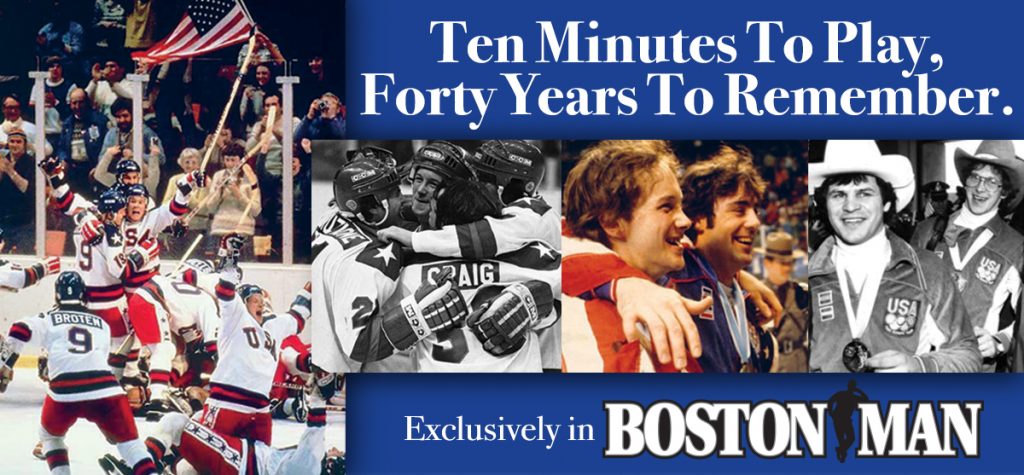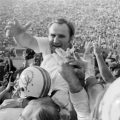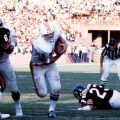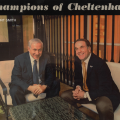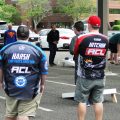Sports

The Miami Dolphins Perfect Season: Undefeated For 50 Years
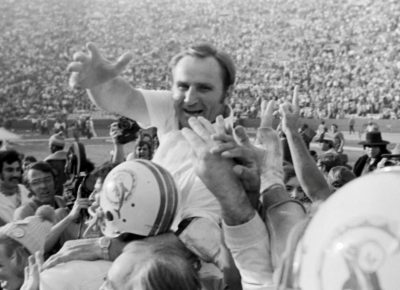
Half a century since the Perfect Season of 1972, no team has put all of the pieces together to match the feat. MiamiMan caught up with Larry Csonka and Manny Fernandez from that destined team, along with coach Don Shula’s son David, to celebrate the 50th anniversary of the achievement. (Here is the article as it appeared in the magazine.)
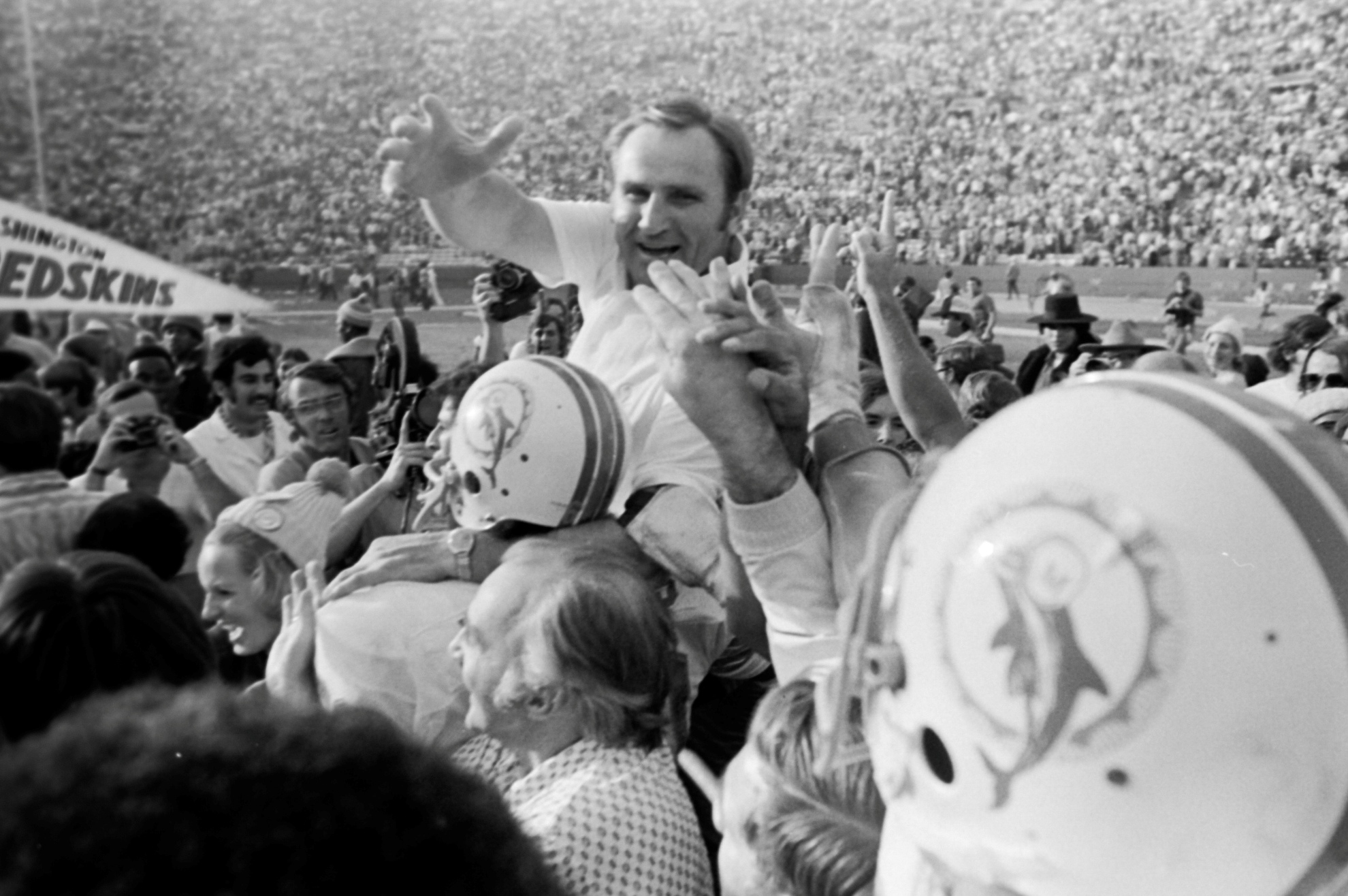
Everyone knew who the best coach was.
(Photo courtesy of the Miami Dolphins)
With the AFC Championship on the line, Larry Seiple defied the winningest coach in NFL history.
The punter for the 1972 Dolphins didn’t receive the signal to run a fake from his coach. He simply saw the hole the Pittsburgh Steelers left open…a hole his grandmother could have run through, he told reporters. Reacting in the moment, Seiple held the ball and ran 37 yards.
Seconds later, a touchdown pass from Earl Morrall to Larry Csonka tied the game. That touchdown turned out to be the difference. The Dolphins won by four points.
There might have been a very good reason Seiple’s coach didn’t signal for a fake. Seiple might not have seen a charging defender. He might have tripped on the play. A Steelers defender might have stripped the ball.
Had it not worked, Seiple is fond of saying, he probably would have walked home from Pittsburgh…because Don Shula wouldn’t have let him on the plane.
But because it worked, because Seiple followed his instinct, the Dolphins became AFC Champions. Because a special teams player thought independently in the heat of the moment, the Dolphins went to the Super Bowl to complete an undefeated season.
Because Larry Seiple stepped up in a clutch moment, the Miami Dolphins of 1972-73 have stood alone to this day as the only team in NFL history to have won every single game of a season.
One clutch play.
As Csonka says, that’s how finite it gets.
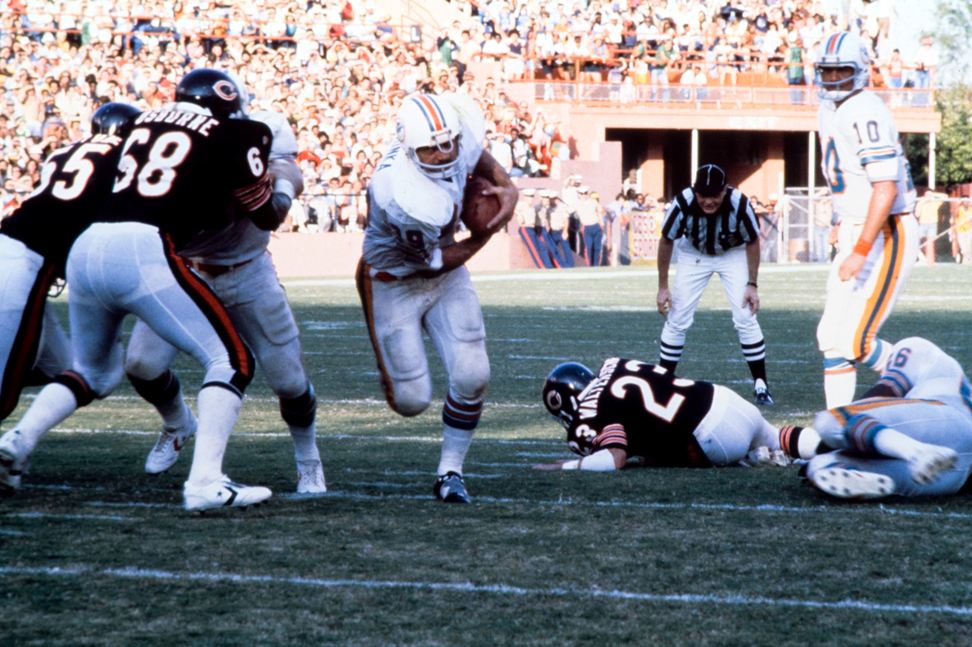
The Dolphins were always happy to give Zonk the ball.
(photo courtesy of the Miami Dolphins)
The point of highlighting Seiple’s moment of defiant intuition isn’t to suggest that a Perfect Season is a result of luck or even Divine Intervention…although a case could be made for a benevolent God smiling on a devout coach who attended Mass on a daily basis.
The point is to underscore the reality that to go an entire season undefeated, a team needs contributions from everyone, and a coach that relentlessly drills the importance of commitment and unity into them.
The 1972 Miami Dolphins weren’t lucky. They were a very, very good team…as any member of the team will be happy to tell you.
“Some people made a small contribution because he only got on the field at a certain time on one play,” Csonka remembers, “and other people made a larger contribution, but the fact of the matter is without all the contributions, you don’t have the Perfect Season.”
David Shula, son of the legendary coach, spent a great deal of time working in the team’s summer training camps as a young lad. He remembers what made their bond special.
“So many great people, not just great football players. You talk about guys like Bob Griese, and Nick Buoniconti, Larry Little, Larry Csonka, you know, Paul Warfield, Howard Twilley, Jake Scott, just tremendous human beings and great members of the community.
“They truly enjoyed being around each other,” he continues. “They wanted to win for each other more than they wanted to win for themselves, and really cared about each other and played for each other as a result.”
Manny Fernandez, one of the many stars of the absurdly nicknamed “No Name Defense”, also doesn’t see the Perfect Season as being luck or destiny.
“It was more everybody, every play, trying to do what they could. Those big plays that turned close games into victories, it was a different player every week coming through, whether it was a Dick Anderson interception or a Charlie Babb blocked punt or me stealing a handoff.
“And then, of course, we did have those games where we just beat them handily.”
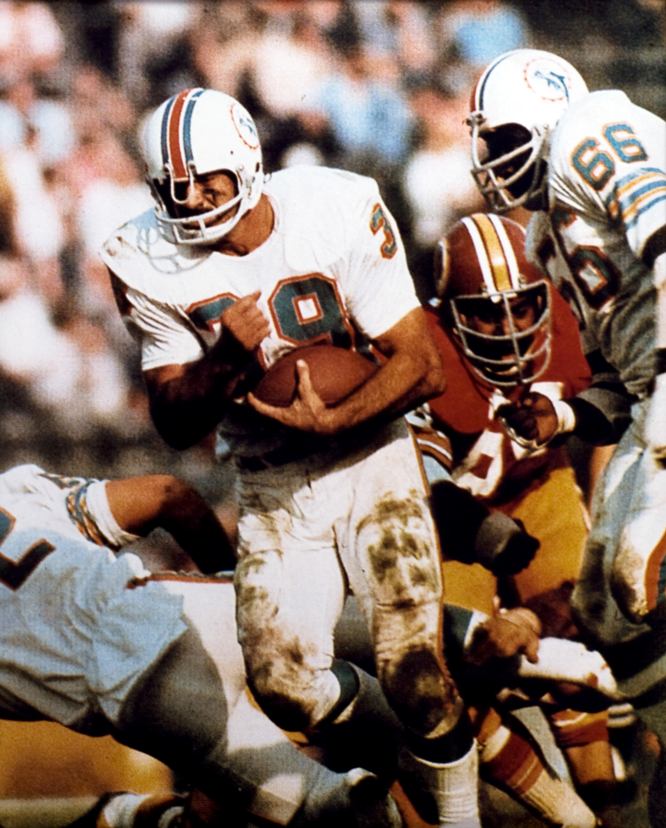
Running with one purpose…revenge.
(photo courtesy of the Miami Dolphins)
There was one key motivation that every Dolphin shared going into the 1972 season…a humiliating 24-3 loss to the Cowboys in the Super Bowl the year before.
Fernandez remembers it all too well.
“Losing the Super Bowl,” he still reflects with a sigh, “is the worst feeling in the world. You work so hard to get there. It’s hard to explain the disappointment.
“I bought 100 tickets for that game for family and friends. A lot of them were at the hotel we were staying at, waiting for us to come back. I had to take a break in the parking lot, just literally sat on the bumper of a car and let the emotions run. I was in tears, I had to compose myself before I could go in and face everybody. I just felt like I’d let my whole family and all my friends down, not to mention the fans in Miami.
“I think to a man we vowed, we weren’t gonna feel that way again next year. No matter how hard Shula pushed us or how hard he worked us, we knew why, we knew where we needed to be, and what we needed to do to get back and redeem ourselves.
“That whole season was redemption.”
Csonka remembers that Coach Shula was emphatic that every game in 1972 was going to be treated like the Super Bowl.
“Had he anticipated that we were going undefeated? No, I don’t think he had any design on that. Just how serious we were going to approach every game, so that by the time we got to the Super Bowl, if in fact we did, we would be ready and know how to prepare. And that part was a prediction and that part did come true.”
The coach, Zonk and Manny both remember, used every edge on the field…including Miami weather.
“He decided that we would practice twice to sometimes four times a day in 90 degree heat,” Csonka recalls, “and we would become camel-like so that we were acclimated to that tropical situation. Any kind of little idiosyncrasies like that, he used those as added gunfire in the battle.”
Fernandez wasn’t always a fan of playing in the intense Miami heat, though.
“You get on that poly turf, and the temperature of the surface would be 120 degrees, and the air you’re breathing is 110. There’s no doubt it gave us an edge, but it also cut into us a little bit as well. There were more times than one I was getting intravenous fluids at halftime to keep from collapsing. It wasn’t always fun with that hot weather.”
Coach Shula demanded a lot, Fernandez says, but “the guys on the team, we respected him and what he was doing, and what it was doing for us.”
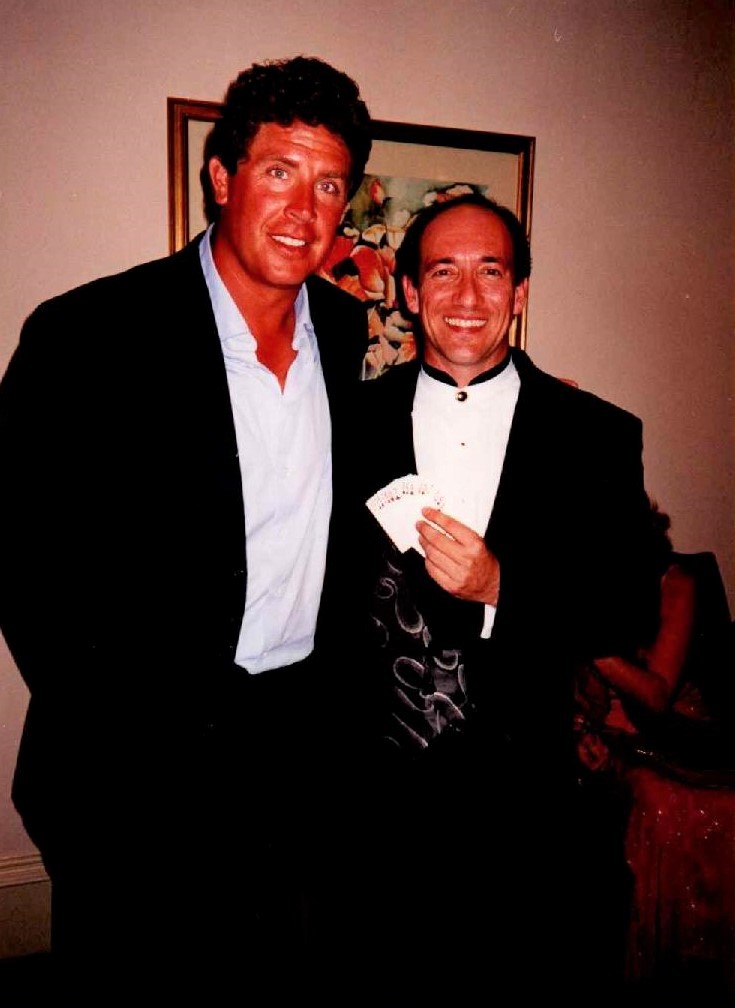
Dan Marino worked his magic to ensure the Dolphins stand alone.
(photo courtesy of Mio Rodriguez)
Perfection, by definition, is impossible to attain for humans. To claim that any achievement is perfect, we have to redefine the meaning of it.
The Miami Dolphins of the 1972-73 season didn’t shut out all of their opponents. Larry Csonka and Mercury Morris didn’t make it to the end zone every time they carried the football. Bob Griese and Earl Morrall didn’t complete every pass they threw. Garo Yepremian’s inexplicable Super Bowl gaffe nearly negated the unprecedented achievements of an entire season.
But within the parameters of a Perfect Season, the Miami Dolphins have set the standard. Seventeen football games, every single one of them ending with a Dolphins victory. The team was as perfect as it needed to be to be called the greatest team in NFL history. Half a century later, no team has been able to meet even that scaled down definition of Perfect.
Two teams have come very close…the 1985 Bears and the 2007 Patriots.
Dan Marino and the Dolphins did their part in turning the 1985 Bears’ campaign into an Almost Perfect Season. Dave Shula was coaching under his father that Monday night at the Orange Bowl. He remembers how electric the atmosphere was, and the strategy they devised to beat a seemingly unbeatable team.
“We had a revolutionary plan that nobody else had tried, and we said, what the hell? Nothing else has worked. Because they were just overpowering people.
“The simple plan was just to put him in the game, Nat Moore, instead of a tight end on first down, and throw the ball. They didn’t substitute and they tried to cover him with Wilbur Marshall, who couldn’t cover Nat Moore. And we put up a big number on them by halftime.
“That was one of the all-time great teams,” Shula remembers with pride, “but they will never be able to say they had the perfect team.”
Of the 2007 Patriots’ campaign that ended with the season’s only loss, Larry Csonka says that he is still the “biggest fan” of Giants head coach Tom Coughlin and quarterback Eli Manning. Even as the unbeaten Patriots were 12-point favorites over the 10-6 Giants in Super Bowl XLII, Mercury Morris could still be seen on TV reminding everyone that “to be undefeated, you got to win every game!”
Manny Fernandez knows better than anyone how the Patriots’ season revived the memories of the Dolphins’ perfect campaign.
“I was actually watching the game with the reporter from the Palm Beach Post. He had come to the house with a cameraman and a sound person, and he was talking to me all through the game and literally putting it on air. Then when the game was over, the local channel that did the Don Shula Show, they sent a crew over to the house at 11 o’clock at night to interview me!”
Dave Shula remembers that his 78-year-old, ultra-competitive to the end father was at the game, and “I remember him saying that he jumped up, and had the smallest measurable vertical jump in the history of vertical jumps.”
Dave worked at Shula’s restaurants for 22 years, and following the improbable Giants victory, “we sent Eli Manning a bunch of gift certificates for he and his offensive linemen to share with their teammates to Shula’s.”
“We’re proud of being the only undefeated team in history,” Fernandez reflects.
“We worked hard to do it.”

Because 50 years ago, a group of guys made Miami a football city.
(photo courtesy of the Miami Dolphins)
It’s impossible to measure what the success of a sports team does for a city, but the 1972 Dolphins gave the Miami community a new point of pride…and it still does today.
Dave Shula remembers his family leaving for Miami from Baltimore when his father was hired away from the Colts. “My classmates had put little paper signs and they hung them in the windows all the way across the classroom that said, basically, ‘Dolphins suck.’”
But the winning coach was most welcome in an area where the only major sports team in the city had only won three games the season before.
“Miami even then being such a melting pot,” his son remembers, “there was nothing that really pulled the people together from the sports scene until the Dolphins in ’70. They started to win, and then continued that in ’71 going to the Super Bowl, and then of course the undefeated season. It really galvanized the community. I remember going to those games as a little guy, how exciting it was going to the Orange Bowl. They were constantly sold out and the fans were just terrific.
“I like to joke that I had a lot of new best friends on Monday morning. I remember a picture that was in the Miami Herald after they won the Super Bowl. There was a whole bunch of people from my school in the background. I think I only recognized one of them, and they were all hugging me like I was their brother. It was funny.”
Csonka remembers a diverse number of age groups in Miami as well as nationalities, who suddenly had a common bond.
“The older ones were enthusiastic fans,” he recalls, “whether they moved down from Buffalo or New England or wherever they moved down from to retire. The young ones, of course, are fired up to be first time champions.
“Those two sections of fans came together as a very, very enthusiastic crowd. If you go back and look in the early 70s when Shula first came, sales and season tickets went up terrifically, and we had sold out situations in the early part of the season in 1970.”
Is Miami represented in all four major sports today without the early 1970s Dolphins proving that the city will very enthusiastically support a winning team?
That’s impossible to answer, but the Rays’ attendance numbers don’t exactly make a strong case to add an NBA team in Tampa Bay. And they were in the World Series not long ago.

Never in American professional football history.
Manny Fernandez reminded this scribe that it isn’t just the 50 years since that hasn’t produced an unbeaten and untied team. It hasn’t been done by any other team in the 103-year history of the NFL, even when seasons were only eight games long.
Yes, the Dolphins caught some breaks and won games that turned on a single play. And Dan Marino and Eli Manning both played a vital role in keeping the most astounding team achievement in NFL history unmatched in 50 years and counting. Every team that climbs the highest of mountains benefits from some luck.
But in the grand scheme of things, what made the Perfect Season possible was a team full of outstanding players, a brilliant and uncompromising coach, and a truly unified dedication to victory on the part of everyone involved…right down to a punter who was willing to go against his coach and be willing to walk 1,181 miles if it went bad.
A Perfect Season doesn’t turn on one big play. It’s the sum of all of its parts, every player, every play.
As the Miami Dolphins of 1972-73 all know, it’s better to be good than lucky.
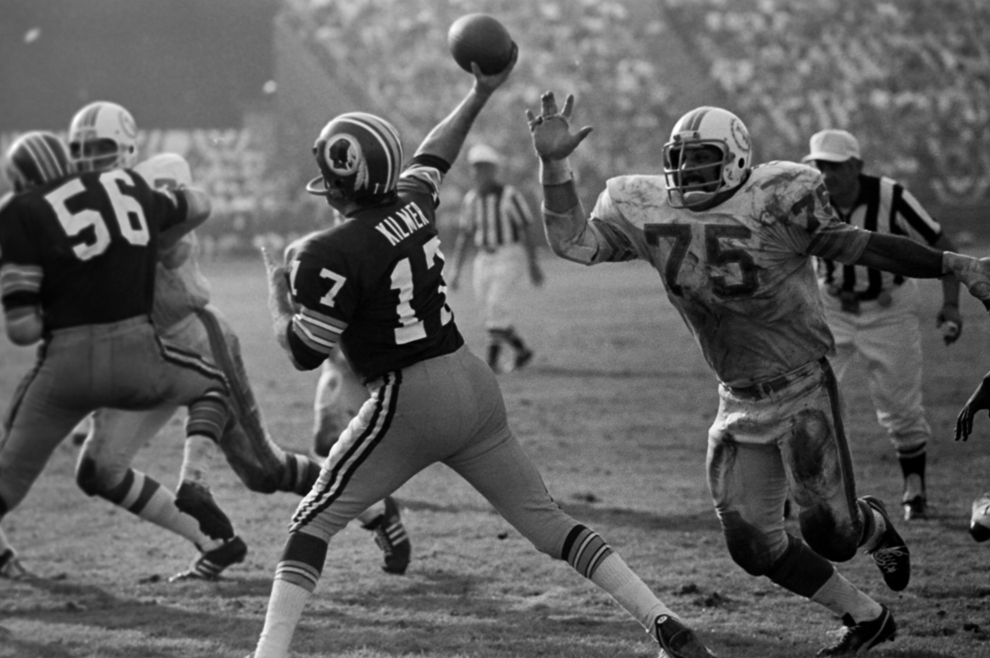
It was never long before Manny was on you.
(photo courtesy of the Miami Dolphins)
Manny Being Manny
Cowboys coach Tom Landry is often credited with the “No Name Defense” appellation given to the 1972 Dolphins defense…a squad that featured Nick Buoniconti, Manny Fernandez, Bill Stanfill, Jake Scott and several others. They led the NFL in fewest points allowed in 1972, and also held Billy Kilmer and the Redskins offense scoreless in the Super Bowl. (Washington’s only touchdown came on a special teams play, famously known as “Garo’s Gaffe”.)
In that game, Manny Fernandez made quite the name for himself, with 11 tackles, six assists and a sack…but the Super Bowl MVP award would go to Jake Scott. Csonka and Buoniconti took issue with the award, believing Scott and Fernandez should have both gotten game balls.
But when asked about the snub, Fernandez says with a chuckle, “We won, didn’t we?”
“I was there to win the game, not get a trophy.”
It turns out he didn’t remember a lot about the end of the game, even at the time. He doesn’t tell the story often, but Manny sustained a head injury late in the game.
“I received a concussion right about either the end of the third quarter or the beginning of the fourth quarter. It was a swing pass to Larry Brown. I made the tackle, got him by the jersey, swung him around, and as we swung down to the ground, Nick came in to finish him off and got me right in the temple.
“I played out the game, but I don’t remember any of it. I don’t remember that night, the celebration. Woke up in the morning, I had to ask my wife if we won.”
It’s easy to call Fernandez a big game player…his Super Bowl totals include three sacks and 28 tackles in three appearances on football’s biggest stage. But as Dolphins fans knew, those types of performances were just Manny being Manny.
Fernandez recorded 35 sacks in his eight year career, with 4 1/2 sacks in the postseason. He was a second team All-Pro twice, a second team All-AFC selection twice, and an All-AFC selection once. The Dolphins wouldn’t likely have won back to back Super Bowls without Manny Fernandez pummeling offensive linemen…and his desire made him a perfect fit for Don Shula’s design of a championship team.
“I came into Miami as an undrafted free agent, more or less an afterthought. The entire first week, I did not practice one play. Did all the warmups, did all the work on the machines, the tackling dummies, did all the dummy stuff. I never got on the field until Friday morning.
“Jim Urbanek, number one draft pick, defensive tackle, blew his knee. They put in another number five draft pick from Alabama, and he blew his knee. Coach (Les) Bingaman, our defensive line coach, came over and said, any of you think you can play this game?
“I just looked at him, I said, you’re g**damn right if you give me a chance. He said, okay, Mexican, see what you can do. I went into that scrimmage, bound and determined that I was going to make a name for myself. I was going to make that football team. And I did.
“I started every game from then on.”

Three true team players.
(photo courtesy of the Miami Dolphins)
The Interchangeable Backfield
There are many stories of members of this team being willing to sacrifice their own personal achievements for the team, but the best example is easily Jim Kiick and Mercury Morris, who split running back duties throughout the season…Kiick as more of a blocking back for Csonka, and Morris as more of a runner who could get to the outside fast.
The younger Shula cites his father’s handling of the Kiick and Morris situation as an example of how the coach set the tone of playing for the team first.
“The story goes that either Jim or Mercury would be in my Dad’s office on Monday, and it was the one that didn’t get to play much the day before. He knew that they needed to vent their frustration because of their competitiveness.
Dave Shula speaks not just as Don Shula’s son, but as a former NFL coach himself. “It’s hard to do that, to keep your star players that aren’t getting the ball as much as they think they should, to keep them content and keep them working toward the goal of helping the team win.”
Csonka remembers the camaraderie between Kiick and Morris, even as the few shared the spotlight in the Miami backfield.
“You’d see Jim run off the field, Merc would be running on, and they’d smack hands as they passed each other. Jim only ever bitched one time. We were close to our own end zone, and it was a 40-yard sprint with the bench, and he didn’t like that part. He didn’t want to run 40 yards to the bench and 40 yards back!”
Csonka remembers the moment with a laugh, but as a Hall of Famer who played for winning and losing teams in his career, he knows how it could have turned out had Kiick or Morris not been on board.
“If you don’t have that,” Zonk says of the two players’ mutual respect, “if you have animosity that builds, it’s like a cancer on the team. It’ll start between two players, and it’ll carve up the team before it’s over.
“But Shula made such a strong case of everyone being disciplined to the fact that winning became more important than personalities or number of carries or any of those other things.”

“Get ready to shed your placeholder status, Earl.”
(photo courtesy of the Miami Dolphins)
“Weak Schedule” vs. “Backup Quarterback”
It’s been noted by sportswriters and non-Dolphins fans that the 1972 Dolphins benefited from a weak schedule, and the claim isn’t entirely without merit…only two of the teams the Dolphins defeated during the season had winning records.
But if someone brings that argument up with you, remind them that the Dolphins also lost their Hall of Fame quarterback in the fifth game of the season, and proceeded to win nine games and a playoff game with a backup quarterback. It’s doubtful the 2007 Patriots could have pulled that one off.
Backup QB Earl Morrall is one of the 1972 Dolphins’ biggest heroes. Following Bob Griese’s ankle injury, Morrall took over and kept the train rolling. He threw for 1,360 yards and 11 touchdowns in nine games, and then led the team to a victory in the Divisional Round playoff game against the Browns.
But most importantly, after bringing the Dolphins to the dance, in the AFC Championship game Morrall went back to the bench and let Griese finish the job without complaining. Like everyone else on the team, he had made his vital contribution to the Perfect Season.
In his book, The Winning Edge, Don Shula tells the story of convincing Dolphins owner Joe Robbie to pick up Morrall to back up Griese. Morrall had been the backup for Johnny Unitas and had performed a similar feat in Baltimore, leading the Colts…coached by Shula…to a Super Bowl as a backup before their infamous loss to the Jets in Super Bowl III.
The Dolphins, being the AFC champions at the time, had the second to last chance to claim Morrall when the Colts placed him on waivers, but the rest of the NFL passed on a backup QB who would make history starting and winning nine games of a Perfect Season.
Shula recalled the moment when he decided to switch back to Griese to start the second half of the AFC Championship game against the Steelers.
“What I had to tell him was hard. He had done the job all season long and I was appreciative beyond words. But I had to do what was best for the team.”
In the brief conversation they had, Morrall immediately accepted the decision and informed Shula, “If you need me I’ll be ready.”
If anyone exemplifies what it takes for a team to achieve a Perfect Season, it’s Earl Morrall. Who was Tom Brady’s backup in 2007 again?

Eagles Tailgating: The Greatest Party in Greater Philadelphia
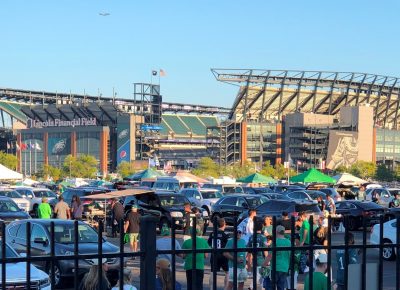
There is no gathering anywhere in the region like an Eagles tailgate. (Published for the Fall 2023 issue of PhillyMan…see the magazine article here.)

Most of the thousands clad in green at the party on Pattison probably don’t even realize it, but there is a truly special element to being in the parking lot on Eagles game day.
It’s that no matter your political persuasion, your religious denomination, your ancestral roots or your musical taste, you have something in common with the stranger next to you. In the parking lots surrounding Lincoln Financial Field on game day, everyone bleeds green and shows their commitment. On Game Day, the Birds are the only thing that matters to anyone.
Tailgating, at first glance, seems an alternative to paying the eternally brazen “atmosphere fee” for food and libations inside a sports venue. But when the party encompasses more than a square mile and looks like this, its purpose goes well beyond thrift. To call an Eagles tailgate a party, to even call it a celebration, is a rank understatement.
Throughout the lots at the home of the Eagles, including those meant for other teams who happen to play here, you can walk in any direction and see buses, campers, trucks and vans…the majority of them covered with artwork that would provoke a double take on the highway. It gives one pause to consider how much of a fan one must be to shell out the kind of coin needed to decorate a vehicle so magnificently.

After a long day of painting a bus, it’s time for a drink.
Everywhere in this mammoth block party, one hears loud music from a variety of styles and eras. Everywhere, you can smell coal, sausages, burgers, and yes, frequent whiffs of reefer. And anywhere you happen to be, you won’t often go five minutes without hearing an Eagles cheer…usually begun by one person, which easily gets at least a dozen more to join in.
If you’ve never been a part of tailgating at this level, you’ll be truly amazed at the dedication of a large number of participants. The seasoned pros arrive early…as much as six to eight hours before game time. (Do the math of how early you’d have to get out of bed, on a cold November Sunday morning, to tailgate for a 1:00 game.)
Veterans of Eagles tailgating even have their designated parking spots, that they head directly to when the gates open…for various reasons, such as being near a grate that can be used as a bathroom. True.
You can easily spot the amateurs…the late arrivals. They spend far too much time in an agonizingly slow quest…not only to find an open spot, but to work their way into it as carefully as possible to avoid gazebos, coolers, and equipment that other tailgaters have established hours before.
Hopefully they’ve learned their lesson from the experience…you need to take this party a heretofore unheard of other level of seriously.
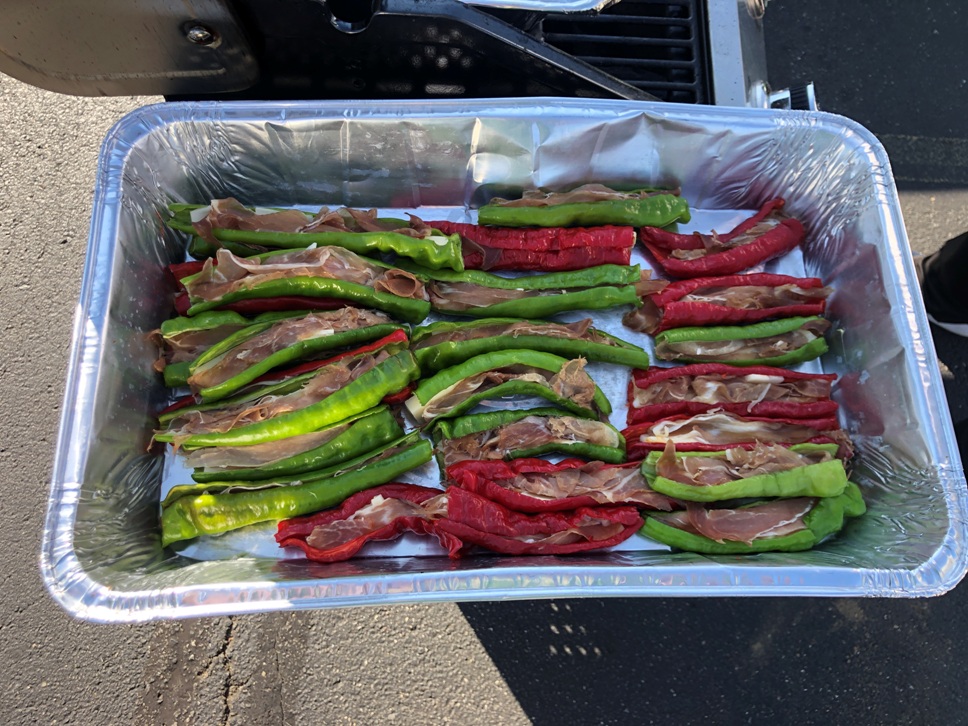
Dan Kukral’s stuffed long hots are reason enough to be part of the Danny Burke tailgate on game day.
Dan Kukral is the head chef of the Danny Burke tailgate, named for his brother-in-law who runs much of the party. He was given the chef’s role, he says, because “I come up with all the fun ideas for food.”
Kukral is a research scientist at a pharmaceutical company, which is remarkable given what you’re about to read about his contribution to game day.
He and Burke usually begin the party preparation about five to six days before game day (yes, you read that right). Once they’ve gathered food and supplies for a party that can be for as many as 200-300 people and brought it all to the Linc, he takes on the sizable cooking duties.
Needless to say, it’s a lot for one guy. Kukral simultaneously looks after the preparation of ribs, pulled pork, shrimp and sausage bayou, Buffalo chicken dip, and of course, dogs, burgers, wings, sausages with peppers and onions…even long hots with stuffed provolone and prosciutto. As anyone can easily see from the hefty, mouth-watering piles of grub, he’s more than up to the challenge.
It’s all a labor of love, he says. No kidding…a system as efficient as this doesn’t happen casually. The Danny Burke folks get contributions from participants, which covers the food and drink, but he doesn’t get paid for his more than considerable efforts.
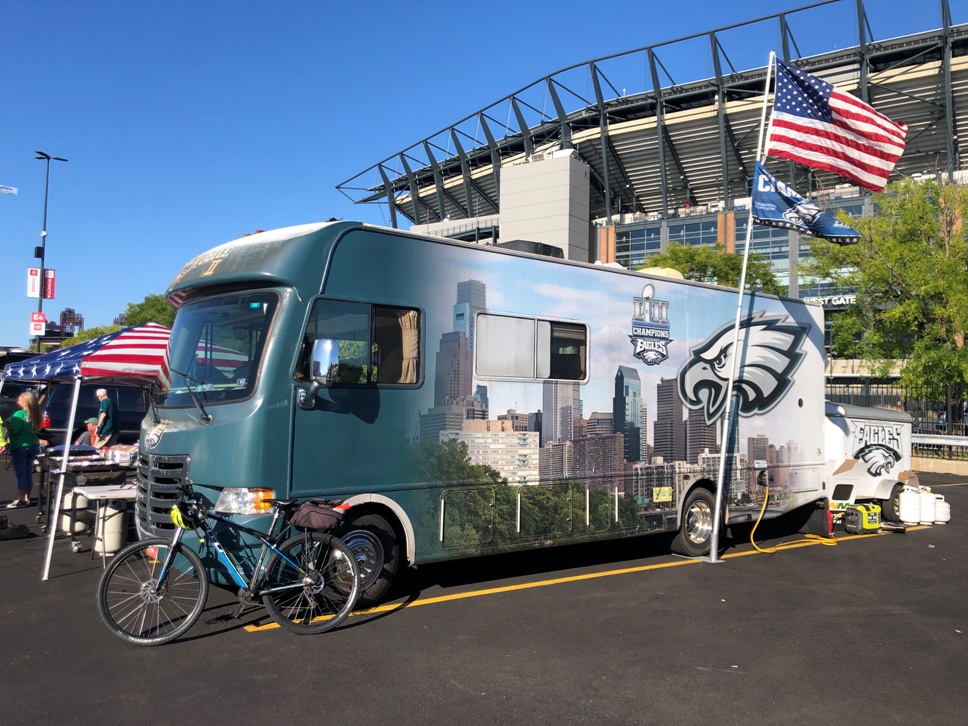
If you think this pain job is impressive, check out the back.
Kukral is just one of many for whom Eagles fandom is a passion worth the investment of time and money.
This observer also spoke with Ed Callahan, whose camper has occupied a spot in the Wells Fargo Center lot since the opening of Lincoln Financial Field. Ed tells an amusing story of why he and his crew acquired a camper.
“In 2004,” he recalls, “I went to a road trip game in Cleveland. There were four of us, and we parked in the lot next to a beat-up old RV. For a swap of a cheesesteak, the guy who owned the RV let us use the bathroom.”
An even trade, certainly. But bringing a bathroom to a tailgate, they realized, was a super idea, for obvious reasons.

“I’ll knock the loyalty to Kathie Lee right out of you!!”
Ed and his crew bought an old RV, fixed it up, and made it a staple of the parking lot. They eventually had to replace it following a wreck, so they’ve upgraded to a new one.
Callahan’s current camper is a thing of beauty to behold for a Philadelphia football fan, and it might be the most artfully decorated vehicle at the Eagles tailgate…which is undeniably saying something. The back of the RV is adorned with a large scale timeless image of Frank Gifford lying motionless on the field, following the epic Chuck Bednarik hit. On the side is a wide panorama skyline shot of our city, ranging from 30th Street Station to Billy Penn’s statue.
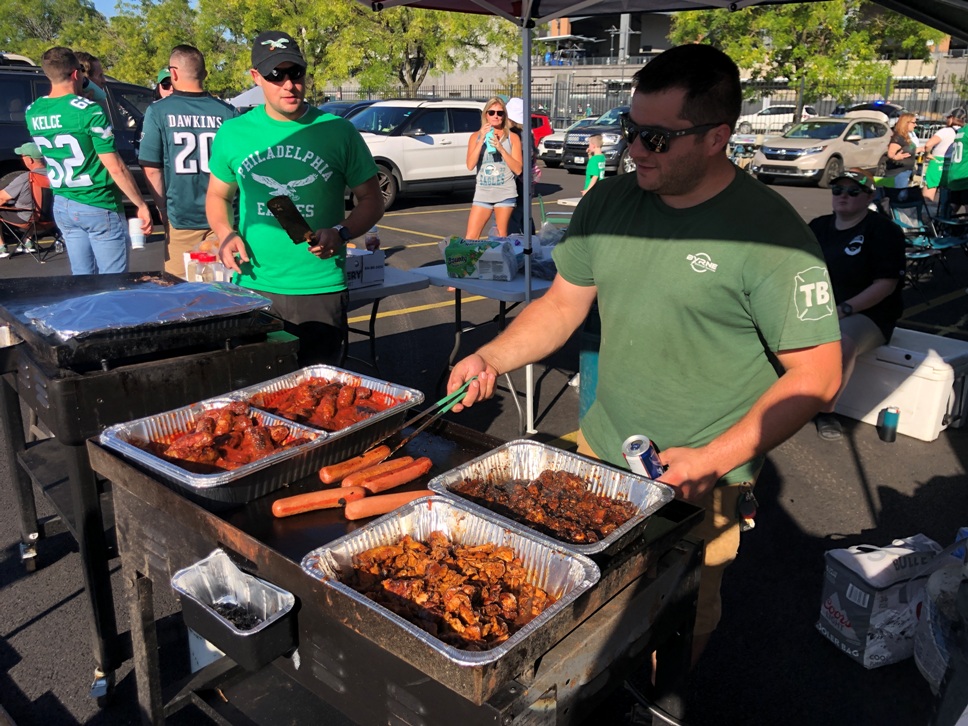
Anthony is the right man for the job.
The cook of Callahan’s crew is a gentleman named Anthony. Anthony is definitely keeping busy looking after sausages and other comestibles. He estimates that their party serves anywhere from 30-100 fans each home game.
Executing a successful tailgate, Anthony says, is a full-time job. “All week, getting food together, cleaning the RV, getting all the grills, utensils, tables, and all that. It’s a full day…breakfast, lunch and dinner in the parking lot.”
Ed says their breakfast specialty is an Irish American Philly Omelet… made with imported Kerrygold cheese from Ireland, Cooper brand American cheese, and Philadelphia cream cheese, all in a three egg concoction.
There might be a few NFL cities that are in Philadelphia’s universe when it comes to the magnitude of the pre-game party. But there is one thing that The City of Brotherly Love offers that is unique: cheesesteaks, scrapple and pork roll.
Buffalo can keep their wings, December weather, and four straight Bowl defeats.

These people need a lot of stuff.
To witness football fan dedication of this level brings to mind a whole world of entrepreneurial opportunities for local businesses. Incidentally, our friends at Duck Donuts realized this…on the day this article was written, the author received an email with a subject line that read: “Win The Tailgate With Donuts!” They get it.
Sure, for liquor stores, sandwich shops and food markets in the area, it’s obvious. Put it in your promotional materials that you offer everything Eagles fans need for Game Day…cases of beer, large bottles of liquor and mixers. Ready-made subs and pizzas, bulk packages of burgers, sausages, chips, dips, and rolls.
But that’s just scratching the surface. A party this size needs it all.

“Say, who painted your RV?”
An owner of an RV dealership can add a bar and lounge to the inside of a used camper to make a sale to a dedicated Eagles supporter. Vehicle wrapping and decorating outfits could market their wares to fanatics that buy multiple spots at considerable cost for their RV.
Needless to say, anyone selling Eagles gear could market to the block party…most all of whom represent their team faithfully with jerseys, caps, face paint or any kind of accessories featuring the Eagles logo and colors.
Outdoor stores could make a serious profit too. Grills, propane tanks, coolers, generators, portable toilets, anything associated with RV adventures might be applicable to a tailgating demographic. Space heaters and fuel would undoubtedly be in big demand in the colder months. Decorating anything with the Eagles colors and logo could make the sale to the typical Linc lot enthusiast.
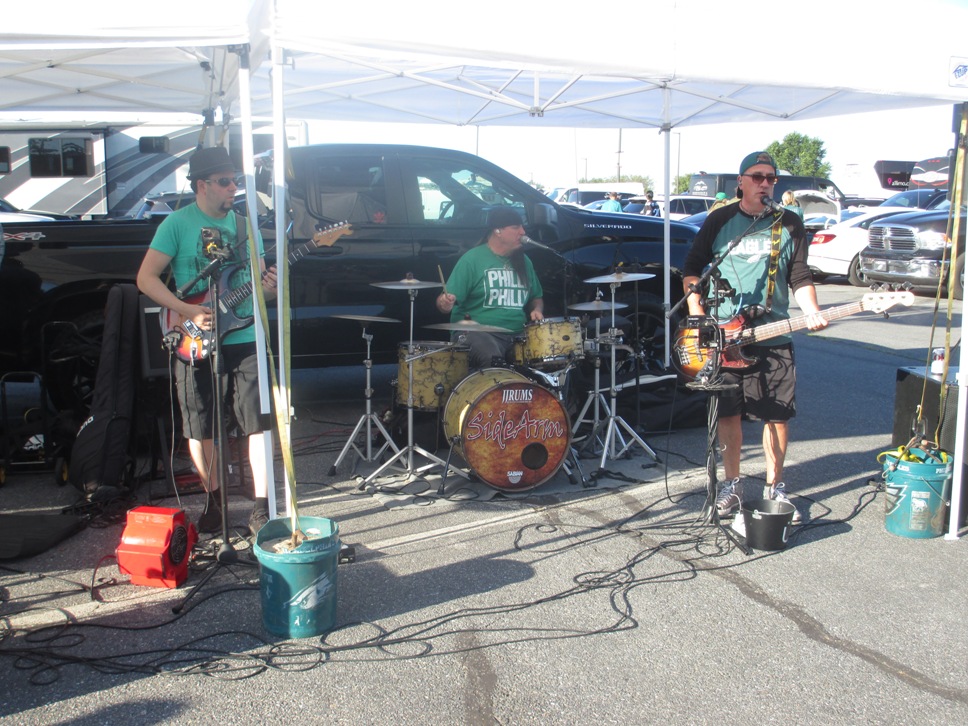
This band was playing Van Halen’s “Unchained”, and the guitar player handled himself quite well. It’s no place for amateurs.
It’s even an opportunity for catering services, private event coordinators, DJs, even live musicians, all of which you can easily find at an Eagles tailgate.
If nothing else, fly a plane towing a banner over it all for the thousands in the lot to see…which also happens frequently.
You get the idea, but even if you’re a realtor or a financial advisor, there’s no reason why you can’t build goodwill by renting a camper, hosting a game day party and inviting your customers, as one business owner (who asked for her name not to be shared) does.
No doubt, your Eagles fan patrons will speak well of you.
Because after all, you’re family.

As seen on the movie screen!
As Seen In The Movies: The Silver Linings Playbook Eagles Bus
If you’ve ever seen the movie Silver Linings Playbook…and if you’re a Philadelphian, you should…you likely remember the scene where the Eagles-decorated “Asian Invasion” bus shows up in the Linc’s parking lot on game day.
In the scene, protagonist Pat Solitano Jr., has just been released from a mental health facility for bipolar disorder. At the game, he notices that his therapist, Dr. Cliff Patel, has emerged from the bus.
He catches up with Patel…whose face is painted green and silver…and Patel dispels any concerns about their meeting outside of the facility: “Today, I’m your brother in green, not your therapist.” Soon, the two have a discussion with Pat’s friend about what the Eagles strategy for the game should be, punctuated with hilarious foul language.
After the movie was made, no one really knew what to do with the bus, and so a movie hand decided to sell it on Craigslist.
Bill Curley, a long, long time veteran of Eagles tailgates, went for it, and today the Asian Invasion bus is parked in the Wells Fargo lot for every Eagles home game.
“One of the people working on the movie ended up with the bus, and nobody wanted it,” Curley remembers. “The Inquirer wrote an article about how the bus was for sale prior to the Super Bowl. Once they won it, I called the guy on the phone and said, ‘hey is the bus for sale?’ and he said yes.”

The author of A Great Number of Things enjoys some time in the Asian Invasion bus.
Curley bought the bus for $9,000 in 2017. He estimates that he’s put a total of $30,000 into the investment. The bus is comfortably remodeled inside, with cushioned benches and Eagles decorated chairs, offering a spot to escape weather that can be trying in this part of the world any time of year.
“I come here early and park right here at the end, so people can take pictures. It attracts people from all over the country, I’ve had several people from Canada. A lot of ‘this is my first game, I’m from Utah, it was a birthday gift,’ they come and introduce themselves. It’s a neat thing.”
He still gets into the party, showing up early, saving spots for family and friends, and cooking sausage and peppers for whoever shows up. He was at the Linc at 11:30 AM for the Thursday evening home opener. “It starts early and it ends late,” he laughs. “My daughter’s coming today with her friends.
“This isn’t the most comfortable thing to drive in traffic, so I leave early.”
If you’d like to see the movie scene, you can search for “Silver Lining Playbook Eagles Tailgate Scene” on YouTube. And the next time you’re at an Eagles home game, check out the Asian Invasion bus…it’s well worth a look.
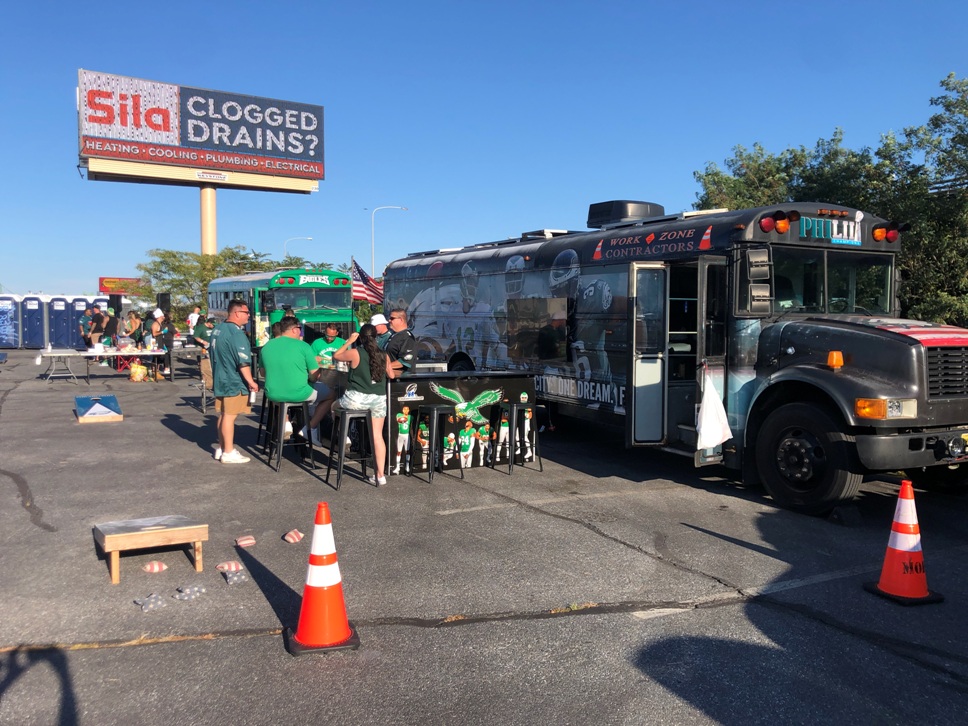
They mean it in the Jetro lot.
The Jetro Lot
While the Eagles tailgating scene is a thing to behold throughout all of the parking lots, some lots are at a different level of enthusiasm than others, and the parking lots at the Jetro Warehouse east of the Linc are undoubtedly the wildest.
To Philadelphians, the name “Jetro” is probably more known for what takes place in their parking lots than for what they do…they are a wholesale restaurant supplier, selling catering supplies and food preparation equipment to caterers and restaurant owners throughout the region.
But it’s likely that their most important…and maybe profitable…contribution to the city is their ample amount of parking spaces in the Sports Complex. The Jetro folks are, needless to say, aware of this, and they even have Facebook and Twitter pages dedicated expressly to their parking offerings for Philly sports events.
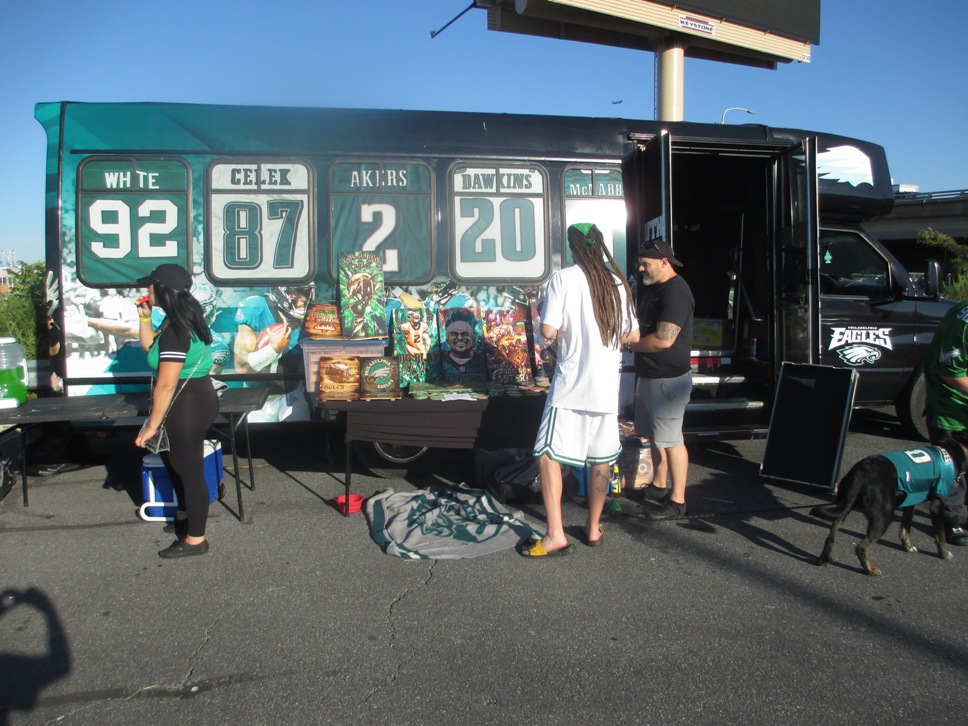
The art stylings of Jonathan Metz.
The most serious of Philly tailgaters seem to congregate at Jetro. In this observer’s visit, just a small sampling of things to see were a large number of beautifully decorated buses, a gentleman by the name of Jonathan Metz selling superbly Eagles-themed woodworks, coasters and other items, and a live band whose guitar player could mimic Eddie Van Halen’s licks quite well. That’s a ridiculously small sample, but magazines have space limits.
Jetro’s lot isn’t a place where you’d want to bring the kids or your church group. It’s loud and raucous, with music that often features lyrics full of f-bombs. There’s also a few flags that are openly critical of the current occupant of the White House, and not in a polite way.
But if you can handle that, and you truly want to show your Eagles fan dedication, the Jetro lot is likely the destination for you. It’s well worth a visit, if only just to see the level of fandom the local football team inspires.

Ten Minutes to Play, Forty Years to Remember

My article celebrating the 40th anniversary of the Miracle On Ice was originally published in the Winter 2020 issue of BostonMan Magazine. Click here to see a PDF of the article, or click here to see the article on BostonMan’s website. I’m very proud of this one, hope you enjoy it.
Ten Minutes to Play, Forty Years to Remember
February 22 marks the 40th Anniversary of the Miracle On Ice, still today regarded among the greatest, if not the greatest moment in sports history. BostonMan caught up with three key players from Team USA…Boston University alumni Jim Craig, Jack O’Callahan, and Mike Eruzione…to talk about the achievement and its aftermath.
The puck rose off Mike Eruzione’s stick and soared past Vladimir Myshkin’s outstretched pad. An arena full of 8,500 fans, along with a newly inspired nation, erupted.
For the first time, in this game and against this team, the U.S.A. was ahead. With exactly 10:00 on the clock.
Ten minutes. Against a team capable of six goals in that kind of hockey eternity.
The players wearing red, for maybe the first time in their lives, were rattled. They missed shots. They missed passes. They missed opportunities.
But this was still the Soviet Union team, arguably the greatest hockey team ever assembled. This team didn’t often go half a period without putting a puck in the net. The score, and the momentum, could change on a dime.
And they had ten whole minutes to correct this aberration, this trailing of a nation that wasn’t known for producing world class hockey players.
Forward Rob McClanahan, in his diary later published in Goal magazine, would call it the longest ten minutes of his life.
“We’re like, oh my God, that’s a long time against these guys,” defenseman Jack O’Callahan remembers.
Ten minutes from immortality. Survive these ten minutes, and you will someday be symbolically credited with taking down an Empire, armed only with a hockey stick.
Hold off the Reds for ten minutes, and forty years from now, the eyes of strangers from sea to shining sea will still tear up in emotion when they meet you.
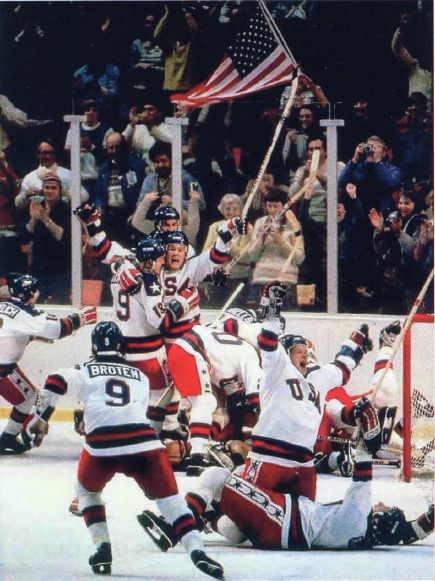
Celebrating a Miracle.
Unlike everyone else on Planet Earth, Herb Brooks was not shocked.
He built this team for this moment. He expected them to be here. From behind the bench, he brought a wave of calm to a heart-stopping situation, repeating three simple words:
Play. Your. Game.
Do what got you here. This is no fluke. You’re ahead in this game for a reason.
Indeed, as O’Callahan, goaltender Jim Craig, and team captain Mike Eruzione can tell you, they spent months preparing…mentally, emotionally and physically…to play ten third period minutes of inspired, fearless hockey against the greatest team in the world.
“Most teams,” Craig reflects, “once they got ahead of the Russians, did a prevent defense type thing. And the Russians crushed it all the time. But we didn’t. My strategy at that time was, don’t tie the puck up, don’t give them a chance to regroup, keep it going.”
Eruzione agrees. “In the last ten minutes, the Soviets had I think, seven or six shots on goal and three of them were from outside the blue line. As Robbie said, it was a long ten minutes, but boy, we played really well in those ten minutes.
“We had great team speed, great conditioning, our conditioning was off the charts. And you get solid goaltending like we had from Jimmy, and now you’re in every game that you can play.”
“We won every third period,” Craig correctly recalls.
This was no aberration. These boys really were exceptional hockey players, who paid their dues through months of backbreaking training, under a single-minded coach.
“The bar was so high, you had to do everything you could just to stay close to the bar,” O’Callahan remembers, “and every time you get close to the bar, Herbie would raise the damn thing.”
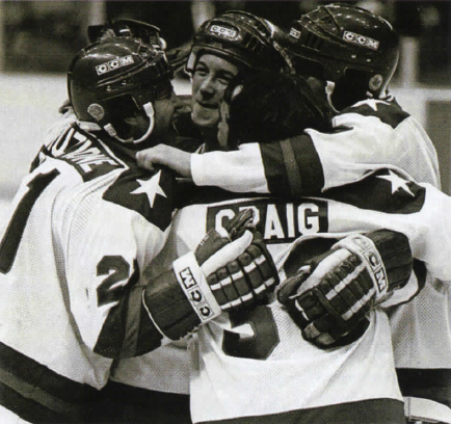
O’Callahan, Craig and gold medal teammates.
Not everything in Disney’s outstanding Miracle film is completely accurate, although the players will tell you it’s generally on point.
One deviation from reality is its much more sympathetic portrait of a coach who was about as sentimental as a kick in the groin. O’Callahan remembers a teammate (Phil Verchota, he believes) saying, “Boy, they really softened Herb up for the movie.”
“Yeah, he was a lot friendlier in the movie,” Eruzione agrees. “Herb didn’t care if you liked him, and there were a lot of times we didn’t like him. But it was important that we respected him, and there never was once a time when we didn’t respect him. Here’s the option, you deal with it or you quit.”
Like his teammates, Eruzione lived in perpetual fear of being kicked off the Olympic team. It was, they agree, one of Brooks’s favorite motivational tools.
O’Callahan says that “even Mark Johnson, who was our best player, leading scorer…Mark would probably tell you that even he wasn’t sure. Herb was like, if you don’t want to work hard at this and you don’t think you need it, fine. I got 200 other guys that want your spot on this team.”
Craig says the movie conversation where Brooks informs him that he’ll be replaced with Steve Janaszak didn’t happen, but it could have.
“It made sense, because if that was a way to motivate someone, Herb would do it.”
Through intense psychology and conditioning, Brooks assembled a team of players that would…and could…step up their game in response to fear. It was essential, especially if they were up a goal against the Soviets with ten minutes to play.
“You always hear the stories that Herb wasn’t looking for the best guys, he was looking for the right guys,” Craig says. “Every one of the players that were on our team had a makeup of what I call a winning underdog.”

Jack O’Callahan and Jim Craig, wearing the American flag and the gold.
Yes, an irate Herb Brooks did make his team skate following a tie with Norway, unlit arena and all. The actual event didn’t mercifully end with Mike Eruzione shouting, with every last ounce of his remaining energy, “I play for the United States of America!”
Eruzione sometimes tells people that it did, because he doesn’t like to disappoint them. But in reality, the drill lasted close to 90 minutes, and as Eruzione jokes, “it wouldn’t have taken me an hour and a half to figure that out.”
He does remember that Brooks successfully made the point.
“We did waves of five guys at a time, and we did them for about 15 minutes; he blew the whistle and we stretched, and then he blew the whistle and we did them again. Mark Johnson smashed a stick against the glass, throughout the skate a lot of guys were doing that. And Herb said, ‘If I hear another g***damn stick break against the glass, you’ll skate till you die!’
“We did a few more, he brought us in the locker room and he said, ‘If you play this way again tomorrow, you’re going to skate again.’ We beat Norway the next night 8-0.”
O’Callahan had several discussions with Miracle director Gavin O’Connor about the script. He recalls that O’Connor learned about skating in darkness almost in passing from O’Callahan.
“None of that was in the movie,” O’Callahan says. “It wasn’t in the script, so I told him about it. He goes, ‘How the f*** is that not in the script?’ He’s like, that’s gotta be in the movie. I said yeah, it was a pretty big watershed moment for our team.
“I have a picture of Herbie standing there holding a whip from 1980. All that stuff then ends up in the movie.”
“Herbie never settled, and it was non-negotiable,” O’Callahan says of their hard-boiled but visionary coach. He gives Brooks credit for revolutionizing North American hockey.
“He was like, I am going to do this differently because I think this is the only way we can win. And he was the only one who thought that at the beginning. Everyone in the world was like, not a chance, this guy’s nuts.”
Brooks, who we sadly lost in a car accident in 2003, is said to have cried following the Soviet game. But he quickly shook it off. There would be no ‘Whatever happens, I’m proud of you’ speech before Finland.
Just the opposite. He informed his team that they would take a loss to their “f***ing graves.”
Magazines have space limitations, but the contest against Finland shouldn’t be overlooked. The Finns weren’t pushovers, and led 2-1 after two periods.
But on strengthened legs from a long post-game skate weeks earlier, the U.S. scored three goals in the third and took the gold.

Mike Eruzione and Jack O’Callahan, two hockey players who would never have to pay for a meal again.
Ten years later, Roger Waters of Pink Floyd would perform The Wall at the remains of the Berlin Wall. On Christmas Day 1991, the Soviet flag was lowered from the Kremlin for the last time. Today the Soviet Empire is an increasingly distant memory. The 1980 U.S. hockey team is not. In the four decades since, O’Callahan, Eruzione and Craig still experience gratitude for ‘beating those Commie b***ards’.
Jack O’Callahan was an American history major at Boston U., and he spent a great deal of time explaining the giant disconnect in America in 1980, especially between generations, to O’Connor for the film. Much of that appears in the movie’s opening scenes.
He now lives in Jacksonville and is a senior managing director at Ziegler Capital Management, a firm based in Chicago where he played six seasons as a Blackhawk.
He hasn’t, he says, had a single negative conversation in 40 years.
“I would say the most prevalent messaging for me…predominantly the discussion is about family. It was all about, ‘I remember watching that, I didn’t think my dad knew how to cry and I remember seeing him bawling his eyes out. You know, he was a 45 year old Korean war vet, crying his eyes out over a fricking hockey game.’”
Mike Eruzione works for Boston University and still lives in Winthrop. He and his wife founded Winthrop Charities, supporting local families and causes. His coming book, The Making of A Miracle, was written for one reason, he says. It’s so his grandchildren know that he did more in his life than play hockey for two weeks in Lake Placid.
But Rizzo understands that he’ll forever be known for those two weeks.
“For 40 years, I come across people all the time and there’s a smile on their face. Or sometimes I’ve had people come up to me and start crying, because the moment meant that much to them. I must have sent out 15 or 20 pictures today to kids, you know, ‘I wasn’t born in 1980 but I saw the movie, my grandfather and my aunt and uncle told me about it, can you send me an autographed picture?’
“I live in Boston and I root for the Patriots; a lot of people don’t like the Patriots. But when it’s the Olympic games, it’s a nation that feels a part of it.”
Jim Craig has also written a new book, titled We Win: Lessons On Life, Business and Building Your Miracle Team. His group, Gold Medal Strategies, assists businesses in motivational training. The book, he says, explains that Lake Placid wasn’t a miracle and why.
Craig treasures having become friends with Bobby Orr after idolizing him as a kid. Today, he tells the story of being idolized by a young Dave Grohl, leader of one of music’s biggest acts.
“As our team was going to light the cauldron at Salt Lake City, he was there as a performer. He called me up and we got a chance to talk. He was really, really excited. So here’s this guy from the Foo Fighters, as we’re talking to him, he goes to me, ‘Jimmy, I’m going to sing a song. I’m going to dedicate this song to you.’
“And it’s ‘My Hero’. So that song became obviously my favorite.”
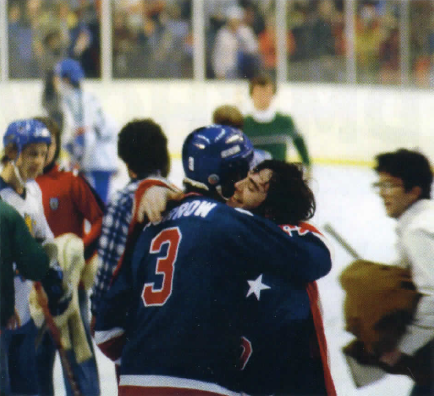
Jim Craig with defenseman Ken Morrow.
Jim Craig doesn’t think the gold medal is the best thing that’s ever happened to him. That sounds astonishing, but given his explanation, it isn’t surprising at all.
“I always tell people, don’t ever let your memories be bigger than your dreams. It’s like, Michael says nothing could have topped that. To me, that would be really boring if nothing could have topped that.
“This year we had our granddaughter Shae, first time my wife and I would be grandparents. That’s the next greatest thing. My daughter got married in the year before that. My son got married and had me as his best man at the wedding, which my father was for me.
“There are so many next best things that I don’t want to look back at something 40 years ago and call it the best thing that happened to me, because it isn’t. It was one of the best things, but it certainly isn’t the best thing.”
As a grateful nation continues to treasure the memories 40 years later, millions of Americans can share our goaltender’s outlook.
The Miracle On Ice wasn’t the best thing that happened to America.
But it certainly was one of the best things.
Did this post make your day a little bit?
I hope so. If it did, I would really appreciate your support.
When you use this link to shop on Amazon, you’ll help subsidize this great website…at no extra charge to you.
Thanks very much…come back soon!

Manny Guerra, star goaltender of the gold medal-winning U.S. Paralympic hockey team.
Another Miracle On Ice
If you love the story of an determined underdog hockey team beating overwhelming odds, and winning a gold medal in the last moments of a match to thunderous chants of “U.S.A!”, have a look at a YouTube video called “2002 Paralympic Sled Hockey Video 18”.
It’s the final shootout between the U.S. and Norway for the Paralympic gold, that ends with Manny Guerra winning it for the U.S. with an outstanding save. The hair-raising moments just in this short video build up an excitement that automatically conjures up memories of Lake Placid.
You would think the athletic world wouldn’t underestimate hockey players wearing USA jerseys, especially when playing on their home ice. But in 2002, the USA Men’s Sled Hockey Team were ranked sixth in a pool of five teams for the Salt Lake City Paralympics. The fifth ranked team? “TBD”.
Former Bruins star Rick “Nifty” Middleton, the coach of the team, told Boston Sports Desk that “We were only there because we were the host team.”
But as sports fans in this town well know, Middleton is no stranger to excellence in hockey. 448 goals and 540 assists are totals that get your number hanging from the rafters at TD Garden.
Middleton understood commitment, and he saw it in this team. Getting out of bed at 5:00 AM to greet the players for a 6:00 ice time practice, he saw a silhouette of wheelchairs in the morning sun, beating him there. Just two weeks after the September 11 attacks, none of them were unwilling to fly to Buffalo and start training to represent the United States.

Never underestimate U.S. hockey players, especially on their home ice.
Before an almost empty arena, the team managed to survive and triumph in their first game against Japan. The next game, to a packed house, brought back memories of Czechoslovakia…the U.S. dominated Canada, the number one seed, by a score of 5-1.
A hard fought 2-1 victory against second-seeded Norway…who had won the gold in Nagano in 1998…followed, and the U.S. team then trounced Sweden and Estonia to once again take on Norway for the gold medal.
Before a crowd of over 8,300 fired up Americans chanting “U.S.A!”…a sight that was no doubt familiar to any American over 30 who was present…the U.S. and Norway fought to a 3-3 tie and through a scoreless 10-minute overtime period. With the audience probably having bitten off their remaining nails, the game went to a shootout.
In the shootout, the U.S. fell behind 2-1 before Chris Manns beat Norway goaltender Johannsen high on the stick side, tying the shootout. Then Kip St. Germaine sent another into the top shelf to give the U.S. the lead.
And once again, it was up to a goaltender.
Manny Guerra, like Jim Craig before him, was equal to the task, stopping two tough breakaways to give the U.S. the gold in Salt Lake City.
Today Middleton, along with assistant coach Tom Moulton, are working with filmmakers Yaron Kaplan and Arthur Bonner to make a movie called “Tough Sledding” about the improbable victory on ice that came 22 years after the 1980 U.S. hockey team stunned the world.
Nifty, today the president of the Boston Bruins Alumni Association, has said that nothing he accomplished in ice hockey…and he’s accomplished quite a bit in ice hockey…gave him a greater thrill than seeing the U.S. Paralympic team take the gold.
You can find out more about this equally miraculous upset, and the accompanying film in the works, at www.toughsleddingthemovie.com.
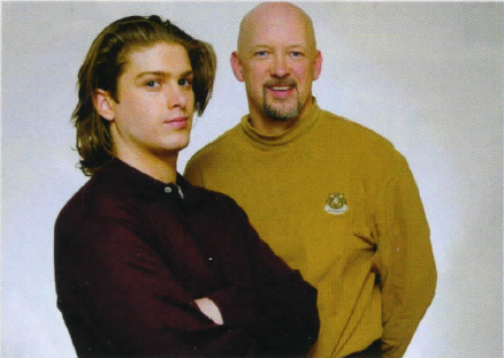
SSG Michael Mantenuto, with the hockey player he portrayed in Miracle.
SSG Michael Mantenuto, 1981-2017
Michael Mantenuto, the talented young actor who portrayed Jack O’Callahan in Miracle, did much more for his country than play a hockey hero in a movie. He became a national hero himself, enlisting in the U.S. Army and serving abroad in Operation Inherent Resolve, dedicated to defeating ISIS in Iraq and Syria.
Mantenuto was an even better soldier than he was an actor. He was a highly decorated Green Beret and Special Forces Communications Staff Sergeant, returning home with quite a few medals of his own for his service.
Tragically, on April 24, 2017, Mantenuto was found dead of an apparently self-inflicted gunshot wound. He left behind a wife and two children.
O’Callahan is, of course, aware of the story.
“Four or five tours in the military, who knows what he went through over there. It’s just a horrible thing right now,” he sympathizes. “22 military veterans are killing themselves every day in the United States. It’s awful. And Michael’s one of them, and maybe I can help tell the story from the athletic side and transition into the military side.
O’Callahan recently made an appearance in Boston, with Navy Seal Jason Redman, to speak for the Concussion Legacy Foundation. The Foundation supports athletes and veterans who have suffered brain injuries. You can visit their website at https://concussionfoundation.org/.
“We just can’t keep ignoring this,” he says. “Michael was the victim of this. I feel terrible for him.”
Here in New England, several outstanding foundations are dedicated to helping our returning heroes reclaim their lives. Please consider supporting them.
Skate For The 22 was founded by Army and Air Force veteran Bobby Colliton, who himself has lost four friends to suicide. They offer skating and hockey lessons, at no charge to veterans, along with an opportunity to be part of a team environment again.
The New England Center and Home For Veterans is dedicated to helping veterans who are at risk of homelessness achieve economic self-sufficiency and live independently. Their programs include vocational training, residential and meal services, and transition into housing.
The Home Base program, operated by the Red Sox Foundation and Massachusetts General Hospital, is dedicated to supporting and treating veterans suffering from the “invisible wounds of war”…including PTSD, anxiety, depression, substance abuse and other struggles.
Skate For The 22’s Facebook page: www.facebook.com/skateforthe22
New England Center and Home For Veterans: https://www.nechv.org
Home Base: https://www.homebase.org
Boston Heroes
Jim Craig, Mike Eruzione, and Jack O’Callahan are all Boston U. alumni. With teammate Dave Silk, they are sometimes referred to as the “B.U. Four” on the U.S. team.
All three were born and raised in the Boston area, the same place where mobs took on British soldiers, threw chests of tea into a harbor, and began an underdog revolution of their own.
O’Callahan grew up in Charlestown, just steps from the Bunker Hill Monument. He tells an amusing story of a mini-squabble with a reporter following the gold medal victory.
“After we beat Finland, Mark Pavelich and I got drug tested. Pav and I sitting in there with two Finnish guys, while the whole team goes across the street to this big press conference. They’re feeding us Kirin beers, these Japanese beers. So Pav and I pounded like three of these beers down.
“By the time we get back to the locker room, it’s empty cause the team’s across the street. So we took off our skates, we put on our sneakers and we run across the street. We have a blast, and this Boston writer says, I have a question for O’Callahan.
“I’ve already got like three, four beers in me, right? He’s like, how’s it feel to be the first person from Charlestown Massachusetts to win a gold medal? And so I said, you know what? The Americans won at Bunker Hill, and the Americans won at Lake Placid.
“So some other writer goes, ‘Back to O’Callahan, by the way, the Americans lost at Bunker Hill.’
“I was like, hey man, there’s a fricking monument outside my house. If it was a loss, they don’t build the monuments. Figure it out!”
“It became this bumper sticker in my town: ‘We won at Bunker Hill and we won at Lake Placid.’
“Charlestown is right on the water. There’s an old Navy Yard and the USS Constitution is moored there, the Freedom Trail goes right by my house. So I was pretty wrapped around the whole aspect of USA, patriotism and military and all that stuff.”
As far as being an inspiration of American patriotism himself, he says, “I’m proud of that, you know, because I love this country.”
(all photos except for the Bunker Hill Monument courtesy of BostonMan Magazine.)
Photo credit: LABabble on Best Running / CC BY-ND
This article contains affiliate links. If you click on one of the links and make a purchase, this website earns a commission at no extra cost to you. Thanks for your support.

Foodie Hall in Cherry Hill

The best assignments a writer could ask for are the ones that include free food…but especially when that food is from recipes concocted by gourmet chefs. JerseyMan sent me to cover the opening of FoodieHall in Cherry Hill…a great place for outstanding grub. Check out the article from the magazine here.
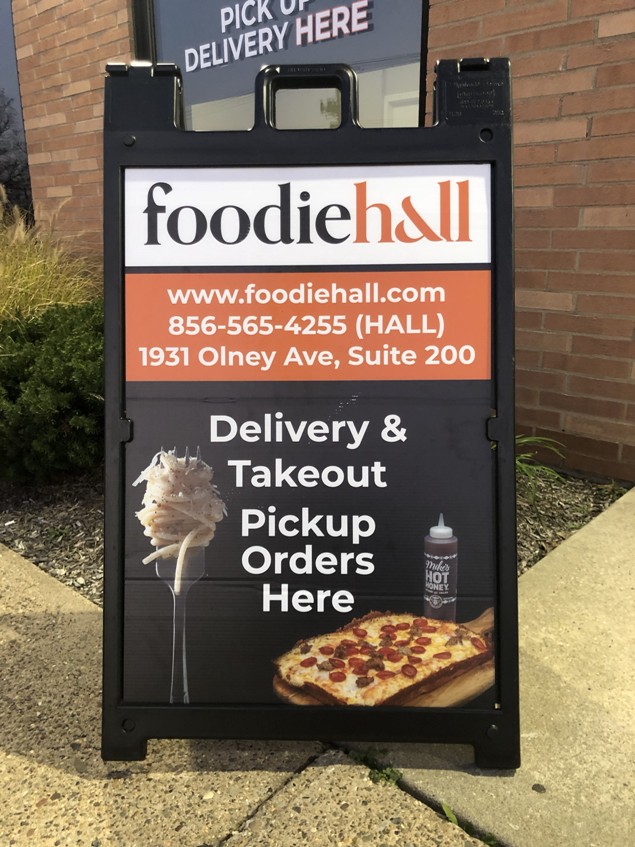
Hall of Food
The new Foodie Hall in Cherry Hill is a revolutionary concept – first rate food prepared specifically for takeout and delivery, while offering something for every taste.
For you JerseyMan readers and Legacy Club faithful, since membership has its perks, we’re about to share privileged information with you. If you’re on a plane or train, check that no one is looking over your shoulder, and that there are no surveillance cameras nearby. We’re entrusting you as someone with a need to know.
Here it is: You can now get a Geno’s cheesesteak in South Jersey.
Okay, maybe it doesn’t sound that momentous. Tony Luke’s, Primo, DiNic’s and other iconic Philly sandwich shops have all opened outposts across the Delaware, sparing their enthusiasts in our neck of the woods considerable congestion.
But for Geno’s, expansion from its 56-year South Philly location has been minimal. You can find a couple of locations in the city, like the airport. But until very recently, a Jersey dweller had to pay bridge toll to sample a Geno’s cheesesteak.

It’s the meat. Geno’s won’t have it any other way.
Dan Goldberg, co-owner of the Foodie Hall in Cherry Hill that now offers the essential Philly sandwich, helped to make this unprecedented happening possible.
“We’re very excited about it,” Goldberg says. “Our PR firm had a relationship with Geno, and made the introduction. We pitched Geno on the idea, and surprisingly to us, he was receptive.
“Geno’s has never expanded outside of Philadelphia, ever. So for us, this was a really exciting opportunity. Geno toured our facility, was very impressed with the layout, the cleanliness, and the whole thought that we put behind it, and said he was interested.”
And so you know, Goldberg didn’t just throw a few bucks at Geno Vento to use his signage. Thankfully, Geno is more protective of his brand than that.
“We worked out our deal, and went through extensive training with Geno to make sure that the Geno’s steak you have here in Cherry Hill is the same Geno’s steak you’ll have in South Philly. Which is not only important to us, but obviously important to Geno as well. It’s literally his name on the marquee.
“Geno was adamant, because he’s approached all the time, he wants to make sure there’s consistency across his locations.”
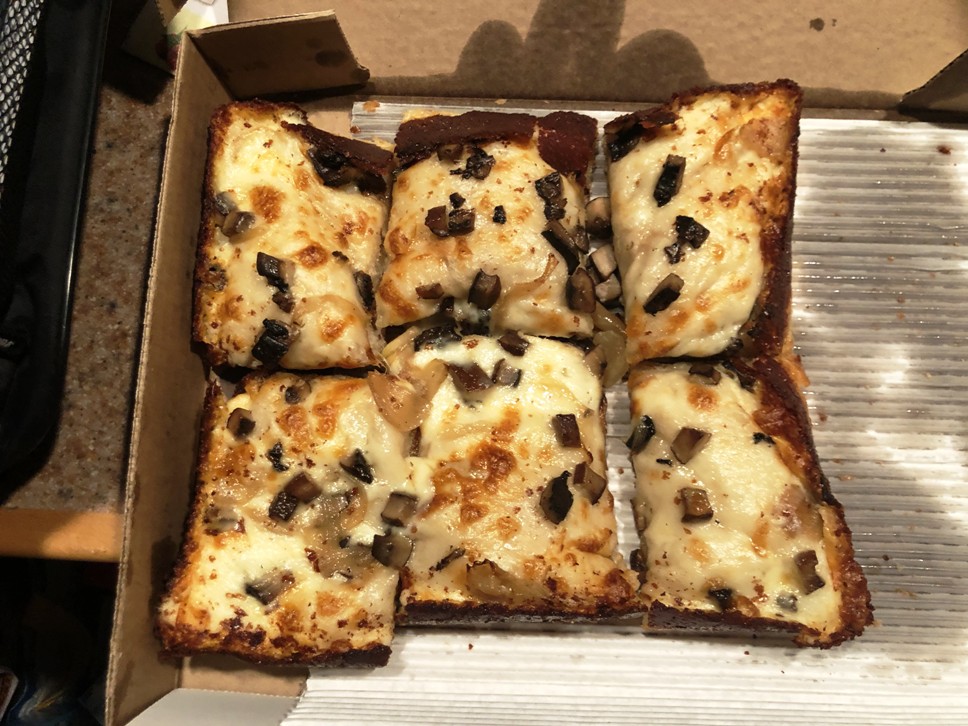
Not just Detroit-style pizza…Detroit-style pizza created by a gourmet chef.
To successfully persuade Geno’s to be a part of Foodie Hall is obviously a significant accomplishment. But it gets better.
Foodie Hall opened for business in May of 2022 offering a novel idea…multiple types of cuisine available for takeout and delivery. No more settling, they proudly proclaim. If your family bickers frequently over what to get for dinner, or your sports watching buddies can’t decide between pizza or burgers, Foodie Hall is your solution.
To be sure, maybe any-cuisine food delivery isn’t what you’d call a novel idea these days. As many restaurants in New Jersey were forced to close in response to a virus, many of them were offering takeout and delivery options to stay viable. If your local diner was doing this, you could probably choose from a varied menu and have DoorDash or GrubHub bring it to you.
Foodie Hall is revolutionary in being designed for the purpose of delivering higher quality food…whether it’s tacos, chicken sandwiches, or dumplings. Hop onto their website and order from menus that include Detroit-style pizza, Korean BBQ burgers, chicken Quesabirria burritos and much more. All chef-inspired creations.

Since the pandemic, the trick is to keep food warm.
In case you’re wondering, Foodie Hall wasn’t conceived during the pandemic. But the sudden pivot towards takeout and delivery definitely gave the idea a boost.
“In 2018-19,” Goldberg remembers, “my original founding partner (Nick Ballias) and I, we met at a food event that I co-chair, called Men and Women are Cooking, that raises money for the Atlantic City Boys and Girls Club. This was when GrubHub, Uber Eats and DoorDash had come to Atlantic City, and it was starting to blow up.
“We started coming up with an idea for a delivery-only restaurant. We had penciled this out already, and then Covid hit and restaurants closed, and all of a sudden everyone was ordering delivery.
“My parents were telling me how they had ordered Morton’s for dinner. That’s when it struck me, there are people whose consumer habits have now changed and will never go back. It’s no longer just wings and pizza. There’s my parents, who are not exactly the most tech savvy, ordering steaks for dinner, that means anybody can be ordering everything.
“So why not come up with a restaurant concept that had multiple different types of cuisines on it? We ran into this family idea, where the parents want adult food and the kids want pizza or mac and cheese. Or the parents can’t agree. Or you have a group of friends watching football and they all want something different. Rather than settling, let’s have something for everyone.”

The conveyor belt. It seems so obvious if you’ve owned a dry cleaning business.
Sounds great, but how could that all work? A conveyor belt is a big part of it (!), but Goldberg says every step of the process matters.
“We put a lot of thought into what delivery trends were taking place, what was working and what we saw that wasn’t working,” he remembers. “Packaging was a big piece of it. Many restaurants during the pandemic that were doing delivery kind of out of necessity were using takeout packages. Those packages are not meant necessarily to be reheated, or to be leak proof, or to sit in a car for half hour or to retain heat or cold.
“We looked at packaging specifically meant for delivery. We wanted something that would maintain heat and not leak. We literally made products in our kitchen, put them in different containers, and had them sit in our parking lot for half hour or drive around and see how they held up. We wanted packaging that would be eco-friendly, and also able to be reheated in microwaves and ovens and things.”
Then there’s the little matter of creating a wide variety of cuisine from one kitchen, maintaining quality, and somehow keeping overhead down.

Some ingredients are astoundingly versatile.
“We are very conscientious in the ingredients we use to be cross-utilized across all the platforms. For example, chicken breast is used in multiple products across the different restaurants. I have a chicken parm sandwich at Criss Crust, and we have the chicken sandwich concept, Simply Fowl, and then we have salads that have grilled chicken on them. We’re trying to use things across and that keeps us more efficient.
“When we designed the kitchen, we were concerned with having a traffic issue, with people walking around and bringing all the various foods to the front. It would have been a waste of labor. We came up with a solution which I borrowed from my old business…a commercial laundry business…where we had a conveyor belt. It’s a 120-foot conveyor belt that runs down the center of our kitchen.
“I don’t need people running up to the front and bringing the food, I don’t have to worry about people walking into each other. It’s a way to keep costs down and keep order in the kitchen.”
The conveyor belt concept is indeed impressive to witness. An owner of a busy diner might see it and wonder how in the world they didn’t think of it.
“No one’s ridden on it yet that I know of,” Goldberg jokes.

Craft burgers. Just because craft burgers.
JerseyMan loves telling readers what makes life in South Jersey great and highlighting business ingenuity among our own. Places like Foodie Hall give us plenty to work with.
In the days before smartphone maps, you might have had a difficult time finding the place. It’s situated in an industrial park in Cherry Hill, just off of Route 70 but requiring navigation of annoyingly tricky jug handles and intersections. If it were a sit-down restaurant, the difficulty getting there might be a factor in your going elsewhere.
But for this style of eatery, the location is the beauty of it.
“We are delivery and takeout only,” Goldberg says. “We need to be near people, and we need to be near businesses, but I don’t need to be on Route 70 or Route 73. I just need accessibility, I don’t need visibility. We built out this really high-end large kitchen, with the latest and greatest in equipment, but I’m not paying the prices I would pay to be on Route 70 or 73. It’s more economical to be here.”
Market research drove the location of Foodie Hall’s first outpost in Cherry Hill. Even though it seems obvious.
“Between Cherry Hill and Mount Laurel and Maple Shade, you have a tremendous number of people that are foodies. It really fit well for us.
“It has a great mix of residents and businesses. We can cater to people in their homes at nights and weekends, and our concept lends itself perfectly to office orders and catering during the day. We’re getting a lot of offices that typically order once a week, same idea as from home. Instead of having 20 people fighting over what we’re having for lunch, now 20 people can get what they want in one delivery.”
Including an authentic Geno’s cheesesteak, without the tolls and traffic.

“Wow, you can get DaNick’s here?”
Establishing The Brand(s)
Foodie Hall features eight restaurants under its umbrella as this sentence was written, including Geno’s Steaks, an instantly recognizable brand to Philly area natives.
You can order Mexican street cuisine from Dando Tacos, Jersey fried chicken sandwiches from Simply Fowl, craft burgers from DaNick’s, Buffalo chicken mac and cheese from Mac N Toastie, or vegetable dumplings from the Cantina Wok & Noodle Bar. If you’re going Italian, try the Criss Crust Detroit-style pizza, or the antipasti from the Fornire Italian Kitchen.
Seeing the choices, a South Jersey food enthusiast could wonder how they have lived here so long without recognizing the catchy names and logos sitting alongside Geno’s. How does anyone miss Mac N Toastie?
When questioned whether the others are established eateries in their own right, Dan Goldberg considers it a triumph of Foodie Hall’s design.
“I’m glad you asked that,” he explains, “because they’re not. The fact that you asked that question means we did a good job of branding and trademarking to look like they are established brands. And the idea is that these brands will proliferate and open up in other Foodie Halls.
“There was a lot of thought given to the name, the logo, the design, the color scheme, to make it look like a franchise or an established restaurant. But they’re all our own creations, we came up with them. We put the menu together, the recipes, etc.”
That includes DaNick’s, which sounds perilously close to DiNic’s, the long established roast pork sandwich destination in the region.
“No, different name,” Goldberg responds when asked about the similarity. “They’re actually named after (co-founder) Nick (Ballias) and I, Dan and Nick. Nothing to do with them, we love their sandwiches, but yes, completely unrelated.”
So foodies in the area can rest easy knowing that they haven’t missed out on Fornire’s, and a potential topic for their blog.
But if you’re one of those types, the clock’s ticking on trying out Foodie Hall before your blogosphere competitors do.

You’re probably pretty good at cooking if you’re seen with this guy. (photo courtesy of Georgeann Leaming)
Key Players – Georgeann Leaming
Dan Goldberg and co-founder Nick Ballias don’t mess around when it comes to takeout fare for discriminating South Jersey natives. While working out the plans for Foodie Hall, they considered product quality important enough to bring a chef on board to be a culinary consultant, and design recipes for their menu of food creations.
Not just any chef, by the way…they partnered with Georgeann Leaming.
You may have heard of Leaming…she’s been a champion TV chef on Food Network’s Chopped, and competed on Hulu’s Man vs. Master. She’s been an executive chef for two of Gordon Ramsey’s restaurants, and has co-owned two food stops in Philly. One of them, Samwich, took Philadelphia Magazine’s “Best Fried Chicken Sandwich” prize in 2016.
That’s just a partial list of Leaming’s street creds in Philly area cuisine, but it’s enough to see why Dan and Nick would take the opportunity to work with her.
“It was very important for us to not simply have your average burger or chicken sandwich. We try to do everything higher end than your normal delivery would be.
“She left to pursue some other avenues in September, but she was with us all the way. She helped us design the menus, and some of the dishes were completely her own from top to bottom in terms of the ingredients, the recipes and everything. These are recipes that we use, and we haven’t changed anything since she left.
“Georgeann was a big help,” Goldberg acknowledges. “Fantastic, talented chef, culinary director, and really helped design and get this to where it is. Perfect person for this, and without her, we wouldn’t have the type of food that we have today.”
The decision of what to get for everyone in the room isn’t the only comestible conundrum Foodie Hall solves. If you’re looking for cuisine inspired by a top chef in the region without the triple-digit price, they take care of that for you too.
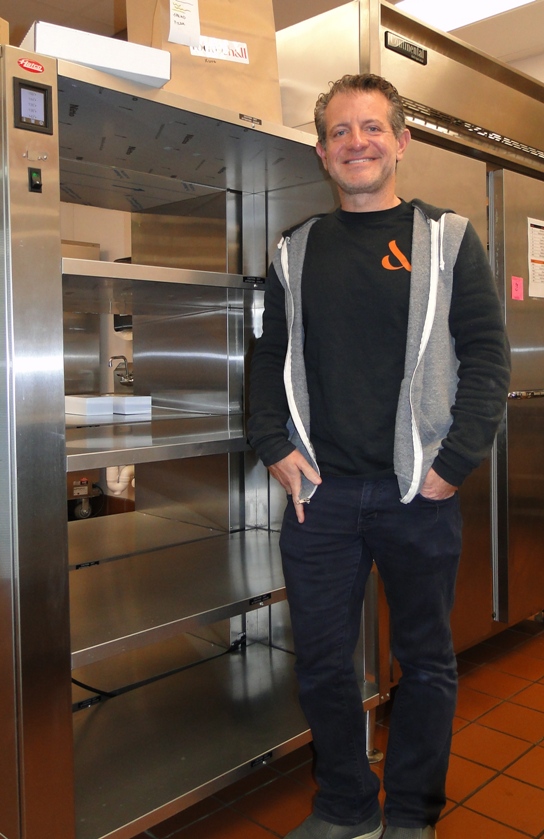
Dan Goldberg, FoodieHall co-owner, feeding people everywhere.
Meals 4 Meals
Dan Goldberg and his people consider giving back to be part of the ethos of business success, and they offer an incentive to philanthropic types who love great food. For every meal ordered from Foodie Hall, they donate a meal to Feeding America through their Meal 4 Meal program. On Foodie Hall’s website, they call the initiative “a vitally important guiding principle in how we operate.”
Goldberg is happy to explain how it works. “What they do is, they will take a monetary donation that they get a lot more mileage out of than we would, because of their immense buying power. We donate an amount to them for every meal that we sell, which is the meal equivalent for them. They use that to purchase meals for their partner charities, which are all across the country and the world.
“We initially got the idea from the Bombas Socks people. For every pair of socks that they sell, they donate a pair to people in need in a country outside of America. And we loved the idea. It made a lot of sense to us.”
So when you order from Foodie Hall, you’re not only providing all your guests or employees something for their own tastes, you’re making a contribution to a four-star organization with 200 food banks and over 60,000 programs to help feed the hungry in your own homeland. Not that you need any extra incentive to try Simply Fowl’s Nashville fried chicken sandwich, but it doesn’t hurt.
“By our calculations,” Goldberg estimates, “We’ll be donating about 50,000 meals in this year, which is really exciting. I’m very proud of that.”

Collectors And Sons – The CollX Sportscard App
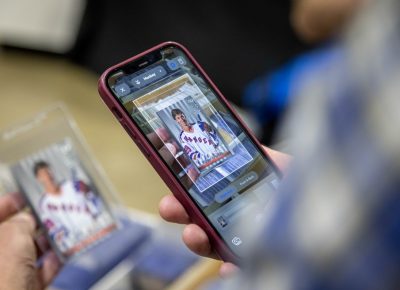
JerseyMan sent me to interview Ted Mann and talk with him about his new app, CollX, which helps sportscard collectors easily find the value of their cards. Love fun assignments like this! You can read the article on JerseyMan’s website here, or view the PDF from the magazine here.
(All photos courtesy of Ted Mann unless otherwise indicated.)
Collectors & Sons – The CollX App
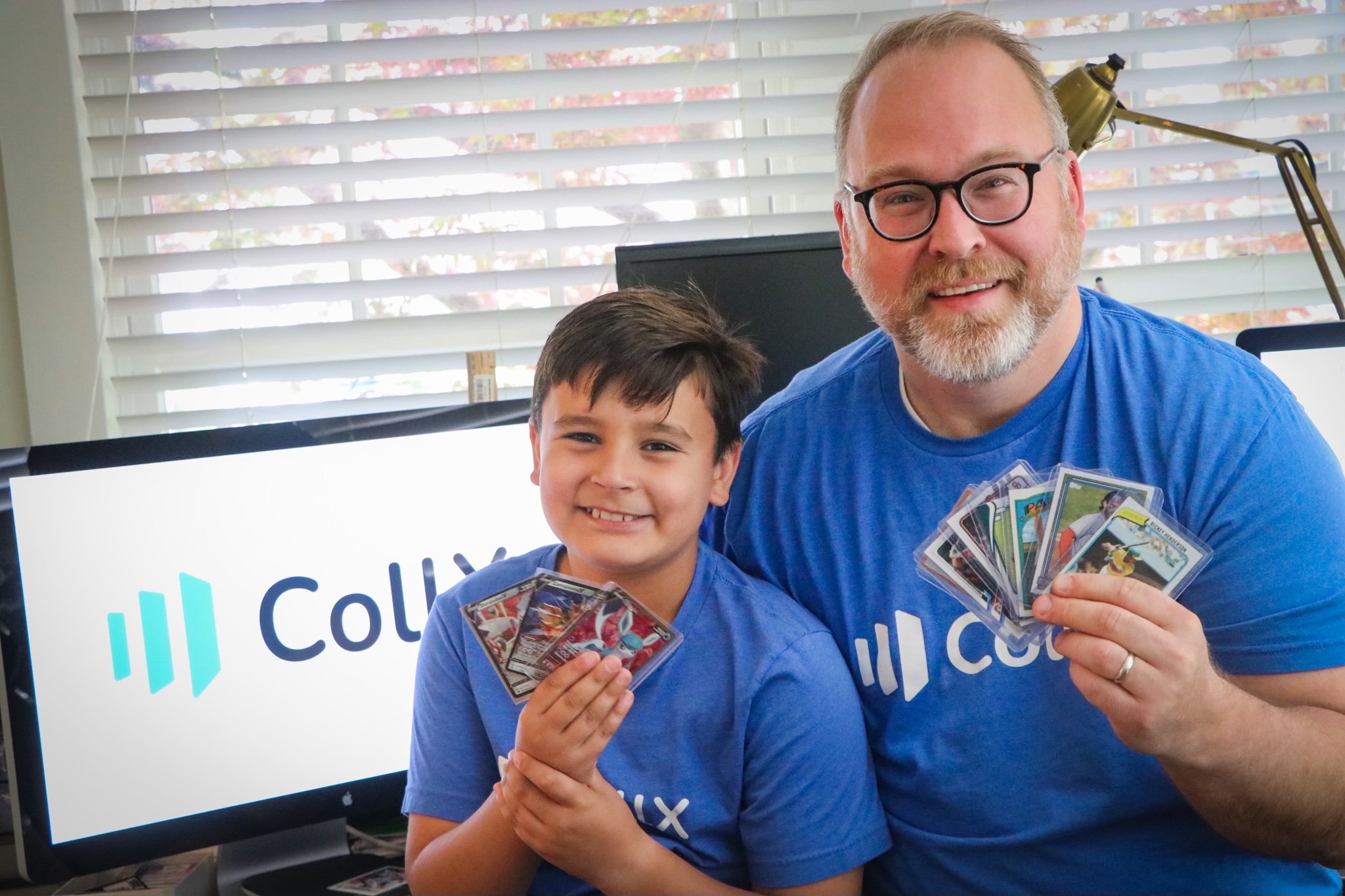
Two geniuses at work.
There is a new app available for sports card collectors that solves a decades-old problem…finding out how much your sports cards are worth. It’s called CollX, and the idea was hatched by a ten year old.
The wonderful thing about young children is that no matter how overwhelming a problem, they always see a simple solution.
And as any sportscard collector knows, finding the true value of cards is a pretty overwhelming problem.
Ted Mann, a former journalist, has just started his fourth technology company using visual search technology. It’s an app called CollX, and it’s an idea that is so obvious that adults need kids to help us see it.
Fortunately, Ted has just such a visionary living under his roof…his ten year old son Charlie, who saw how his father’s technical skills could make the world a better place.
The CollX app does the most important thing apps do…it saves collectors lots of time. With CollX, you can dig out that dusty collection of sports cards from your attic, scan each card, and instantly see its approximate worth. (Incidentally, if your cards are worth anything, hopefully you’ve been wise enough not to let them collect dust.)
No more poring through Beckett or Tuff Stuff guides, no more hauling your collection to a broker, no more countless hours on eBay. Ted and Charlie tried all those things with their collections, until Charlie suggested a better idea.
Ted gives all the credit where it’s due.
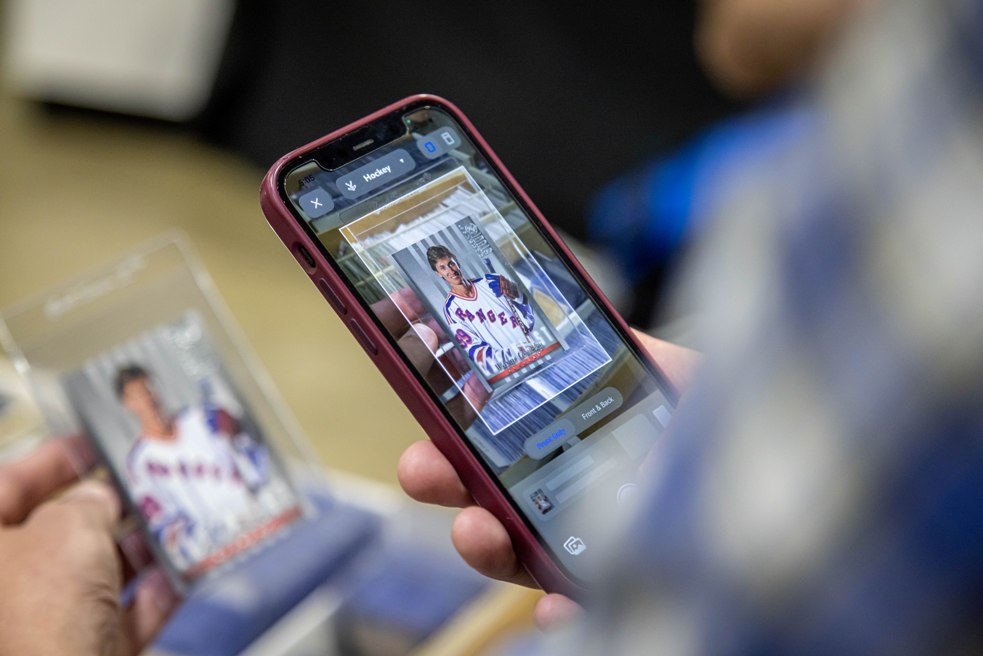
It’s obvious enough that we need a child to think of it.
“When I was a kid, I ran into the same problem that Charlie had. Tuff Stuff Magazine, listings and prices, I also used Beckett back then, looking things up manually.
“But the Beckett Guide has become like a phone book. It’s super thick. It’s really, really tough and time consuming to look these things up, and even when you do, I was finding that the prices in the Beckett Guide, probably the minute they’re published, are out of date.
“We found some apps where you could look up cards, but they were really expensive, high value cards, which sad to say, did not fit the description of my collection or Charlie’s.
“We tried one thing after another, and finally Charlie’s like, “Dad, can you just build me something that would do this?”
Cue the light bulb.

Baseball card valuation on the fly.
Childlike vision works because adults can’t believe some things can be easy, like finding the actual value of a Cal Ripken Jr. rookie card. As a result, many of us let valuable memorabilia collect dust in the attic.
Charlie provided the inspiration, but as Jersey native Thomas Edison informed us, genius is 99% perspiration. Ted is well aware of this, and he’s been putting in the sweat. CollX is all about making a difficult and tedious process easy…but developing the app itself has been anything but an easy process.
It’s not the easiest to market research, for one.
“It’s easy to go and ask people around town, do you have any cards? ‘Yes.’ Do you know what they’re worth? ‘No.’ Have you ever sold a card on eBay? ‘No.’ Why not? ‘I don’t know what they’re worth.’
“It definitely gave me optimism that there was something big here. But understanding how big a market it is was a challenge. We did assess that basically, thanks to eBay and other marketplaces. The current market size is about 5.4 billion.
“But what about all those people that have never sold on eBay? Could you get them to do it? Could you get them reacquainted with their cards and back into the hobby?
“We actually had to conduct a pretty big omnibus study to get a sense of that…just this afternoon, another news outlet called New Street published the findings of our research. The big takeaway was that there are about 85 million American adults that own trading cards.
“It’s a huge 33% of the population, and yet none of them, or I should say a small percentage of them, have ever transacted on any kind of market like eBay. The thing blocking them isn’t necessarily getting the cards graded or having access to a place to sell them. There’s still a lot of card stores, there’s a lot of online sites. It was simply not knowing what the cards are worth, and not having a good way to figure that out.
“If we can help solve that problem, then this huge addressable market can be unlocked.”
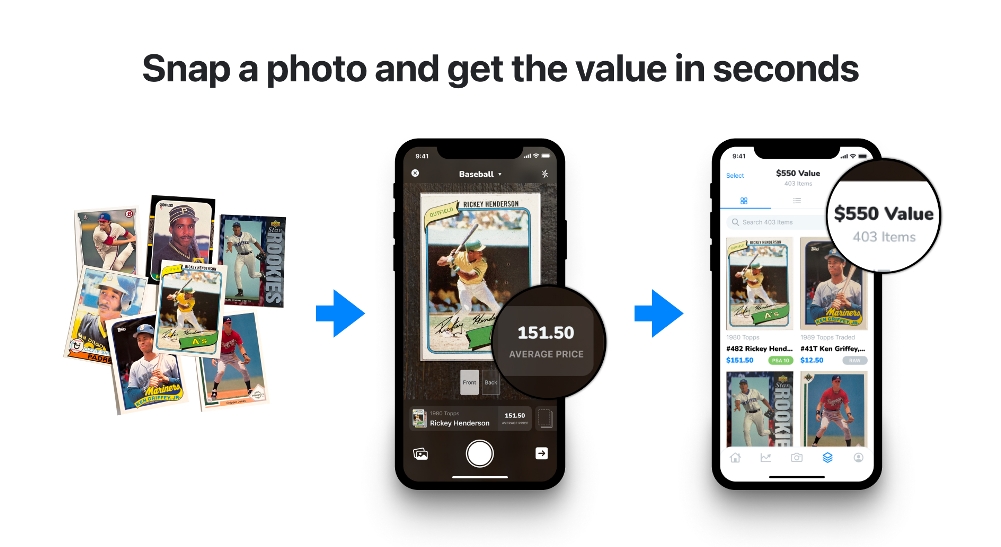
That thick book is why people didn’t bother.
There is also the sheer number of collector’s cards…the CollX database features 20 million, and most definitely counting.
It’s an ongoing process, Mann says. No kidding.
“We still don’t have every card by a long shot. There’s a few cards in my collection that I still can’t scan into CollX, because we haven’t gotten those images or gotten that data into our database yet.”
Spoken like a true entrepreneur…20 million is nowhere near enough. Just how, exactly, does a database of 20 million sportscards get constructed?
“We found a number of sites online, all publicly available sites, that have checklists. In the trading card world, you can build the set, right? And there’s a list of every card in that set. We started building those checklists, and then populating all the images for all the cards in those checklists.
“We started with baseball and then we added football, baseball, basketball, hockey, soccer, wrestling. Soon we’re gonna add trading card games like Pokémon.”
Mann says that they have also developed what he believes is a generally accurate algorithm for determining each card’s worth.
“We’ve built up a ton of pricing data, most of which is coming from other auction sites. Again, publicly available and all readily searchable, eBay being the biggest. We’re taking all of those transactions and mapping those back into the individual cards.”
Arduous task, undoubtedly.
But the CollX app keeps improving, and its usage keeps growing.

One of over 200,000 users at a given time.
During JerseyMan’s interview with Mann, a counter sitting on a nearby shelf occasionally made clicking noises and changed the number it was displaying. This counter, Mann explained, shows the number of people using the app at a given time. At that moment, the number was 232,408 and growing. There are plenty of curious collectors out there.
But Mann and Son’s E-Z Sportscard Valuation Service has bigger plans…not just helping users find the worth of their cards, but also facilitating the sale process if they are inclined, and ultimately monetizing the app through commissions.
“We’re a very early business,” Mann says. “We aren’t charging for the app. We know there are already users reaching out to other users to buy their cards…we see that happening in big numbers. We’re going to help them do that better, so we’ve created a number of tools.
“The first big tool is our deals feature, where you can negotiate on multiple cards. You can create a deal with a bundle of cards and negotiate on the lot. We’ll facilitate checkout and generate shipping labels, to ship the cards via the postal service.
“We want to help people make a lot of money on their collections. But the thing I think is really unique is, on CollX, you actually see what the buyer and the seller both have in their collections. That enables us to say, here’s the areas where you have a shared interest. If you really like the Phillies, Bryce Harper, we’re gonna surface those cards from my collection. When you add something from my collection, now here are a few other suggestions of other cards you might be interested in.
“We can build those recommendation systems in a really personalized way, and I think it creates a better experience.”
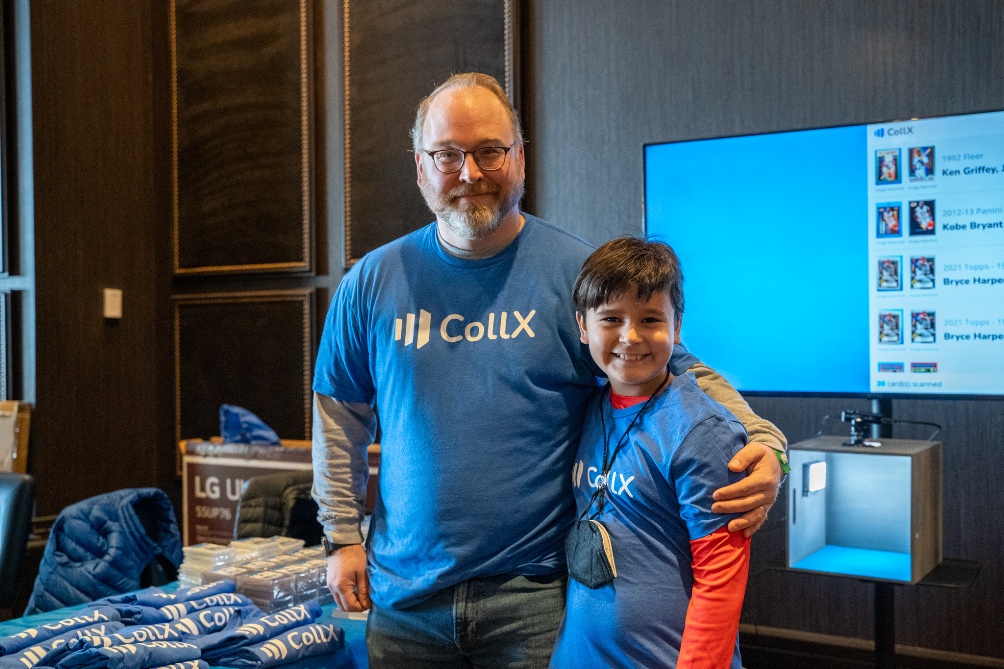
Father and son bonding through baseball cards…it’s as American as it gets.
There are few better opportunities for fathers to tell their sons about athletes of their era than when leafing through a collection of sports cards. Imagine building a business around it with your son. Charlie Mann is getting a solid grounding in both…even if he still gets more stoked about interviewing Rickey Henderson, which he did at a recent sportscard event.
Charlie is obviously not old enough to remember baseball’s greatest base thief, but as Ted says, he knows plenty about him.
“He was super excited to talk to him, because that was one of the cards that he pulled out and he was like, ‘Dad, is this one worth anything?’ I was like, ‘That might actually be the most valuable card in my collection. It’s his rookie card. Let’s go try and figure that out.
“And sure enough, it was one of the more valuable cards. So when Charlie got to interview him, he shared that story. Rickey was really nice. I was really impressed with him.”
“I love getting to do this with Charlie,” Ted continues proudly. “It’s been a great way for us to bond and connect, and it’s not just us. I’ve noticed and seen and heard from countless users on the app that it’s been the same thing for them. Just fathers and sons, getting to bond over collecting cards and to do this together. I think for Charlie that was super gratifying too. To see it wasn’t just him that had this problem.
“And he’s helping all these people.”
Sometimes, the kids really do have the answers.
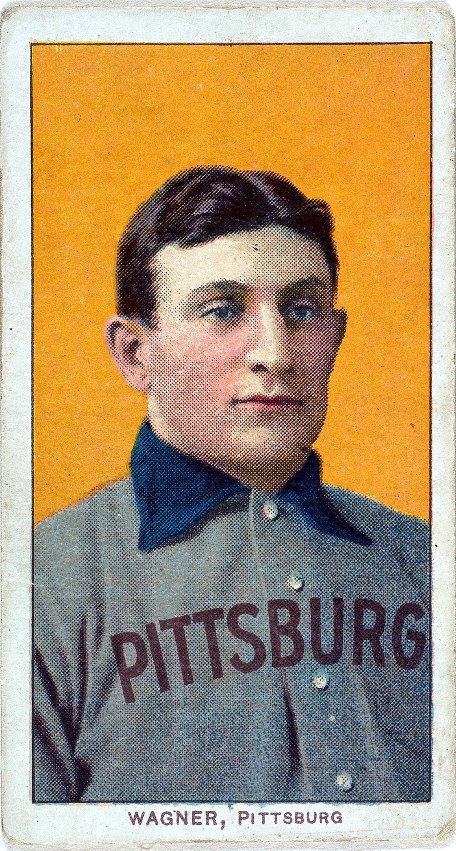
No, you can’t sell a picture of the card. (image courtesy of Wikimedia)
The Honus Wagner Card
As every baseball card collector knows, the T206 Honus Wagner card is the most valuable baseball card in history. In August of 2021, the card sold for a whopping $6.6 million.
Why is it so valuable? According to Wikipedia, in 1912 Wagner was asked permission by the American Tobacco Company, who manufactured baseball cards at the time, to have his visage included on a card. Wagner refused for reasons that still aren’t clear today, with theories ranging from his not wanting to advertise tobacco to kids to his being a tough negotiator who demanded greater compensation.
As a result, just 50 to 200 Honus Wagner cards were produced, and given his stature on a baseball field, this almost immediately made the card valuable.
Ted Mann well knows the value of scarcity in collecting. It was unintentional in the American Tobacco Company’s case (then again, maybe it wasn’t), but Mann says that card trading companies do intentionally create scarcity.
“The manufacturers of these cards create small print runs for certain cards. They’ll say, there’s only ten of these cards. It’s like your golden ticket. Golden auctions sold, I think a one of one Mike Trout rookie card for like $5 million. There’s only one of them, so that creates demand.
Mann doesn’t believe a Honus Wagner card will be scanned on CollX. He stresses that the app is more for “the rest of us”.
“I don’t think we’ll see a lot of $7 million Honus Wagner cards scanned in the collection. As much as I’d love to cater to the high end of the market and have them see the value on the app, I think it’s really kind of the rest of us, the long tail of the collecting hobby that we’re really appealing to.”
The value of some cards brings to mind a potential problem that Mann is also working to address: potential forgeries.
“It’s difficult, forgeries of cards is a tough thing to identify with just a picture, especially if they’re pretty much identical. Obviously, you wanna take a picture of the card and if for some reason you do receive a fake and you’re able to see that, you can report that. And we would not release the payment to the seller if they were peddling fake cards.
“I think there’s definitely some things that we can do to double verify it. But we will protect the buyer and make sure that they get the cards they paid for.”
Something to remember just in case you find yourself seeing a Limited Edition Honus Wergner card for sale.
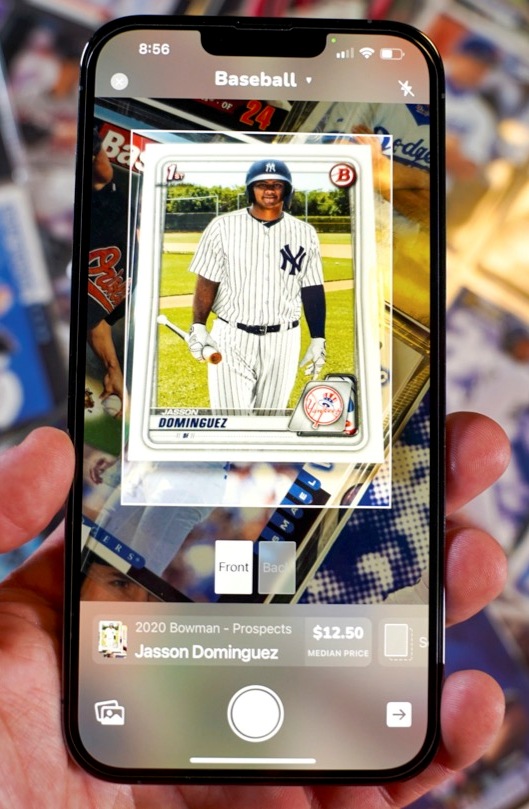
Yes, it looks like him, but let the image recognition decide.
Image Recognition – The Key to CollX
Ted Mann is an expert at how image recognition, a remarkable technology that CollX employs to determine what sports card it’s looking at. His son, of course, was aware of this when he suggested the idea of using it for sports cards.
“What we’re doing with CollX is a specific breed of image recognition that is sometimes called reverse image search, or reference image matching, where we have an existing reference image of a card. We’re trying to match the picture of the card that somebody’s taken on their smartphone to an image in our database.
“Think about it almost like matching fingerprints…when you’re matching a fingerprint, you don’t necessarily need to match everything about the fingerprint. You’re looking for the little variations that kind of define it. We kind of do the same thing. We have a deep learning model that is trained to identify specific features within each card image, and then we’re just trying to match up one to one.
“Imagine if the trading card itself was a QR code. And you’re basically just identifying that and matching that to an existing one in the database to get that one to one match.”
The explanation of the technology obviously goes much deeper, but Ted’s happy to take care of that for you so you and your son can scan your cards.

Be a part of the sportscard valuation community…
The Collector’s Community
Ted and Charlie and partner David Grzybowski recently attended a sportscard event in Atlantic City, where they were quite well received…and encouraged.
“I met probably a thousand people at the national in person who just really love the app. A couple of them came to me with a laundry list of features they’d love to see, which is great too.”
Incidentally, the audience for JerseyMan might find CollX right up their alley. “There’s a high overlap rate of entrepreneurs and card collecting,” Ted says. “It’s actually kind of a funny, it’s how a lot of them got started. I guess myself included.”
To Mann, the enthusiasm for CollX is an opportunity to improve things in the app, such as the accuracy of pricing, which has limits coming from auction sites where prices can vary.
“A lot of our data relies on eBay transactions and a lot of eBay transactions are bogus, we’ve learned. So when those happen, just helping us kind of prune those out. We’re actually gonna have an app update pretty shortly that gives some of that functionality so that our users can help us with that.
“We’ve done our best to come up with ways to average the prices or estimate the prices if needed. But the truth is we need help and we have 232,000 users, many of whom don’t mind putting in a little bit of extra effort to help us.”
Entrepreneurs who listen should be valued. CollX’s customer service is already an improvement over both of the TV providers in my area.
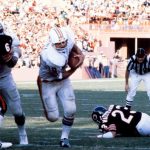
Larry Csonka – Zonk
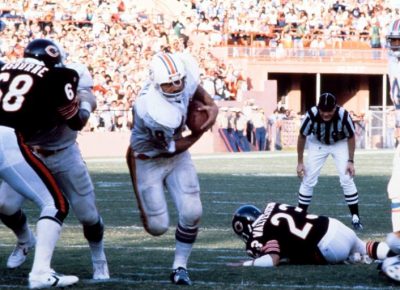
For the debut issue of MiamiMan Magazine in April of 2022, the editors let me cover Super Bowl MVP Larry Csonka, the legendary fullback and key piece of the back-to-back Super Bowl Champion Dolphins. Zonk was very nice to me and had some great stories to share. You can see the PDF of the magazine article here, or see the article on MiamiMan’s website.

Even his eyebrows looked tough.
(photo courtesy of the Miami Dolphins)
Zonk
He was a legendary fullback and one of the most important players on a Miami Dolphins team that stood on top of the football world two years in a row. To this day, the Perfect 1972 team still stands alone.
To this day, Miami is the only NFL city whose team has gone a full season with a zero in the loss or tie columns.
Somewhere, probably in the clouds today, is an Akron area juvenile court judge and junior high principal we should thank for pointing a tough young kid in the right direction…back onto the football field, and on track to carry the ball for that perfect squad.
“I watched my older brother play,” Larry Csonka remembers. “and I went to a high school football game on a Friday night. There was probably three or four thousand people there, which was an immense crowd, I’d never seen anything like that growing up, a country kid on a farm. To play under the lights, I thought that was big time!
“I was sent down to the bench by my father, he sent a dollar down to my brother because he made a great catch. I got to go down by the bench and hand him the dollar, and I just marveled at the sidelines, I was just in awe of the whole thing. I couldn’t wait to get old enough to play.”
That is, until he was actually getting hit. “I went out for football in seventh grade, didn’t know anything about it, got knocked down a lot, and quit.”
Shortly after quitting, the kid from Stow, Ohio got into a bit of trouble, and was put before a forward-thinking judge who possibly saw his potential as a superstar fullback.
“The juvenile court judge told me that I needed to report to my principal every day. He would be responsible for me. Mr. Saltis made me write reports on football”, Csonka says with a laugh. “I started to understand the game and got back into it, otherwise I might not have ever played again.”
Every superstar player in sports history probably has a story of when their path to stardom came close to being derailed. Larry Csonka knows full well how important all of the ingredients are not just to an individual’s success, but to a team’s success.
We’ll come back to that.

The Dolphins were always happy to give Zonk the ball.
(photo courtesy of the Miami Dolphins)
In case you’re too young to remember Larry Csonka, or you need a refresher on what your parents told you, here’s a bit about why he was adored by the football loving faithful here.
In just eight seasons as a Dolphin, he rushed for 6,737 yards and 53 touchdowns…both still team records to this day. He averaged over five yards a carry in 1971 and 1972, and in 1979, as a power running back at the age of 32, he rushed for 837 yards and 12 touchdowns.
He also was, obviously, a key player on the unbeatable 1972 team, gaining 1,117 yards and averaging 5.2 yards a carry. The following season he was a Super Bowl MVP, rushing for 145 yards and two touchdowns against the Vikings. Read that again…Zonk ran for 145 yards against a defense good enough to be in the Super Bowl.
A player known for his legendary toughness, and sometimes carrying several defenders with him into the end zone, is quick to credit another man for his drive on the field…another legend in Miami, otherwise known as the winningest coach in football history.
“The competitiveness of it grew on me a little later, and then meeting a guy named Don Shula in the pros rejuvenated that feeling I had when I was a boy. After going through junior high, high school, college and being on some winning teams, I was motivated by that, but I still hadn’t become possessed by it. When you play for Shula, you either become possessed or you play for another team.
Csonka tells a story about Shula’s motivational skills that isn’t surprising.
“I got hit one time and was laying on the sidelines, and he ran up to me and said, ‘You can’t be hurt!’ It made me so mad I forgot I was hurt, I jumped up to grab him, and he took off!” Csonka remembers with a laugh. “He said, ‘I knew if I made you mad enough you’d forget you were hurt!’”
“He had a real chip on his shoulder about being unprepared, he wanted to anticipate everything that could be anticipated. In other words, total concentration, total commitment to the win.
“Now, that sounds easy, and all of us want to do it, and that sounds fine to go to a Boy Scout meeting and stand out and get your honorary badge, that’s great. But when you do it 17 or 18 times in a row, it’s hard to keep that up. And he would mandate that, he would demand that, and he would raise hell if he thought you were screwing around in practice and not paying attention.
“Two and a half hours, a couple of times a day – that’s five hours a day, and you’re talking about six weeks of intense concentration in training camp. It’s pretty hard to keep that up, on that plane, but with him behind you, we were motivated to stay on that plane.”
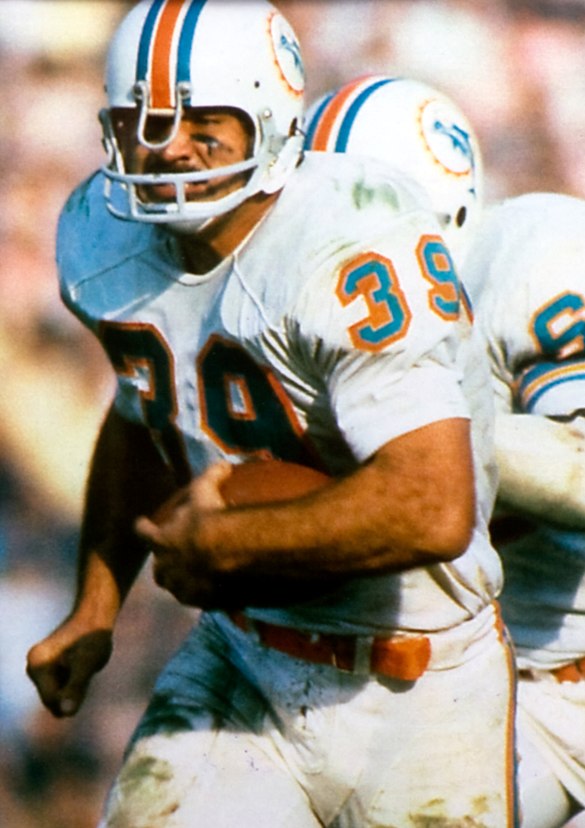
Beat him in the Super Bowl? OK, now he’s mad.
(photo courtesy of the Miami Dolphins)
Zonk remembers that Don Shula pushed for absolutely every edge on a football field…including having a team train in the July Miami heat to prepare for hot days. After an embarrassing Super Bowl loss to the Cowboys, the coach made the team use the loss as motivation.
It worked out literally perfectly.
“Getting that far in ’71, and then getting your ass handed to you in the Super Bowl was embarrassing. But Shula said to us after that game, ‘I want you to remember this moment, because we’re gonna use this as a basis to make even more sacrifices next year.’
“He didn’t say what our objective was going to be. What he said was, we’re gonna treat every game like it’s the Super Bowl. That way we can’t ever relax. By the time we get to the Super Bowl, we’ll be able to make sure that we do it one more time.
“Those words rang true, that was a great prediction after a terrible loss.”
Indeed, as the football world remembers, the Miami Dolphins made winning quite the habit in 1972. The backfield of that team contributed to the obsession…the interchangeable squad of Csonka, Jim Kiick, and Mercury Morris made opposing defensive coordinators want to put 15 players on the field. It was an idea Shula had once he believed Morris could take the punishment.
“Coach Shula decided to talk with the offensive line coach to see if we had the offensive linemen that could get to the outside. And we did. Larry Little, a huge big man, who was super fast in the 40, so we could get somebody out there to block for Merc, and we could have that outside threat.”
“It gave us a three-dimensional backfield, and that made a difference. That was one of the contributing factors to going undefeated.”
The Dolphins’ backfield was so strong that even losing a Hall of Fame quarterback in the fifth game didn’t stop the victory train. But Csonka is quick to point out that absolutely everyone on the team made contributions to a season still unmatched in NFL history…starting with Kiick and Morris.
“In order to do that,” Csonka reflects about the interchangeable backfield, “you have to have the talent to do that, but you also have to have the personalities to do that. Jim Kiick and Mercury Morris were two unique personalities, but the great common thing between them was the mutual respect of each other, one realized the other had talent that he didn’t, and they both recognized that fact, and were all right with that.
He continues: “If any one ingredient doesn’t mix with the other ingredients, then you’re gonna have that kind of animosity that’ll grow to be a cancer and it’ll keep you from attaining a perfect season. There’s a reason there’s only one team that’s ever done that. We had the best blend of players and coaches.”
“When you look at it, you take any one player, if you take Bob Griese, starting quarterback, Earl Morrall, the substitute quarterback, all made contributions. Charlie Babb, special teams, rookie player, got in there, made a big play, blocked a punt. You take Charlie out of that game, we lose that game.
“As a rookie playing on special teams, only got on the field a few times, but he got on there just enough to make a difference in us going undefeated or losing one game.
“That’s how finite it gets.”

Profile of a Hall of Famer.
(photo courtesy of Audrey Bradshaw)
Zonk is, at least partially, so fondly remembered in South Florida for an unfortunate reason. He represents a successful era for a team that hasn’t won a playoff game in over two decades. Young Miami football fans aren’t even accustomed to frequent playoff runs these days, much less three straight Super Bowl appearances.
Read some of the blog posts on his website about the team in recent years, and it’s apparent that like the rest of the city, he becomes frustrated with the Dolphins’ shortcomings. He’s still supportive, but it’s clear that it’s no easier for him to watch sometimes than for the rest of us.
Csonka confesses to not being able to apply his understanding of the game in his playing days to the game of today. But he does think there’s one constant in winning football that the Dolphins need to embrace to get back on top again. When asked that question, he begins his answer with one word: unity.
“If you get a strong head coach that believes in a certain way to do it, and you can get a cast of players that believe in him, I don’t think that formula’s changed that much.
“Is it Don Shula reborn again? I don’t know, but I think it starts with that. I think it starts with a strong coaching staff and the dedication of the players, and finding 40 or 50 players that really, truly want to win, and they’ll make whatever sacrifices that are necessary in order to obtain that.”
That said, he does make occasional public appearance to talk about the glory days.
“We get a few fans, that might go back and remember, and some of the young folks that have heard things from their parents or grandparents, or perhaps even great grandparents,” he says with a laugh. “What I do is reminisce about the championships and how we got there, Coach Shula, the colorful, fun parts of the game that you still see on Sunday are fun to talk about. Sports humor is really what it’s about, it’s a good time, not any deep message or anything.”
The Perfect Season, justifiably, is still today a great source of gratification for the Hall of Fame fullback.
“More than personal pride, it’s fun to feel a team pride in being part of that. I’m sure there are other people that have made it to the top of Everest and stood there and felt that exhilaration of being on top of the mountain. But to be able to stand on top of the mountain, and know there’s an entire team standing there with you and you’re all part of that, is just another benefit.
“When the ’72 team gets together, those that are still standing and walking around, there’s a great camaraderie, and there’s a constant feeling when eyes meet, nothing has to be said.
“The fans that were there, again, that are still standing, when we see them, it’s a celebration that’s very unique. They can’t wait to tell us about it, we can’t wait to hear about it. It’s a celebration that goes on and it’s just as enthusiastic today as the day it happened.”
Zonk also has a sense of gratitude towards one other group of people: The Super Bowl XLII-winning New York Giants.
“I’m indebted to my teammate at Syracuse, Tom Coughlin, the head coach of the Giants, and Eli Manning. I am still their biggest fan!”
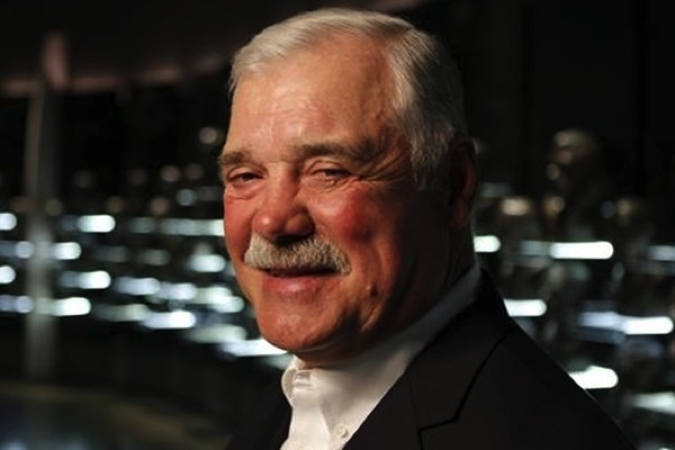
And an author as well.
(photo courtesy of Audrey Bradshaw)
Head On
MiamiMan loves success stories and views behind the scenes, especially when it comes to legendary sports achievements…and the Perfect Season certainly qualifies.
Larry Csonka’s coming book, Head On, shares tales behind his and the Dolphins success in that era. It includes flashbacks of his nearly quitting football, his occasionally rocky relationship with Don Shula, and his palling around with the likes of Burt Reynolds, Lee Majors, Elvis Presley and others during and after the Dolphins’ high-flying run.
But Csonka also shares some wild stories beyond the bright lights of the football field…such as his confronting thieves with a sawed-off shotgun, being adrift in gale force winds in the Bering Sea, and taking sniper fire in the midst of a USO tour.
As Csonka was quoted in Life magazine back in 1972, “No matter what your style, you have to take a beating.” Indeed, from the sound of it, the book describes a life of an athlete who took the hits on and off the field, and keeps moving forward.
Head On is slated for release on October 4, 2022. You can pre-order it on the Amazon and Barnes & Noble websites, and from the publisher, BenBella Books.
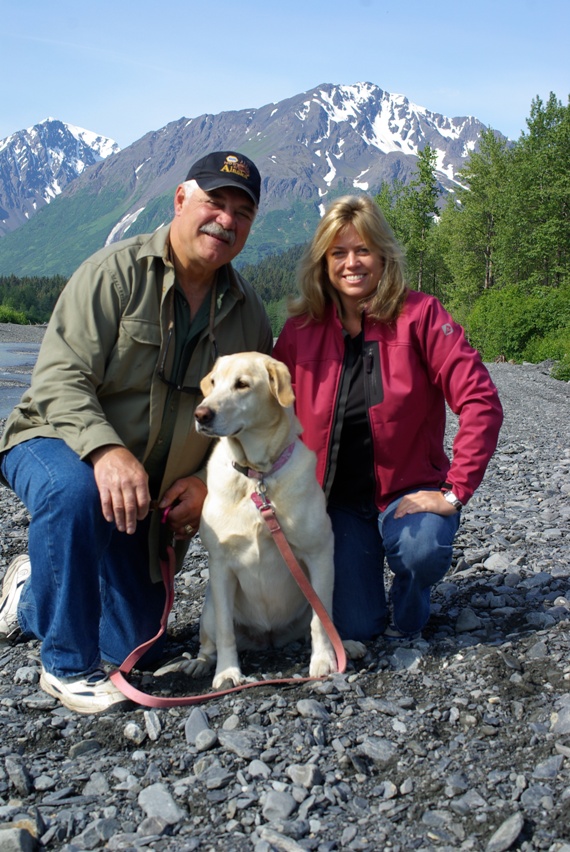
Larry and Audrey living the way Davy Crockett did.
(photo courtesy of Audrey Bradshaw)
The Last Frontier
Visit Larry Csonka’s website and you’ll see a selection of videos of him and Audrey Bradshaw, his lovely longtime partner, catching fish in the midst of beautiful Alaskan backgrounds.
Many of the videos are from his surprise hit show, “North To Alaska”, which enjoyed a successful run until its retirement in 2013. ”North To Alaska” was everything an outdoor life show should be…a former star athlete enjoying retirement by becoming just like one of the rest of us again. He and Audrey catch fish together, visit beautiful lodges in remote areas of a remote state, and share the greatness of outdoor life in the last frontier. It all makes for enjoyable, leisurely, and educational television.
What makes “North To Alaska” special enough to have enjoyed a 16-year run is that Zonk, a man who made a considerable mark on a football field, is there as a hunting and fishing enthusiast, not a former star athlete. It’s because he has just as much enthusiasm for Alaskan life as he did for football.
“Through my entire career, starting in high school or junior high, I aspired to get to Alaska by hook or crook. I got sidetracked into the NFL, and some ten years after the NFL, I finally got a chance. Starting with ESPN and our sponsors NAPA and STIHL, we put together an outdoor adventure, fishing, hunting series. Audrey and I moved north and bought a place in Anchorage and then Wasilla. We were residents of Alaska for some 20 years, and still go back for a month and a half each year.
“I think from the time I was probably 11 years old, I just wanted to go to Alaska because I figured that was the last place you could experience things like Daniel Boone and Davy Crockett did.
“What a great way to do it, getting paid to do it. By the time the series ended, it was doing quite well. By the time it was in its 16th year, we had been a lot of places that most people don’t get to see in the state of Alaska.”
The popularity of a retired football star, even a Hall of Famer and Super Bowl MVP, isn’t enough to carry a low-quality show for a decade and a half. The appeal of “North To Alaska” may be that Zonk shows us all that it doesn’t take piles of money or fame to enjoy the good life. He’s the ultimate everyman with a genuine love for the outdoors, and it works.

A lot of nuns didn’t think it was funny at the time.
A Bird On The Cover
Larry Csonka made the cover of Sports Illustrated a few times in his career, but easily the best known cover shot features him and backfield teammate Jim Kiick…in a pose that featured Csonka giving a not-so-subtle middle finger. What makes the photo so priceless is the snickering look on Zonk’s face. You can easily find a copy of it on eBay if you’re interested.
Intentional? Not on Csonka’s part, at least as far as the photo actually making the cover. He’s not sure about the Sports Illustrated folks, though.
“We shot probably 200 photos that day of all the different kinds of poses. We had a couple of photos we just wanted for us to be funny, so we did that, and somehow that photo got in with the others and somehow inadvertently got put on the cover. I received very nasty letters from irate nuns for about five years after that!
“I sometimes wonder if that wasn’t done on purpose, but it wasn’t meant to be on the cover, it was meant for our own personal thing. So after that, I didn’t do that anymore. I certainly apologized, but at the same time, it was supposed to be private and it didn’t turn out that way.”
“But I’ll tell you what, a lot of people kept that issue!”
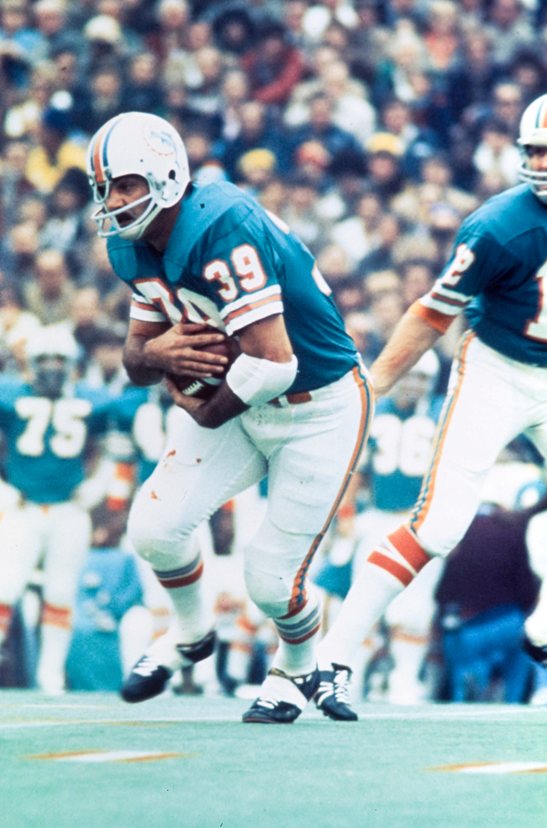
And a comeback player, too.
(photo courtesy of the Miami Dolphins)
Going Out On Top
Csonka broke away from the NFL to play in the ill-fated World Football League with the Memphis Southmen, and then played a couple of seasons with the Giants before returning to play with the Dolphins in 1979. He was hired by the Dolphins to be a blocking back for Delvin Williams, but when Delvin performed below expectations, they gave Zonk the ball…and he carried it for 837 yards and 12 touchdowns, a performance that won Zonk the Comeback Player of The Year award.
“I came back to be a blocking back for Miami. I became the guy running the ball. I think on one occasion, I carried it 40 times in a game, and at 32 years old, whatever I was at the time, I don’t recall, I didn’t need to be carrying the ball 40 times a game.
“That’s very much a young man’s game, a power running game, and you have to have great offensive linemen, which I had in ’72 and ’73.
The end of Larry Csonka’s NFL career came shortly afterward, with Don Shula making the decision for him.
“I made the decision to hold out, unless I got paid a whole lot of money to run the ball, I was still pretty healthy. But instead, I held out and Shula got mad and fired me.”
He has no regrets. “I wasn’t mad that he fired me. I was at a point in my career where I was glad he said I was through. That gave me all the pushing I needed.
“At 33 years old, it’s time to retire, particularly for a power running back.”

Donovan McNabb – Forever A Leader
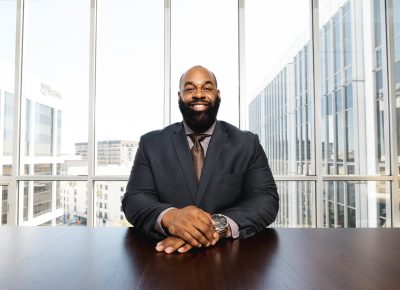
Donovan McNabb is one of the all-time great quarterbacks in NFL history, and will always be a local hero in Philadelphia. But today, he spends much of his time coaching athletes who are too young to remember his playing days. JerseyMan Magazine sent me to interview the Eagles QB for the Fall 2021 issue…you can view the magazine edition here.

Donovan McNabb – Forever A Leader
Despite the opportunity to gather quotes and jump into a fray of controversy, JerseyMan didn’t ask Donovan McNabb about the most talked about events during his career in Philly.
We doubt our readers are interested in rehashing the decade-plus old rantings of a talented but ultimately cancerous ex-teammate…a receiver who was suspended and subsequently released by the Eagles for his statements, and then signed on with their most hated rival. No thanks.
But just in case you were wondering, no, McNabb didn’t upchuck in the huddle in the Super Bowl. There isn’t even discernible evidence that that happened, in an event that benefited from the best that television broadcasting had to offer.
As Mike Tanier’s Bleacher Report piece about the alleged incident puts it, “This urban legend is all about a quarterback’s inability to lead his team back from a double-digit deficit against one of the greatest dynasties in NFL history with four minutes to play in the fourth quarter.”
And no, the last player to wear #5 for the Philadelphia Eagles doesn’t hold anything resembling a grudge against local fans for their reaction to the team’s choosing him over Ricky Somebody in the draft.
It’s fairly easy to argue that the Eagles made the right call on that one. We love our friend Jaws at JerseyMan, of course, and the Eagles’ fan faithful will forever be grateful to Nick Foles. But by nearly any measure, McNabb remains the best quarterback to wear an Eagles uniform.
Put it this way. If you were a parent of a young quarterback, you wouldn’t object to having him as a mentor.
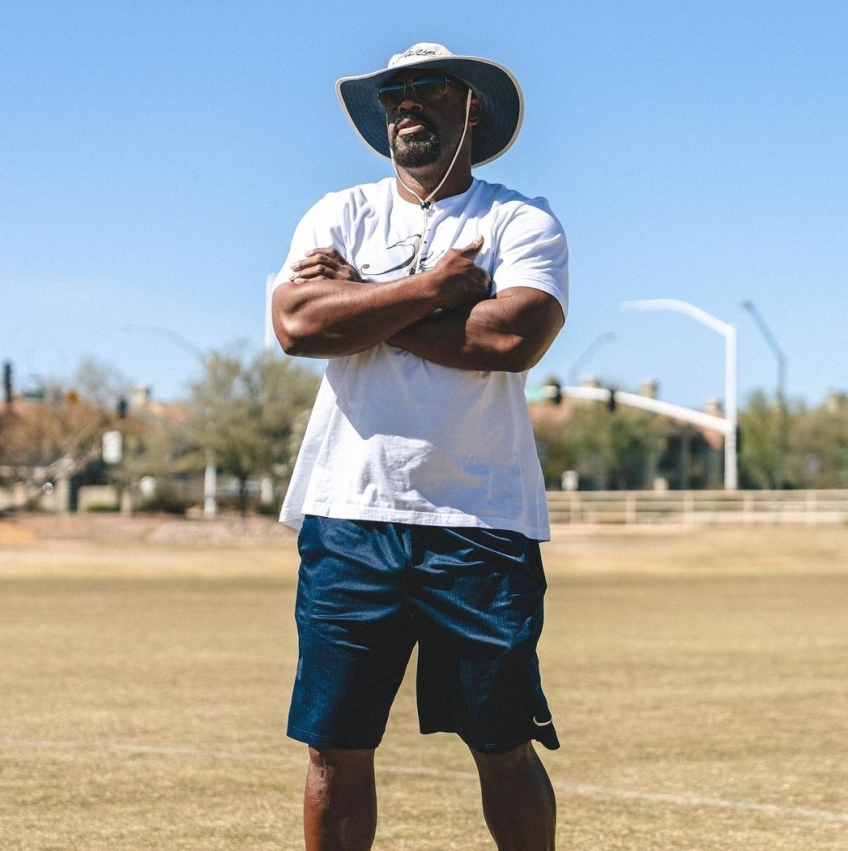
“Alright listen up…first thing you need to know, radio guys don’t know squat!”
(photo courtesy of Cathy Cardenas)
McNabb spends time today coaching young quarterbacks…junior high, high school, and college players. He is one of several former quarterbacks involved with The QB Legacy, a non-profit dedicated to teaching aspiring quarterbacks the fundamentals…not just of the game of football, but of being a leader in life.
Ty Thompson, a University of Oregon freshman, is one young quarterback who McNabb has mentored. As FanSided reports, Thompson is already a strong candidate for the starting job, and is Oregon’s top-ranked quarterback commit of all time.
“I’ve had an opportunity to implant my wisdom,” McNabb told JerseyMan, “on the things that they want to accomplish. I try to prepare them from a fundamental standpoint of knowing the intricate parts of the game. And also provide a little bit of spark for these young men, to give them that confidence that they can play this position at a high level, if they put the right time and effort into their craft.
“So many times you see trainers doing what they see Patrick Mahomes do or what they see Aaron Rodgers do. And I think that’s a negative, because not everybody is on their skill level, not a lot of people can do what they’re doing at this particular point.”
Most of the young players McNabb coaches don’t remember his playing career. But their parents do.
“The last time I took a snap was nine, ten years ago, and that was in Minnesota toward the end of my career. A lot of these kids have never seen me play. It’s more the parents that know a lot about you.
“And I have no problem with that, because I’m not coming in there, Donovan McNabb, NFL quarterback, I’m coming in as Donovan McNabb, quarterback trainer, that’s going to help you be able to perform at a high level and prepare you from a mental and physical standpoint.
“I’ll show up at their games and write down some different things that we can do on our next couple sessions. I’ll be there when they need any assistance, maybe something happened at practice and they don’t understand why, how they can change it or things of that nature.
“If I have a kid that’s in middle school, I want him, by the time he graduates from eighth grade, to be mentally where the sophomores are in high school. We know your body’s going to develop at some point. But from a mental standpoint, can you be able to get out on the field and tell each and every player what they’re supposed to do, explain to the coach what you’re seeing from a defensive standpoint, what blitzes they’re doing, how to attack those blitzes.
“That right there gives you the upper hand when it comes to a lot of these kids who are just athletic, because now there’s a trust value that coaches are starting to build with you, because they know you’re well prepared and understand the games.”
And yes, you have to handle shots from critics. As we all remember, McNabb knows that better than anyone.
“It’s not just younger kids,” he continues, “it’s adults too, who have issues with criticism. With social media now, people don’t like something that you post, or people comment negative to you, it affects them, instead of just moving on and using that as motivation.”
So is he tempted to tell young QBs not to play in Philly if they can’t take the heat?
“It’s not so much that, Philadelphia is kind of well known for that. But again, you’ve got to stand strong and you’ve got to be able to take it, move on.
“Smile, that’s what I did!” McNabb says with a laugh.
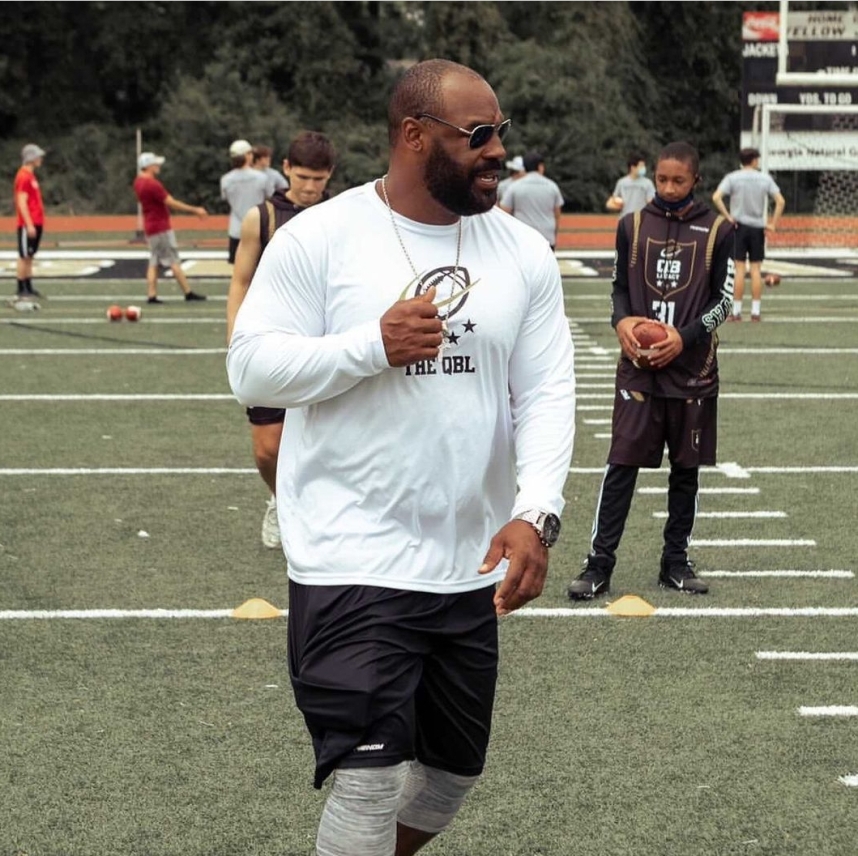
If you want to learn how to play high level football, ask someone who’s played high level football.
(photo courtesy of Cathy Cardenas)
As a lot of JerseyMan articles about retired athletes have shown, success on the field doesn’t necessarily translate to success in other walks of life, but it definitely helps. Part of the goal of The QB Legacy program is preparing young athletes for life outside of or after football.
“The most important thing for me,” McNabb explains, “is trying to get these young men to understand that being the quarterback of a Division I program or being a quarterback of an NFL organization, that you are the CEO. You are in a boardroom in front of millions or thousands of people. Can we put you in front of a room, and you explain to me what each and every person is supposed to do in this office?”
“We’re building leaders, we’re building mentors, we’re building role models. We’re building CEOs. We’re building guys to understand that it’s much more than just playing the quarterback position. You have ten people on the field with you that are relying on you to make the right decisions, to lead them to a Super Bowl.
“And so you have to do your job. You have to be able to prepare yourself to go out and be at the highest level of your craft.”
Whether it’s young quarterbacks, or softball or girls basketball players, whom he also coaches, McNabb today is preparing the adults of tomorrow for the game of life.
As with many of the good guys in sports, it’s the preferred way of enjoying retirement.

If I just offered to buy his cheesesteak, I could be shooting pool with him.
(photo courtesy of Cathy Cardenas)
This scribe choked on his chance to meet Donovan McNabb.
We don’t have much in common as far as athletic achievement or income level, but we’ve both been known to frequent Gaetano’s in Willingboro. And yes, we’ve been there at the same time. My hang-up about approaching celebrities during meals overrode taking advantage of a rare opportunity to chat with an NFL superstar.
McNabb lives in Arizona now, mostly just because the weather is better. It was where he started training in the second year of his career, and he liked the area enough to stay.
“It’s a great vacation place,” he says. “My family was from Chicago, friends in Philadelphia, New Jersey, when they come out here, drop the winter coats and Timberland boots, put on some shorts and a tee shirt and just relax.”
But he’s got nothing against the city where he made his considerable mark. Donovan still visits and loves Philadelphia and South Jersey…and mentions Gaetano’s as one of his favorite eateries in the area.
“I’ve still got friends there, I love the area. I’m talking over 15 years, pretty much, since I’ve been in Philly, but I go back and it’s like I still live out there. The people that know me are the people that watched me play, still remember you, have conversations with you.”
He’s happy for both the Eagles and Andy Reid for their Super Bowl triumphs. Regarding his former coach, McNabb believes that the Super Bowl win “implants him when it comes to one of the greatest coaches. For the things that he’s been able to accomplish over the years with us, and then turning the Chiefs organization around. Andy definitely is a sure shot Hall of Famer, and winning that Super Bowl is definitely going to help.”
They fell just short as a pair themselves. But McNabb hopes people remember the good times, with Andy at the helm and with #5 as the field general.
“I would love to have won a Super Bowl,” he reflects, “but that doesn’t define who I am as a player or who I am as a person.”
Maybe someday Ty Thompson, or another McNabb pupil, will get that done for him.
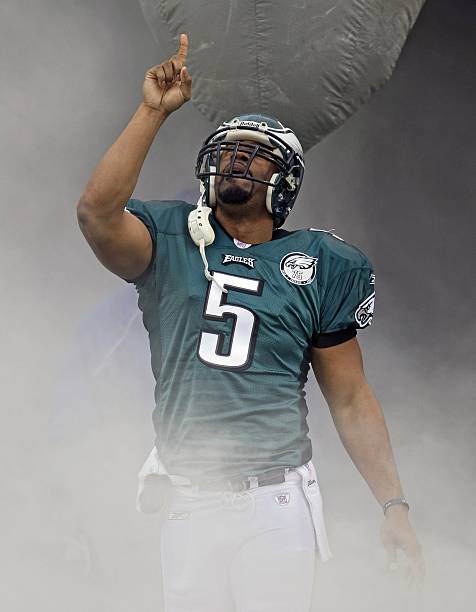
If they take pictures of you surrounded by dry ice, you probably belong in the NFL Hall.
(photo courtesy of Cathy Cardenas)
The Case For McNabb In The Hall
Wait, what? Donovan McNabb, the greatest all-time quarterback on a team that had Roman Gabriel, Ron Jaworski, and Randall Cunningham, isn’t in the NFL Hall of Fame?
Nope, he’s not. Critics say something to the effect of his not having won a Super Bowl, despite coming within three points of doing so against the NFL’s greatest dynasty, or not being a leader in statistics during his prime years, with no mention of the subpar receivers he had to throw to at the time.
So at best, McNabb’s entry into Canton is being denied by his crime of having less than championship level teammates.
He doesn’t go there, though.
“There’s no need for me to make a case. I think numbers and film alone define that. Some people look at numbers, some people look at accolades, some people look at Super Bowl championships, some people look at appearances. And so you can’t please everybody. So for me to try to state my case, no, it’s nothing to it.”
“Look at Walter Payton, people always said that Walter had to win a Super Bowl. Walter Payton was the best running back to play the game at that particular time. He also was one of the best players to ever play the game, not just running backs.”
“So, when it comes to a lot of these players, it’s sad that we want to sit and talk about, well, how many Super Bowl championships have they won, or how many times they’ve been All-Pro? How about, why don’t you ask the defenders they played against, ask them how hard it was, the game plan against them. It says a lot.”
So do McNabb’s numbers…37,276 passing yards, 3,459 rushing yards, and 234 touchdowns. Six Pro Bowl appearances, five NFC East championships, five NFC Championship game appearances, and nine postseason wins. If you find any QB with similar numbers, they’re probably enshrined in Canton.
From 2000-2004, McNabb led the NFL in QB wins. During his career, he ranked fourth in wins behind guys named Brady, Favre, and Manning.
There’s always arguments with every Hall of Fame induction about who got slighted. Donovan McNabb shouldn’t be the subject of one.
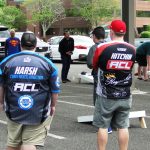
Professional Cornhole – Beyond The Parking Lot
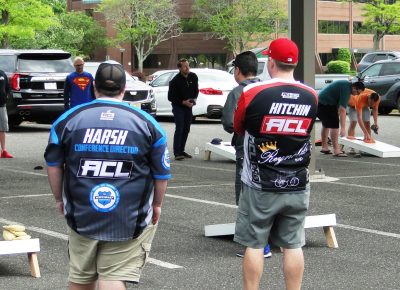
JerseyMan asked me to cover a local cornhole event they arranged, and to work in a piece about the phenomenal growth of professional cornhole in the midst of the COVID-19 pandemic. Hope you enjoy it. You can also view the PDF of the article here.
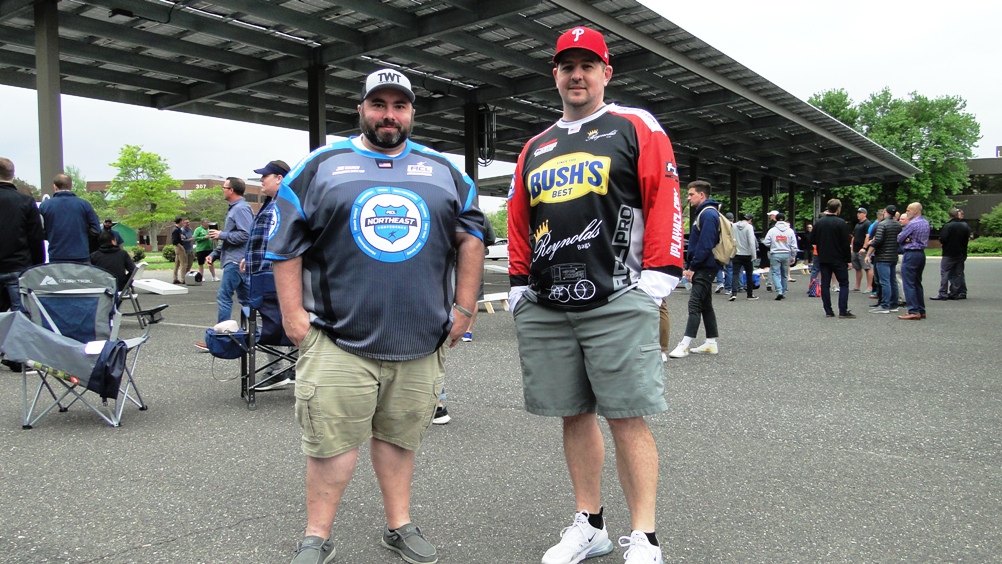
Professional Cornhole guys.
Beyond The Parking Lot – Professional Cornhole
You can write for JerseyMan and attend Legacy Club events for ten years, and almost never see Ken Dunek animated enough to shout loudly and pump his fist.
Then again, you don’t see many people gain a lead against John Kitchin in a cornhole match, however short-lived that lead may be until Kitchin finds his bearings and starts effortlessly nailing throws. It’s understandable for even a reserved person to be thrilled at the achievement.
This anomaly was at the Infinity Club Cornhole Tournament, held this May at the PCS facility in Moorestown. The event raised nearly $4,000 for the Leukemia & Lymphoma Society, and for survivor T.J. Smink’s bid for the Society’s Man or Woman of The Year.
Of course, many esteemed Legacy Club members were present. It’s an ideal opportunity to avenge a recent defeat on the golf course. No one tanks, of course, but a loss isn’t so bad…it’s an opportunity to grab a drink and catch up with fellow members.
One would think that, in a crowd of Eagles fans, who have to have considerable tailgating experience, there would be some players standing out in the crowd. But other than Smink’s team, who prevailed in the match, most of them were unexceptional shooters. Even by frequent tailgater standards.
The tournament was for fun and to help less fortunate people. PCS’s parking lot is obviously no billion dollar, luxury box-filled venue.
But professional cornhole has grown well beyond the parking lot.

Apparently, everyone else forgot their uniforms.
Present at the gathering were Kitchin, a national cornhole pro who resides in West Deptford, and Joe Harsh, the American Cornhole League’s (ACL) Northeast Conference Director.
Yes, there is a nationwide professional cornhole league. As seen on TV.
Before 2020, the ACL had already landed some national television deals, and events could be seen on various sports networks. Then they got a boost…professional cornhole became one of the rare entities that benefited from an outbreak. With no baseball, football, basketball, hockey, etc., there was a fairly ginormous hole in sports broadcasting to fill.
So cornhole moved into seriously choice TV slots. Harsh notes that “We had eight to ten broadcasts on Saturdays, prime time with our Pro Division, and traveled all over the country.
“We’re really fortunate,” he adds. “Everything went well for us. And the exposure and the growth, it’s been really, really beneficial to the league.
“I’ve known John for a couple years now, and the fact that someone would ask John for an autograph, it’s the coolest thing.”
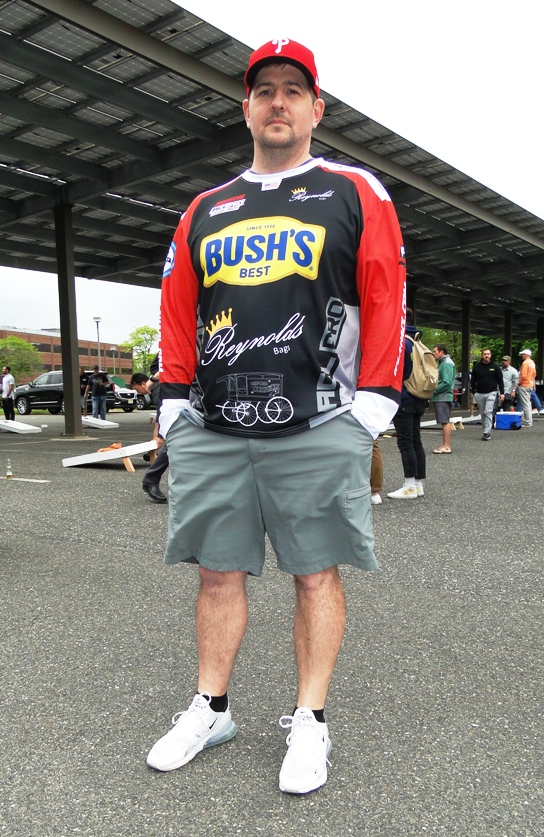
John Kitchin, who is probably better at cornhole than you.
Kitchin has been known to drive to Cincinnati for the day to throw bags. At least, that became a thing for him when someone noticed he was a pretty good shot at tailgates.
“I played in the parking lot of Eagles and Phillies games, and a guy came to me and said, ‘Hey, we have a league for this.’ I kind of laughed at him. Here I am seven years later, and if I could play more I would.”
Indeed, Kitchin started playing in a league, and did well enough to compete in local tournaments. Then he became a pro. Then an ACL Pro.
He’s added some impressive achievements to his league bio…#1 Northeast Conference player in 2018, ACL Man of The Year in 2019, and a 2nd place finish in the 2020 USA Cornhole Club Championships – broadcast on NBC Sports – to name just a few. He’s so good that Bush’s Baked Beans and LG have put their logos on his jersey.
You can see why even Ken Dunek would celebrate well beyond his typical demeanor scoring a lead against him. Which, to Kitchin and Harsh, is part of the appeal…anyone can play, even against the pros.
“I play in leagues around here all the time,” Kitchin says. “I play pretty well, but there’s a lot of people who, when they play against me, they use that as a measuring stick. I don’t beat everybody, so I think that makes them even more interested…‘That guy’s been on TV!’”
“That’s the coolest part,” Harsh adds. “You can see him on TV on the weekend, and then Monday or Tuesday night you could literally play against him.”
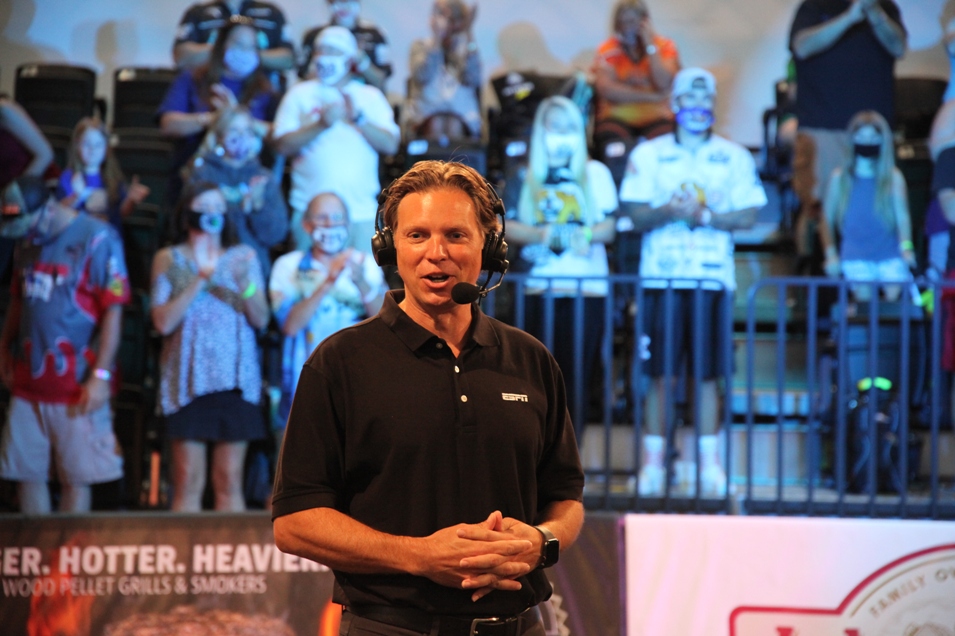
Professional Cornhole announcer Jeff McCarragher, offering his well thought out insight about a match.
(photo courtesy of Jeff McCarragher)
Jeff McCarragher is a freelance sports broadcaster. His LinkedIn profile describes his most recent position as a “Play-by-Play Announcer for College Football & Basketball…and yes, Cornhole too.” His resume covering other sports is impressive, but by most any measure, McCarragher is the Voice of American Cornhole.
He landed the gig by simply being in the right place at the right time. Literally.
A South Carolina resident, he worked college football and basketball throughout the Carolinas. Tupelo Raycom, the company that brought him announcing work, had an office there. And they knew ESPN needed a cornhole announcer.
“When COVID hit, being a freelance play-by-play broadcaster was like being a waiter or server at a restaurant,” he remembers. “We were shut down immediately because all the sports just went away. When they got the contract on ESPN, they called me and said, ‘Hey, are you willing to travel if we put together cornhole through the summer?’
“I had done a little bit for them in the past, I’d done the national college cornhole championships that previous New Year’s. I said, absolutely, I’m comfortable traveling. And so away we went, ESPN signed a deal with the American Cornhole League.”
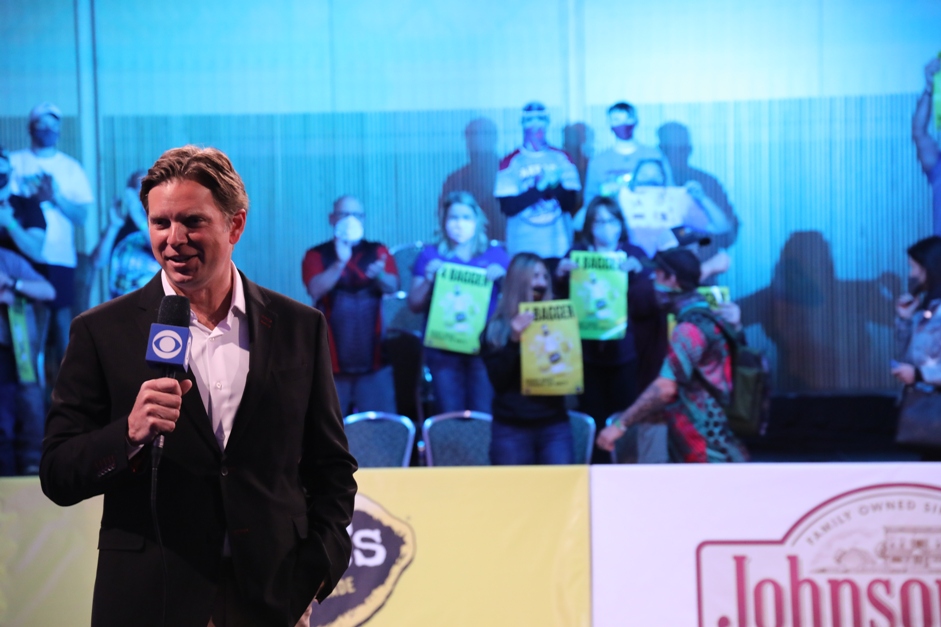
No, those aren’t protestors. They’re cornhole fans.
(photo courtesy of Jeff McCarragher)
McCarragher’s enthusiasm for covering professional cornhole of all things is palpable. The players may not have toiled through college or minor leagues, but they definitely have well-developed skills.
“It’s a very simple sport, right? You just slide it up the board and put it in the hole. But just like any other sport, when you get to a very high level, you start to learn how technical it is. I had to learn a whole new vernacular, whether it’s replacement bags or grab bags, the way a player collects the bag.
“I relate it to being a really good major league pitcher. He’s got his fastball, his slider, his cutter, his change-up. The ones who play at the top level, they’ve got a little cut shot, they’ve got an airmail shot. They can make the bag curve one way or another, they can angle it and get the bag to kind of roll. Instead of different pitches, they have different technical shots that they can throw. It’s really pretty amazing.”
There’s considerable tension in big matches, too.
“It gets to be like golf,” he continues. “You’ve got a two-stroke lead, or maybe a one stroke lead, going into the 72nd hole on Sunday. I don’t care who you are. That final tee shot on the 18th? It has to be good. There’s so much pressure. Again, I get it, it’s cornhole. We’re not talking about the Masters. But it’s still competitive, the desire to win for these players.”
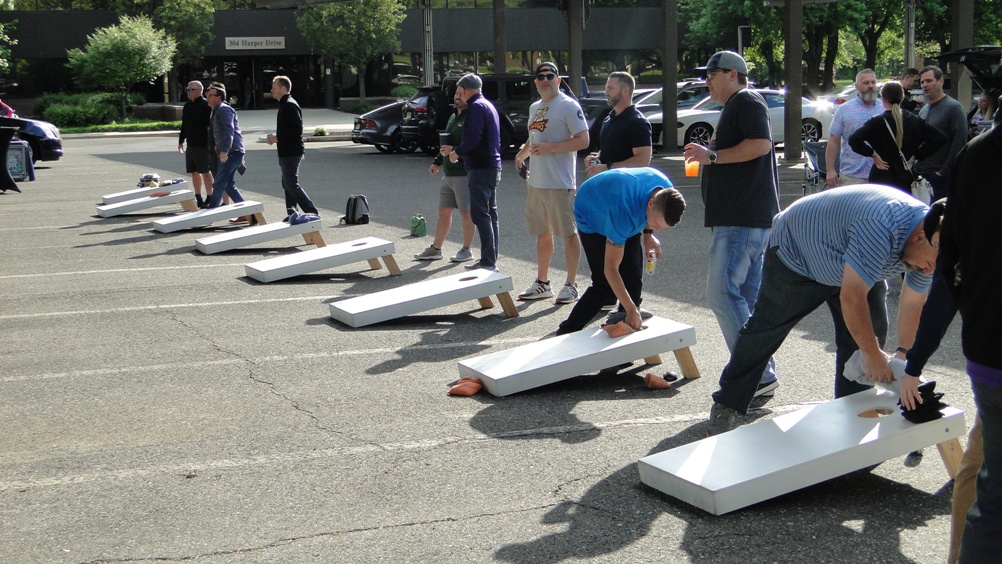
Aspiring cornhole pros at the Legacy Club event.
McCarragher is confident that the growth of professional cornhole will continue, even with the return of other spectator sports.
“Did COVID help give it added exposure? Absolutely. But I will tell you, they have been working behind the scenes with these little ESPN contracts now for several years. They were on ESPN a few times in 2018-2019. We had college national championships on New Year’s Eve going into 2020. The ratings were slowly going up and up. So this was already on the rise.
“Just by the sheer TV contracts that are coming in and new sponsors, I for sure would say that the ACL is still growing.”
Kitchin agrees.
“I think the success they had during COVID is going to allow them to continue. Will the viewership be the same? Perhaps not, but I think in this country there’s a niche for these types. Like, would you watch baseball, which is hours long, or you’re clicking through and, ‘Oh, cornhole, this is something I do in my backyard. My buddies and me bust our chops all the time, let me watch this. I think that’s what’s opened it up for those types of things.”
Joe Harsh has already experienced professional cornhole’s impact beyond TV.
“For me it’s not even the size of the events and the cool venues we’ve visited. It’s some of the charity work we’ve done, like for veterans groups. We did an interview with a guy, roadside bomb in Afghanistan. Long story short, he’s a double amputee, and he’s thanking me for everything I do, and it just absolutely blows my mind.
“I would do anything for someone like that because they’ve given so much, and they’re thanking us for what we do and the release that we give them. That’s my favorite thing to take away from all of this.”
Needless to say, McCarragher is eager to keep telling the story.
“I would love that guys would call and have me do a national college football championship. As young broadcasters coming up, we all hope to get that call. But even that being said, I still really would always hope I can continue doing cornhole.
“I will do this for as long as they’ll let me, because I love it.”
Hope you enjoyed this article about Professional Cornhole…
If you did, I would really appreciate your support.
When you use this link to shop on Amazon, you’ll help subsidize this great website…at no extra charge to you.
Thanks very much…come back soon!
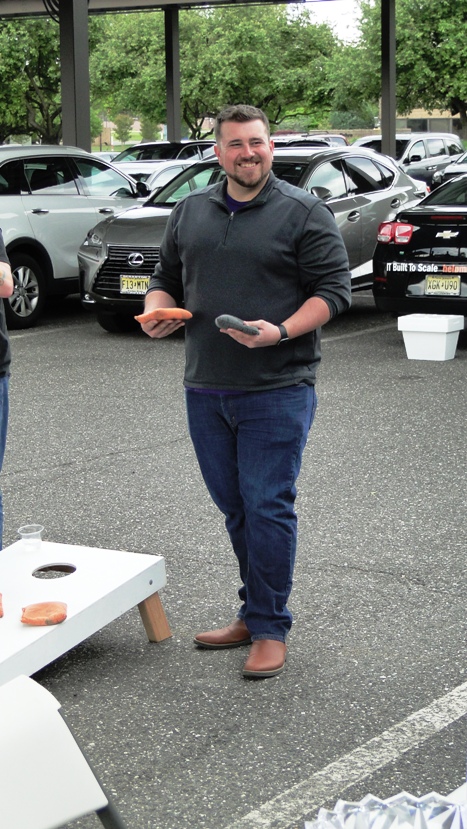
T.J. Smink, defeater of cancer and local cornhole legend.
Smink Strong
T.J. Smink, who won the Infinity Club Cornhole Event with his partner Kyle Reider, had personal reasons for both winning and co-arranging of the event: he is a cancer survivor himself.
Smink is a Senior Account Executive for Premium Seating with the Philadelphia Union. But in 2020, the shutdown of sports was the least of his worries. In December of 2019, he was diagnosed with stage four Hodgkin’s lymphoma.
He decided to control two things that he could control: his hair and his attitude. He shaved off the hair he felt he was going to lose from treatments…but ultimately didn’t. And he kept upbeat, all the time.
“I made sure to keep a positive attitude, to look on the bright side of life. Having that mindset, being able to say I’m going to beat this s***, that was way more than half the battle.”
Legacy Club member Devin DiNofa, at the time campaigning to be the Leukemia & Lymphoma Society’s Man or Woman of The Year, reached out to Smink.
“He’s an awesome dude,” Smink says. “He asked if I would be on his team to help raise money for others. Even then, he wanted to work with LLS to raise funds for me directly, LLS said we can’t go towards one specific person.
“Even then, I went back and told him, I’m killing this s***. We’re good, I appreciate it, but I would prefer it goes to someone who actually needs the funding.”
Today Smink, at DiNofa’s urging, is campaigning for the LLS Man or Woman of The Year himself. The Infinity Club Cornhole event was a part of that, to great success.
“Ash (Ashley Dunek) came up with the idea of working one of the Infinity Club events into a fundraiser. And we had a really big turnout. There were 32 teams and a lot of people that came just to hang out.
“Our team is going to get a research portfolio named after us. I’m excited to see where that research goes.”
And he and Kyle Reider topped it all with a cornhole tournament win.
“He’s a lot better than I am,” Smink says of his teammate, “but together, we normally win all of our friends’ get togethers and stuff.”
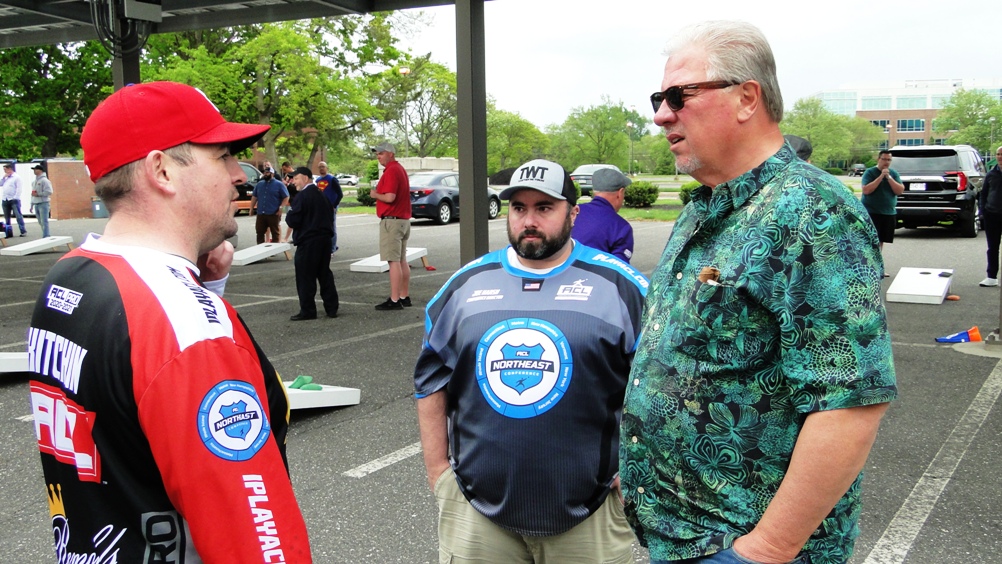
Ken Dunek, feeling relieved at the end of his match with John Kitchin, asks Kitchin for cornhole tips.
So You Want To Be A Professional Cornhole Player?
In a write-up about John Kitchin from Power Equipment Direct’s website, he is described as a professional cornhole player who “practices for roughly 32 hours per week, where he throws 2,000 to 3,000 bags.”
While that is probably technically true, Kitchin doesn’t exactly work in his garage, perfecting his follow through and stance and watching himself on video. He just plays a lot, which to him is the simple secret to improvement.
“When you figure in going to leagues and playing tournaments on the weekends, and then throwing it in my shop or something like that, the amount probably adds up. I play on the leagues on Tuesday nights and Wednesday nights, and Thursday nights usually where I try to get out too.
“If you want to become a better cornhole player,” Kitchin continues, “just get out and play, go find a local league. Even if it doubles as a night out, you know, go out and play. You’ve just got to get throws in, and if you can’t and you just throw in the backyard, go out and throw. You have to throw bags.
“So practice for a pro to me would be going out and playing in your own league and it’s all about getting throws in.”
Wait, no proper ways of holding the bag? No commentary on wrist movement? Nothing about how to warm up? Kitchin says that once you find a groove that works for you, the mental aspect is far more important. And that part can’t always be taught.
“I’m probably the worst pro to talk about this, because I’m a firm believer of under-thinking. People overthink. It’s whatever is most comfortable to you, you just have to tweak that. Throw eight bags, and I would want to see how you threw. And I would say, was that comfortable? If that’s comfortable for you, you can tweak it from there.”
That sounds simplistic, but he’s right. Cornhole players lose matches overthinking.
“I might throw 50 bags in a row in the hole, but what changes from the time that you just threw 50 bags in a row and then you line up next to me? What just changed? Nothing changed except for your mental, so you’re overthinking it. Now all of a sudden that same guy who’s just hit 50 bags in a row off to the side warming up, is now maybe two on two in. It’s the overthinking.”
“I try not to worry about all that.”

Cornhole for a cause.
Why We Cheer – The Human Interest Stories
The ACL is fortunate to have Jeff McCarragher behind the microphone, because he does what the best broadcasters do…he tells backstories about the participants.
He shared a small few everyman stories of cornhole stars with JerseyMan.
“Steven Bernacet, he won the singles national that we just had in Wichita about a month ago. Outstanding cornhole pro, but in his senior year, he was a great high school football player, lineman. He was in a horrific car accident and broke his neck. He could have died.
“The doctors immediately told him he wouldn’t play contact sports ever again, obviously to a high school kid who’s played sports his whole life, it’s devastating to him and his family. Two years later, once he was able to rehab and get back to his new normal of life, he picked up cornhole, and has been playing cornhole ever since now.
“It’s been his outlet and his happiness and his source of competitiveness, to fill that desire and that need in his life. Cornhole has been literally life changing for him.
“One of the top female pros is a manager at a Taco Bell. You know, she plays cornhole on the side. Daymon Dennis, who’s the number one player in the world right now, worked at a cheese plant for 27 years.
“He used it to support his family and to keep food on the table. And now here he is, number one player in the world.”
“It’s like American Idol,” McCarragher says. “There’s a lot of people who can sing, but what captured the audience and the ratings for American Idol is all the backstories.”

Staying Green – ex-Patriots Champion Jarvis Green

I interviewed two-time Super Bowl champion and ex-Patriots defensive end Jarvis Green for the Winter 2021 issue of BostonMan. You can read the magazine edition here, or click here to read it on BostonMan’s website. Enjoy.
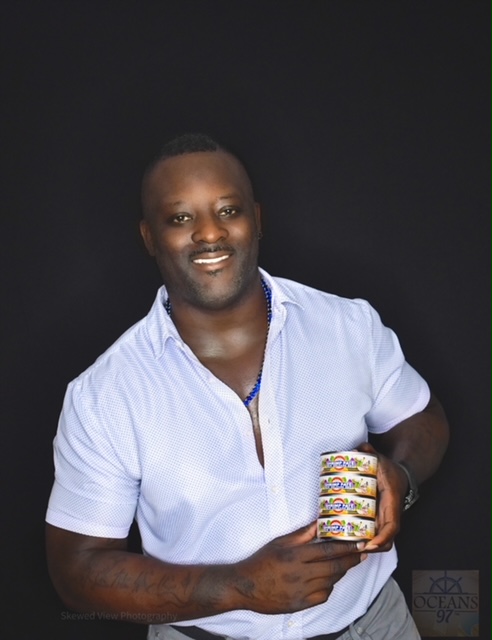
Former Patriots defensive end and 2x Super Bowl Champion Jarvis Green, with his canned shrimp pate. (photo courtesy of Jarvis Green)
Staying Green
After eight seasons with the Patriots and two Super Bowl rings, defensive end Jarvis Green is growing a business selling his superb canned shrimp pate in the New England region he loves. In the age of Covid-19, he’s managed to do pretty well meeting the needs for PPE too. BostonMan caught up with Green to talk about his football career, his successes in business, and being a part of the Patriots family.
Jarvis Green didn’t exactly part ways with Bill Belichick and the Patriots on the best of terms.
The two-time Super Bowl champion defensive end, who’d finished the 2009 season with 36 tackles and a sack, was offered a four-year extension from the Patriots. He turned it down.
The move is on his small list of regrets.
“I should have took it,” he reflects. “My sports agent, he got into it with Belichick. It was more or less, you know, you should fire your agent. I can’t get into details, but a lot of s*** happened between Belichick and Denver.”
You might not think it was the worst move on his part at the time. He was, after all, offered more money to go to Denver than many of us will make in our lifetimes. Denver isn’t an awful place to live in or to be a pro athlete. And he knew Broncos coach Josh McDaniels, the Pats’ former (and now current) offensive coordinator.
But Green, who is prone to using colorful language in an entertaining way, describes his short stint in Denver as a “s***show”.
It started out promising. After having stem cell work done on his deteriorating knee, he was having the training camp of his life.
“When I went in the off season, I was number one. When we used to practice these one-on-ones, I was the one who’d get the best guy on the Denver team. I get him lined up, I kill him! I remember calling Pepper Johnson, saying this is my best off season ever. I’m killing these guys. They can’t even keep up with me.
“I go in to training camp, I’m the sixth string D-line man. I’m like, what the hell just happened? But they knew. They saw my knee kind of tripping in film. They saw that I had something going on with my knee.”
Still, he was rightly displeased at a demotion without warning or explanation. “I got released the day before cut day. When I left, I didn’t say bye to anyone.”
After similar fruitless visits with the Browns and Texans…Green describes his three weeks in Texas as a vacation…he “limped out of the office” in Houston and retired.

Green lays a hit on Big Ben.
(photo courtesy of the New England Patriots)
Jarvis Green frequently gets asked who the leaders were in the locker room of those great Patriots teams. His answer makes clear what made Belichick’s Pats one of the great dynasties in professional sports: everyone.
“Everybody was leaders, man. I’ve been to Denver, I’ve been to Houston, everybody’s waiting for one guy to show up. In New England, we had everybody pushing, trying to get in front to say, who’s going to say this, or who’s going to do this, who’s going to make the play first.
“I remember when Junior Seau came in. It was so funny because he was a guy that wanted to be on top of the soap box and give out his three, four minutes, you know? I remember I could see the guys, we just kind of grin and give him his throne.
“That’s the type of tradition we had.”

Green can cook up some shrimp.
(photo courtesy of Jarvis Green)
Oceans 97’s Amazon entry for hickory smoked shrimp pate describes it as being keto-friendly, made with only natural ingredients, and a versatile product that can be eaten straight out of the can, or on vegetables or crackers.
There’s no mention of the dedication of Oceans 97’s founder, or a picture of his New England-famous face. You have to visit the website for that.
Being on a two-time championship squad may have pushed him to set a higher standard for himself. Maybe that’s how he stayed on that squad. But Jarvis Green is dedicated like that, and he proved it again in life after football.
He decided to go into the shrimping business as a favor to a friend. After buying a boat that he christened “Jenny”, he sang with the choir in church every weekend until a hurricane wiped out every boat but his.
Okay, that last paragraph is bunk, except for the bit about going into the shrimp business for a friend. Green is well aware of the parallels to Forrest Gump. Don’t call him Bubba. Like Forrest, Green knew nothing about the shrimp business.
Given his status as a Super Bowl champion, he could have simply lent his face, name, and uniform number to Oceans 97, the company he started.
But knowing that having his visage on a website wouldn’t improve the product’s taste, he dove deep and learned the business. The hard way. Green is a proud native of South Louisiana who knows the importance of quality food and its role in good times. He wanted his shrimp product to be the best it could be, because “people are going to create s*** all the time. It’s hard to sell s***.”
The two time champion multi-millionaire endured a six month internship in the world of shrimping. He even took on a broom and a mop in the factory. (Imagine handing a 6-foot-3, 285-pound defensive lineman a broom. Someone there has some brass ones.)
“We had a factory of like 90 people. I remember, I’m the tallest person looking across the factory. We’ve got about 50 people, peeling shrimp, eight hours, ten hours at a time. I was on that line, peeling and de-veining shrimp with my hand, and understanding that it’s a certain process, the way you procure the shrimp, you peel it, you rinse it, you freeze it, you package it. And it makes a difference, you know?
“That’s the biggest thing about having the right quality shrimp. It’s the supply chain.”
Oceans 97’s supply chain, Green confidently asserts, is “super tight”. He had landed multiple deals with local markets, and had several larger deals in place when a blasted virus changed the world. Green’s story is one of the lesser told stories about the impact of Covid…the devastating damage to businesses from lockdowns.
“I had got just approved with our Hong Kong market. Hong Kong Island, with a company called Food Wise and another 2,000-plus distributors of stores. I had that and I had another, and I’m working on some other more independent retailers in the South.
“I had that kind of set up and Covid hit. Can’t do demos anymore, Hong Kong canceled, corrections canceled, a few of the independent guys canceled because it’s a new product, right? They said we’re going to buy what we typically buy, buying a new product’s going to be kind of hard. You can’t do demos.”
Many established entrepreneurs could probably tell you a similar story. Not very many could say how they turned it all into a net gain.
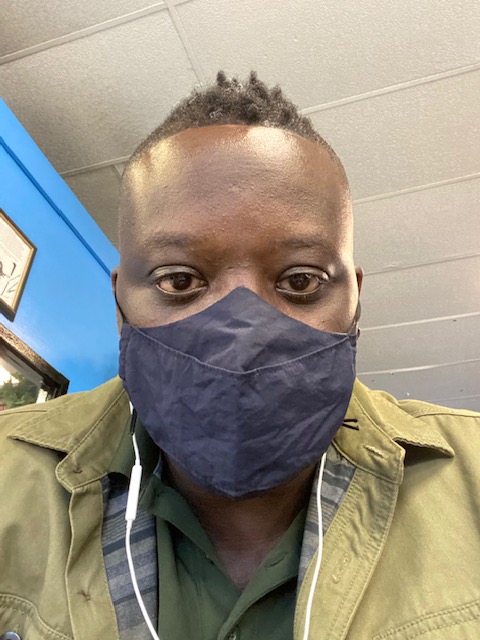
Helping you to stay safe.
(photo courtesy of Jarvis Green)
After a few of his ongoing deals fell through, including with a corrections facility in Louisiana where Green lives, he found himself in the “what now” state that so many entrepreneurs faced in 2020. That’s when the corrections facility he was working with asked him if he could supply hand sanitizer.
“Covid hit, locked down New Orleans, limit this, limit that, limit limit limit. I remember I wasn’t looking for this, but then my corrections guy was like, ‘Hey Jarvis, could you help me get some sanitizer, figure out how to get some sanitizer for the inmates?’
“I have no idea. I don’t know the first thing about sanitizer. I started doing research, calling some people. A friend of mine had another friend, he knew someone who had some spirits company in the mountain, west, whatever area. I helped my guy with some stuff in the corrections.
“I started looking into some stuff, and I won a bid with the state of Louisiana for sanitizer. I won some masks bids with Louisiana, and then I won a huge proposal deal with the Tennessee National Guard.
“I won the bids, made a ton of money. I made more money in those two months than I made with my shrimp business in the last five years. You can put that on paper. It’s just been crazy and I’m still doing that now.”
They may be wholly unrelated businesses, but Green credits his education in the shrimping business “big time” for his success in the world of PPE distribution.
“The biggest thing is about being patient and to find the deals, because every deal’s not for you. I’ve lost some great friends, because everybody’s playing octopus and has got ten different deals that they thought were real and weren’t real at all.
“I got my counsel involved, and I separated from all the different deals. I stopped dealing with all of these agents and buyers. We started working with the factories in China directly. The biggest thing right now is price gouging. The things we’re selling, we’re not price gouging, and we’re selling a competitive product through great sources.
“This is what I tell people. When I got into the shrimp business, it taught me how to understand international trade, international business. Dealing with different companies, dealing with banks, understanding LCs and different jargon, just to get business done abroad.”

Just as tough in a red shirt.
(photo courtesy of the New England Patriots)
Throughout his football career, Jarvis Green dealt with severely debilitating back pain. Even to this day, he says, he is strongly encouraged to have back surgery.
“My spine doctor, they call me twice a year. In 2014, they wanted to rush and give me surgery. They wanted to give me fusion, L3, L5 fusion, six points, all this bulls***.
“I didn’t want to do it, because my Dad had 17 back surgeries. He shakes like a leaf. He’s a veteran, he has a wheelchair. He has all kinds of s***, he broke his back with a job back in ‘79.
“My dad always said, I don’t care what you have to do. Don’t ever let anybody touch your back. Deal with the pain, it’s going to be much better than going through surgery because you’ll never be the same person again.”
Green deals with the pain, through highs and lows on the football field, in business, and in his personal life. Today, of all his considerable accomplishments, he is proudest that he’s still the same guy.
He unexpectedly learned that the local football team, with whom he went to the top of the mountain twice, felt the same way about him.
After some years of hard feelings, Green is currently an ambassador with the Patriots again, making appearances and occasionally going on trips with the club.
Mending the broken fences following his contentious departure, it turned out, wasn’t as difficult as he thought.
“It took three years for that to happen,” he says. “The Patriots were playing the Saints. Home game for the Patriots, right? I went to the game, I had the throwback jersey on, #97. I’m just a fan, I bought my ticket. I just went to the game, enjoyed myself and went home.
“So I’m thinking this just the way it is when you retire, they don’t give a s*** about anybody. That was my mentality, right?
“I’m in the stands, and they caught my picture on the Jumbotron when I was eating popcorn. Before that, I heard people behind me saying, why’s this guy got a Jarvis Green jersey on? They didn’t know who I was. After that, people come to me asking for autographs.
“I got a call from Pepper Johnson, or a text. He said, ‘Hey, what are you doing? You at the stadium?’ And then somebody said, hey, they want you to come down into the operations the next day.
“This is three years apart from the beef, you know, the Belichick situation, me and my sports agent, going to Denver, getting cut, all this s***. And I’m like nervous as hell. Won two Super Bowls with this team, now nervous as hell. I remember walking in and right when I walked in, I think I saw Tom first.
“I was there for like two and a half hours, just going through, saying hey to everybody. I remember talking to Josh in the cafeteria, just me and him at the table. Just saying, it’s business, things happen, back was against the wall, do what he had to do and pretty much a shake and a hug.
“It was very emotional, seeing all those guys. You know, eight years is a long time in the football world to be under one team, one organization. I appreciate Coach Belichick, to let me come in there.
“That’s kind of how everything got back. You know, they say, hey, you’re okay.”
In the interview for BostonMan, Green speaks slowest and pauses the most when speaking of his former coach’s words to him that day.
“Now this was the biggest part. After I was leaving, I’m walking out, drowning some of my tears. Belichick walks out, he says, ‘Hey Jarvis, remember, you’re always gonna be family here. You were a part of all of this.’
“He said, ‘Never be a stranger. You’re family.’”
Did this post about Jarvis Green make your day a little bit?
I hope so. If it did, I would really appreciate your support.
When you use this link to shop on Amazon, you’ll help subsidize this great website…at no extra charge to you.
Thanks very much…come back soon!
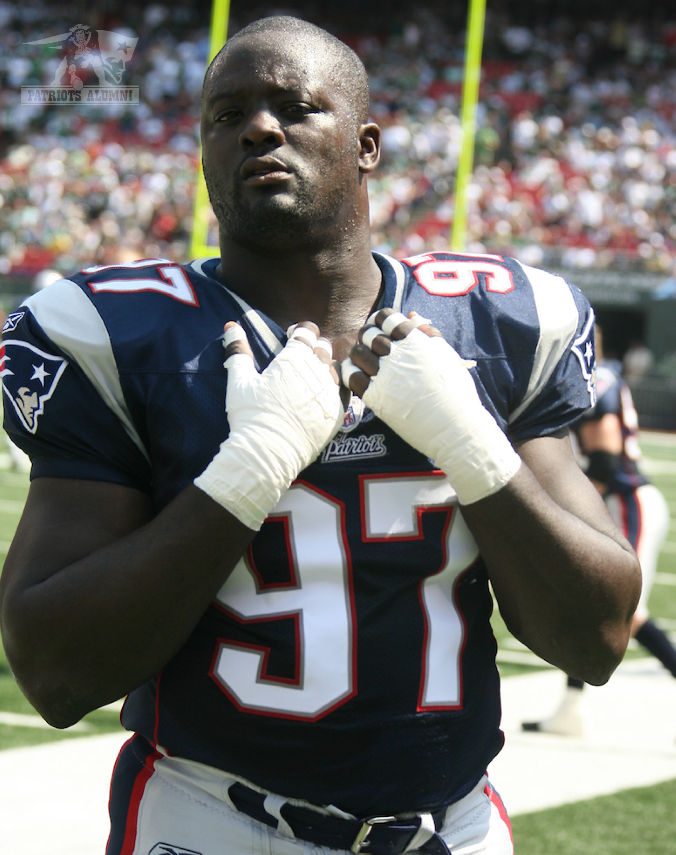
A part of Super Bowl history.
(photo courtesy of the New England Patriots)
Jarvis Green on The Helmet Catch Play
You probably remember the Pats’ undefeated season of 2007. You may remember Jarvis Green on that invincible squad. You might have to read his Wikipedia entry, though, to know that he was one of several Patriots who had Eli Manning in his grasp on the “Helmet Catch” play in Super Bowl XLII. Green nearly tore off Manning’s jersey, but the Giant QB got away and fired a Hail Mary pass to David Tyree. You know the rest.
It was hardly the ground ball dribbling through Buckner’s legs, or the 7-20 September collapse of 2011. The New England sports fan faithful have dealt with far worse as season ending falters go. Even Manning called it “the luckiest play in NFL history”, joking that it went exactly how they scripted it in practices.
Green doesn’t think about it much these days. But it did cost him sleep for a couple of weeks. Because leading up to that play, he’d played a hell of a game.
“It could have probably changed my life. I’m like, it was like third and seven, I should have been the guy saying ‘I’m going to Disney World!’ You know, because I remember that game, I had a sack and maybe seven tackles or five tackles. That would have ended the game, that would have been icing on the cake.
“I think for the guys who really played, it’s not something that we really talked about at the time, it’s more friends because the family don’t bring it up. It’s more the friends, you know, everybody wants to get a one-up on you.
“So it’s always comedy time, you know, for everyone except me.”
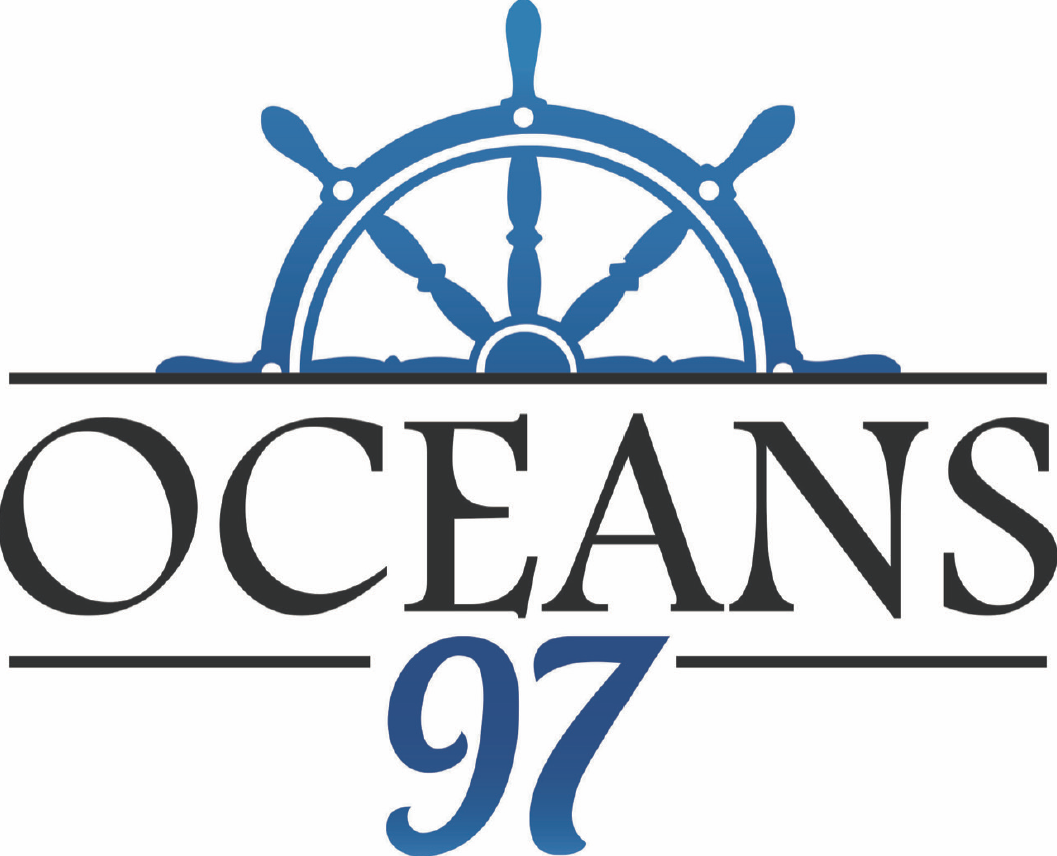
Oceans 97, with first class shrimp pate.
(image courtesy of Jarvis Green)
Canned Shrimp Pate – From A Man Who Knows Shrimp
BostonMan is hoping that Jarvis Green can make it to a future Legacy Club gathering, because his Oceans 97 shrimp pate will be a great addition to the already excellent finger foods usually available at our events.
But for now, you can find it in 150 specialty retailers, strategic restaurant partners and on Amazon.
Green’s canned shrimp pate is available in five varieties: Hickory Smoked, Creamy Lemon, Shrimp Rillettes, New Orleans BBQ, and Jalapeno Chili. On the Oceans 97 website, there’s a brief description of each flavor…for Creamy Lemon, it explains the presence of vinegar:
“It is the Gem that interacts with shrimp protein, water and milk. It also alters the texture and consistency making the Creamy Lemon Paté unique from the other flavors. Vinegar is a tenderizer.”
Spoken like a football great who knows his food. And he does. Green also offers several recipes on the website that make the best use of the shrimp pate, including a corn bread recipe that includes a can of the New Orleans BBQ edition. Just the pictures of the corn bread may make you start planning your next dinner gathering.
The website is www.ocean97.com.

Making food on date night better.
(image courtesy of Jarvis Green)
Bringing The Chefs To You
Food delivery has become enormously popular. Restaurant chains have focused on apps to help customers continue to enjoy their eats, through pickup or delivery.
There’s just one problem, as Jarvis Green points out.
“Everybody knows the menu of Burger King, McDonald’s, Chipotle, Domino’s Pizza. That gets old.”
Great point. It might be nice to be able to find chefs in the area, and enjoy a decent meal for a change.
Green and his partner, Eddie Rhodman Jr. of Rhodman Enterprises, are part of a team producing a new app that does just that. With Chef2U, you can find a local chef to make an amazing meal for you, delivered to your home.
“If you’re tired of eating Big Macs and Little Caesars, you could go in and see the chefs in your area. It’s like an eight to ten mile radius. Then if you want like Mediterranean food, that’s going to pop up, but it will be the chef’s face. It won’t be the name of the local restaurant, but his face.”
It also offers chefs a much-needed chance to supplement their incomes.
“The app has food trucks, bartenders, baristas, chefs, catering, meal prep, and instant meals. It’s very detailed. There’s so many opportunities to get private chefs back into and create diversity in this industry.”
Green expects Chef2U to outlast the pandemic.
“This is built to stay, because again, we will not be competing with traditional fast food chains. We’re going to be giving all those chefs, entrepreneurs, restaurateurs, a chance to make money on the side.”
Rhodman adds that Chef2U gives aspiring chefs “the opportunity to create their own brand, their own customer base, because they haven’t been given the opportunity. It will give them the freedom to expand their brand and have the unique luxury to deliver their personal chef experience directly to a customer’s home.”
Jarvis Green and Eddie Rhodman expect Chef2U to be available in April. If you have favorite Beantown chefs, make a note to get the app. It’ll make for a great date night or family night.
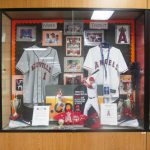
Jerseyball – Millville’s Mike Trout and Aaron Cox

Aaron Cox, Millville area baseball star and best friend of MLB superstar Mike Trout, was drafted by the Angels in 2015. JerseyMan sent me to interview Cox for the Spring 2015 issue, and talk a little bit about his baseball superstar buddy too, for the Spring issue. You can view the PDF of the article here.
Sadly, Aaron Cox passed away in 2018 at the age of 24. I was devastated to hear that. He was a really nice kid and a great interview. R.I.P. Aaron.

Jerseyball
Baseball’s best player is from a small town in South Jersey, and his high school buddy has just been drafted by the Angels. The two friends are still just Jersey kids.
On a baseball field, Aaron Cox has shown an uncanny ability to focus on the task at hand.
Even if that task is, say, pitching a no-hitter on his school’s Opening Day.
How focused was the Gannon University ace in shutting down opposing bats? He didn’t even know he was firing blanks until his team swarmed him after the victory.
“My teammates ran out of the dugout like we won the World Series,” Cox says. “And I was like, this is the first game of the season, what’s going on here? ‘You just threw a no-hitter!’
“I don’t know if it would have jinxed me if I started thinking about it or not. But it worked out.”
That story must be embellished, you think. Most of us would be aware if we were pitching a no-no in a backyard wiffle ball game.
Well, the Millville High alumnus had an additional distraction. He had to help his cause on offense. Cox was one of those multi-tool players that could hit, too.
“It was a tight game. I didn’t come into the dugout and think about what I had to do next on the mound. I was just as much in the game on the offensive side, so I think that was the biggest thing that kept me from realizing it.”
He has that mentality that coaches long for in a player. “I just wanted to get the win,” he shrugs.

Millville star pitcher Aaron Cox, shortly after being drafted by the Angels.
Cox has a future in baseball. The young power arm has shown enough promise to be selected by the Anaheim Angels in the 19th round of this year’s draft.
It’s a fairly deep pick to assume that he’ll be on the mound at Angel Stadium anytime soon, but he’s already gone to work improving his chances. He’s ditched the hitting and expanded his pitch repertoire. According to his scouting report, his fastball touches 96, his slider has a big break, and he’s developing a change-up. If he can learn to throw all three for strikes at any time, he could turn out pretty nasty. The Inside The Halos blog mused that he could be a “quiet steal”.
A three-time All-Conference selection in high school. Ace of his high school and college staffs. The single season strikeout leader at his university—breaking his own record. A no-hitter to his credit. Now in the Angels farm system.
Not bad for a small town South Jersey kid. In fact, Cox was the best ballplayer to graduate from Millville High in, well, about three years.
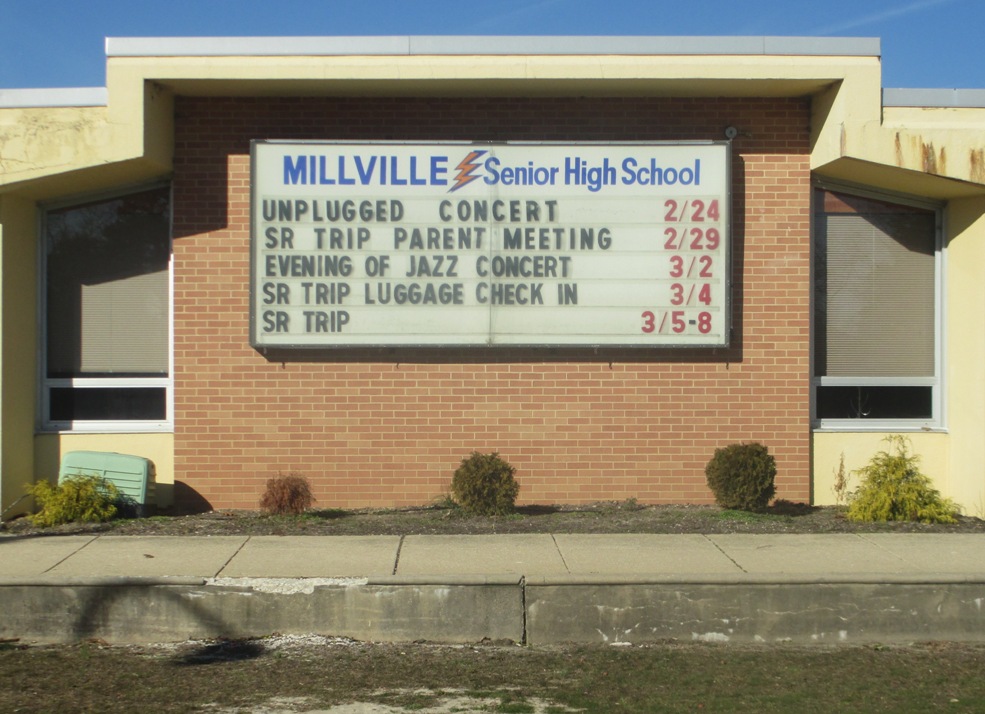
Millville High School, home of star baseball players and jazz night.
You’ve probably heard of Millville. Especially if you’re a baseball fan. The town produced a ballplayer that now plays outfield for those Angels, a player whose nickname is “The Millville Meteor”.
You could say he’s pretty good. A .304 lifetime batting average. Led the league in RBIs in one season and in stolen bases in another. He’s been an All-Star in every season that he’s played. He’s also undefeated in winning Silver Slugger Awards. He was the American League MVP in 2014 and hasn’t yet finished lower than second in MVP voting…a guy named Cabrera had to win a Triple Crown to overtake him in 2012. At just 24 years old, he’s already clouted 139 home runs. He’s no slouch with a glove, either…YouTube has a few pages of videos of his negating pitcher mistakes with awe-inspiring catches.
You’ve heard of that WAR statistic? “Wins Above Replacement”? That all-encompassing number that no one understands but is supposed to define a player’s ultimate worth? Without a deep explanation (we have space limitations, but you probably know the depth to which statisticians go in baseball), FanGraphs states that he’s been worth more in Wins Above Replacement by age 23 than any other player in the history of the game.
Oh, and online voters on Topps’ website just named his baseball card to be #1 in the 2016 series. Collectors know. The stats are, after all, right there on the back of the cards.
So yeah, maybe he’s better than pretty good. He’s really, really good. Ludicrous good. Schizoid good. The phrase “best baseball player on Earth” is used to describe him fairly often, and it doesn’t lend itself to much argument.
Here’s how big a superstar Mike Trout is.
In the early weeks of spring training, there isn’t much to write about other than overly optimistic quotes from players and managers about the coming season. So blogs and websites looking for traffic need attention-grabbing headlines.
Maybe something like “Should the Angels trade Mike Trout”?
Yes, they said it. And believe it or not, there is a case to be made, however absurd the notion may seem. The Angels, you see, don’t have much of a farm system. ESPN writer Keith Law not only ranks it dead last among 30 teams, he says it’s the worst he’s ever seen. The team badly needs a future, so writers publicly ponder the sacrifices they’ll need to make. Or at least speculate a scenario that generates a must-click headline.
In response to the sudden wormhole in the baseball space-time continuum caused by the notion of a Trout deal, Grant Brisbee from SB Nation wrote a column with this headline: “The Angels Will Never, Ever, Ever, Ever, Ever Trade Mike Trout”. Yes, four “evers”. Here’s the quote from that article that best explains why: “It’s like selling a Honus Wagner card on the playground. Even if the 7-year-olds empty out their toy chests and video game collections, you’re still not going to be happy with the return.”
One can imagine going back in time to 1918 and reading a newspaper story with the headline “Should the Red Sox trade Babe Ruth?” Or even going back to 1991 and reading, “Should the Orioles trade Cal Ripken?” GMs who value their ability to avoid being hung in effigy know better.
“We like our chances” = zero traffic. “Trade Mike Trout” = web firestorm. Mission accomplished.

The possibility of meeting Mike Trout, and inexpensive ham and cabbage!
How does a mega-superstar from a town of 28,000 adjust to skyrocketing fame and wealth beyond recognition? By all accounts of those who know him, you wouldn’t even know the difference. The word “humble” is thrown around so reflexively that it’s almost his unofficial first name.
It’s remarkably difficult to find a Millville resident who doesn’t know Mike Trout personally. At the counter at Jim’s Lunch, the iconic 93-year-old Main Street diner, waitresses and customers all still refer to him as simply Mike, or even Mikey. As if he were a regular at the diner, which he still is, rather than the greatest baseball player in the known universe.
It’s the same at Millville High, where coaches and athletic directors talk about his senior year and the scouts regularly visiting town. The longtime baseball coach, Roy Hallenbeck, clearly has experience with journalists. He shows Trout’s locker, inspirational signs in the locker room, and the glass enclosure that displays his jersey and other gear. He has a picture of the scoreboard sign on the baseball field…now “Mike Trout Field” after Trout contributed to a renovation…stored on his phone ready to be texted. Like everyone else, Coach has nothing but praise for the local star.
It’s almost as if the townsfolk gather together to get their story straight about Millville’s most famous son for whenever reporters visit. But you know it’s real. Best case in point: the 2014 AL MVP is worth over $100 million now, and he’s still dating his high school sweetheart…who happens to be Aaron Cox’s sister.
Mike and Aaron are close, and the younger prodigy doesn’t dispute any of the hometown accolades for his mentor and friend.
“As long as I’ve known him, since he was a freshman in high school, he’s never taken anything for granted. Whenever I have a question I go to him, and we’ll sit down and talk. Whenever I need him, he’s there. In the off season he likes to be with friends and be a kid again. If you ever hung around him, he is a kid, trust me.”
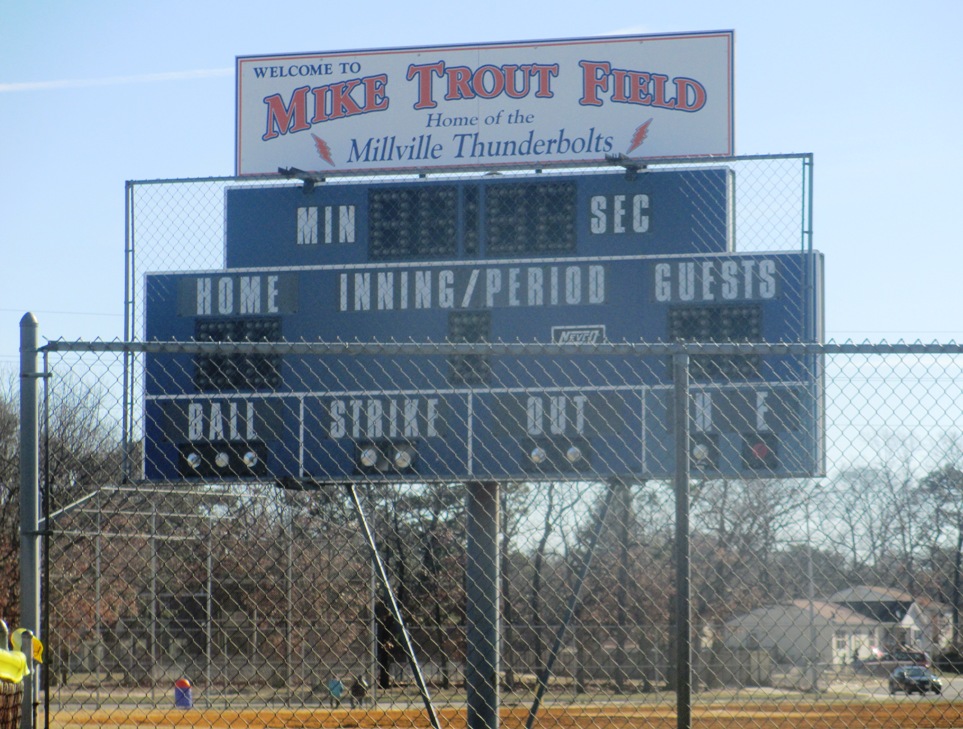
Named for Millville’s most famous son.
Hallenbeck laughs at the humility attribute so frequently ascribed to Trout. The coach was quoted in an MLB.com article referring to Trout as a “killer”. He means it as a very flattering joke.
“To be clear about that, he really is a humble kid. He truly does appreciate everything he has. Just don’t compete against him, because it isn’t going to work out well for you…if you’re playing golf with him, or if you’re playing pickup basketball, or if you go bowling with him, he is going to beat you.
“I still have visions of him leading off of second base, just absolutely terrorizing pitchers. Not that he was doing anything demonstrative, just that he was so good, and so aggressive, and so competitive, everyone just knew he was gonna go and that they couldn’t stop him.”
Cox shares a story about the killer. “Out of the blue one day, we said, let’s go bowling. That was a month ago, and I think we went 25 times in the past month. I was better than him at first, and he didn’t like me beating him. We just kept going back, and now the guy at the bowling alley doesn’t make us pay because we come there so much. He has lanes reserved for us.
“It’s fun, because he’ll stick with something until he’s better than you at it. And I won’t let that happen!”
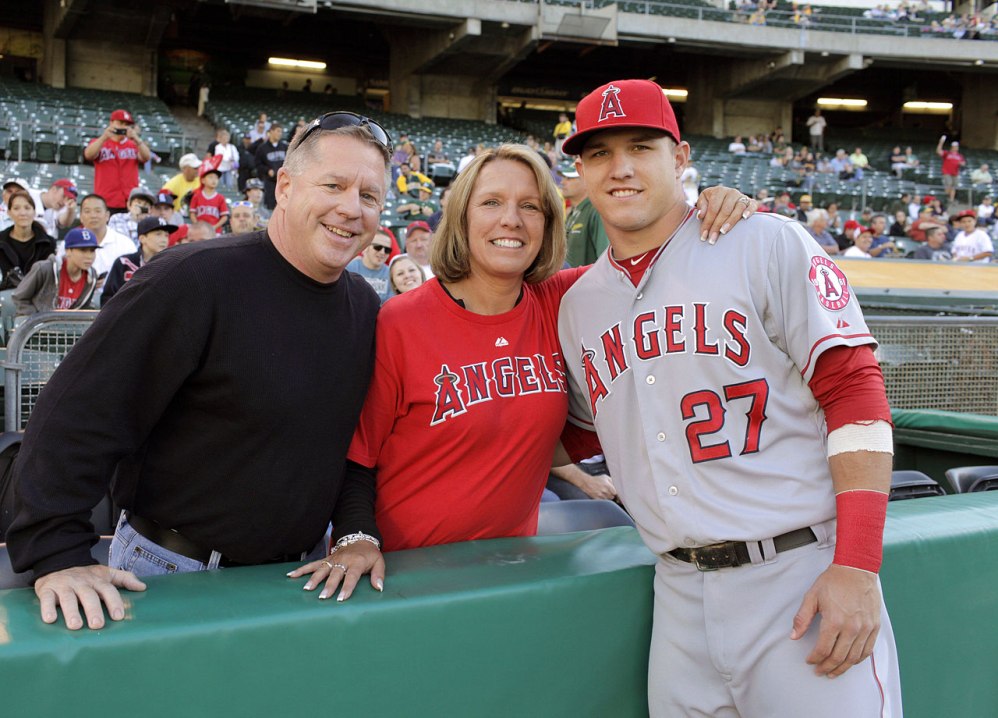
Dad was a pretty good ballplayer himself.
(photo courtesy of Orange County Gentlemen’s Guide.)
The trademark humility may come from being raised in a small town…or in a state with no shortage of people who will gladly bring you back to earth. The killer mentality probably comes from a father who scratched for every hit as a ballplayer himself.
Jeff Trout’s baseball career ended where the overwhelming majority of them do…in the minor leagues, where players are either shown to be insufficiently skilled or made so by increasing bodily wear and tear. Drafted by the Twins in 1983, Jeff played four years in the minors as a second baseman, hitting .321 in his last season in Orlando before finally growing weary of waiting for a promotion from the Twins. With a torn plantar fascia and worsening knees, Trout gave up baseball to raise a family.
The elder Trout doesn’t hold a grudge. He’s admitted to his defensive inadequacies in interviews, and at 5’9”, his size was probably a handicap too. He succeeded as a hitter, to a point, through guile and scrappy dedication.
Cox testifies to how Jeff instilled a work ethic in young Mike. “His dad would make him hit every night, do push-ups, do everything, eat the right things. He may have gotten by on just talent, because he was blessed with a lot of talent. But he wouldn’t be where he is today, how good he is right now, if he didn’t have the work ethic that he has.”
Jeff also learned Mike about dwelling on failure, as he once did. He told Ben Lindbergh at Grantland that “I really, really overthought the game at times…some of the things I struggled with I tried to give to Mike and teach him that’s not the way it should be done. He can shake a bad game off.”
No one can better teach a youngster how difficult baseball is, or how to appreciate God-given talent, than a player whose dream died in AA. Thanks partly to his father, Mike Trout is baseball savvy enough to stay grounded and determined.
Because as even Babe Ruth learned, sooner or later the game will humble everyone.
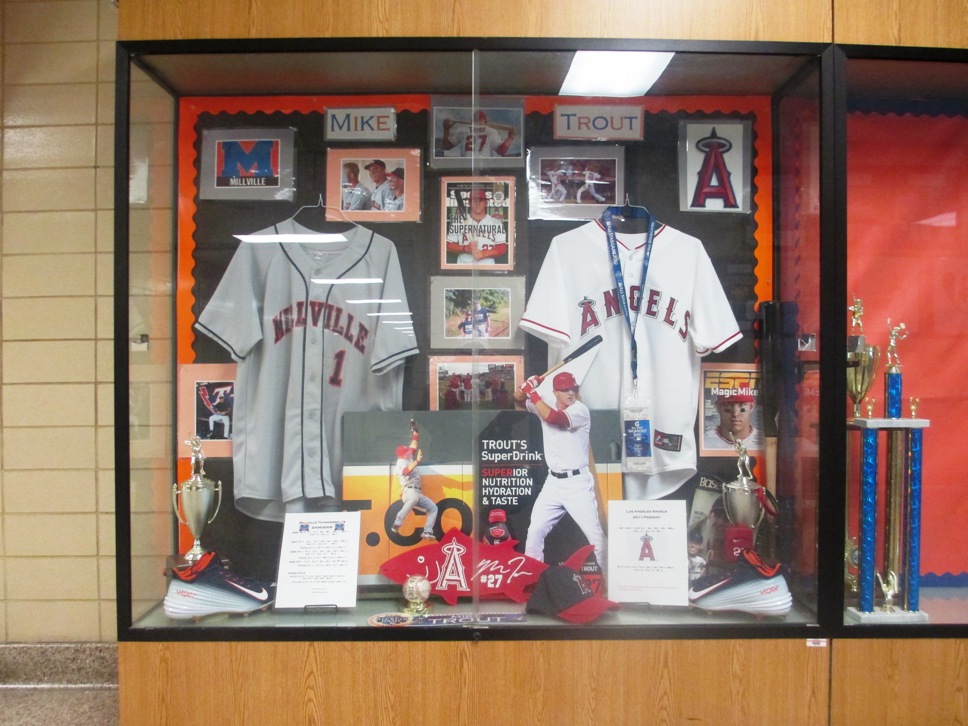
The display at Millville High celebrating its superstar ballplayer.
As Dave Lagamba, the athletic director at Millville High, shows this observer around the school grounds, he briefly chats with a groundskeeper about fixes needed to get Mike Trout Field ready for the coming season.
It’s a sudden reminder of what should be obvious…that Millville isn’t Mike Trout Central, or even Mike Trout Sideshow. Not even baseball’s biggest star can fix the town’s struggling economic conditions. Like in any other town, people go to work and raise their families and live their lives. As proud of the All-Star as Millville is, he and the locals still treat each other the same.
Of course he’s the same humble guy. Why wouldn’t a kid from a South Jersey small town be? All the money and fame one could ask for doesn’t change who someone’s parents are, the town they grew up in, their favorite food or who their high school influences were.
On a major league baseball field, there’s no denying that there’s something special and unique about the Millville Meteor. He plays baseball like a very small number of humans can. But back home, Mikey will likely always remain a guy who spends his spare time hunting and golfing with his buddies, challenging them to yet another round at the local lanes.
It’s not hard at all to imagine Mike Trout being enshrined in Cooperstown someday.
Or celebrating his induction with a burger at Jim’s.
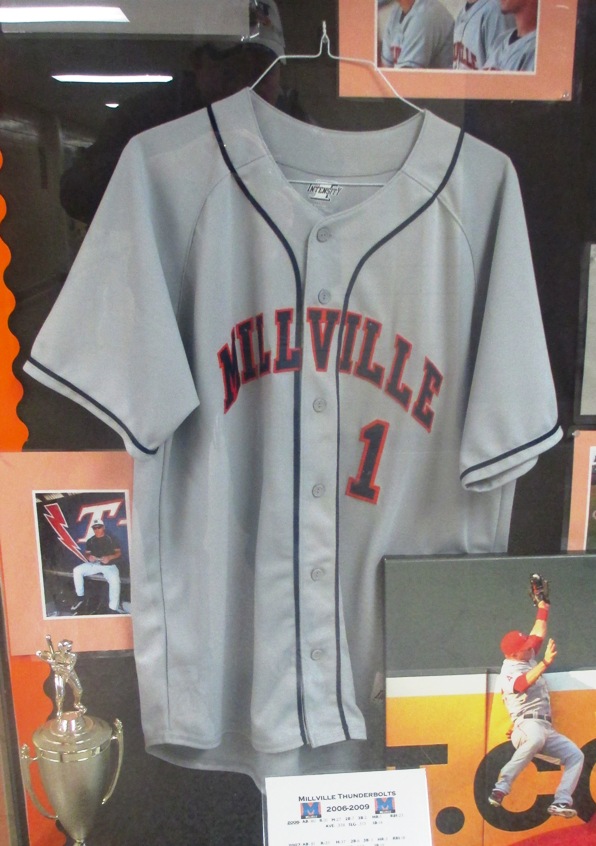
Mike Trout’s #1 jersey, now worn by the team’s MVP.
The Jersey
College and minor league teams have been known to retire the numbers of major league greats, but Millville High decided on a better way to honor their greatest player…by using his #1 jersey as a motivator. Trout was asked what they wanted to do with the jersey, and according to Roy Hallenbeck, he gave his stock answer: “Coach, whatever you think is best.”
The #1 jersey is now awarded to the player best seen as the team leader…not necessarily the best player, but the player coaches want other players to look up to…someone who works hard, hustles, and stays grounded. The first player to wear the jersey after Trout’s departure? Aaron Cox, by winning the championship final against Lenape High.
Hallenbeck tells the story. “My assistant coach, Kenny Williams, said to Aaron, you win this game and we will give you the #1. Aaron was like, don’t you think you should check with Coach? Kenny said, don’t worry about it, I’ll take care of it.”
It was no easy ride. Cox gave up a three run shot in the first but then blanked Lenape the rest of the way. “That Lenape team that we beat was just loaded,” Hallenbeck says. “They jumped on us early, and Aaron settled in the rest of the way. One of the most exciting games I’ve ever been a part of. That could have gotten away from Aaron. And it didn’t.
“We talk to our guys about leaving a legacy here, be that guy that we’re gonna refer to years after you’re gone. And we refer to that a lot. He absolutely earned the jersey that day, without a doubt.”
The “Millville Meteor”?
If you’re wondering how the nickname “The Millville Meteor” got attached to Mike Trout enough to be listed on his Wikipedia page, it’s probably because you’re not old enough to remember Mickey Mantle’s playing days. Don’t feel bad; most of us aren’t. This author’s father never even made the connection, and Mantle was his hero.
Mantle was and still is far more popularly known as “The Mick”, but he was also sometimes called the “Commerce Comet”, for his hometown of Commerce, Oklahoma. The nickname was probably a nod to his running speed…something fans don’t always notice right away when a player can jack a ball 500 feet. In his autobiography, Mantle quoted Ted Williams as saying “If I could run like that son of a bitch, I’d hit .400 every year.”
Like Mike Trout, Mantle set the baseball world on fire early in his career with both his crushing bat and blazing speed on the basepaths, and like Trout, Mantle was from a small town whose notoriety quickly became about a baseball star.
So the “Millville Meteor” nickname, see, is a tribute to The Commerce Comet…another speedy power-hitting outfielder who was considered among the best of his generation.
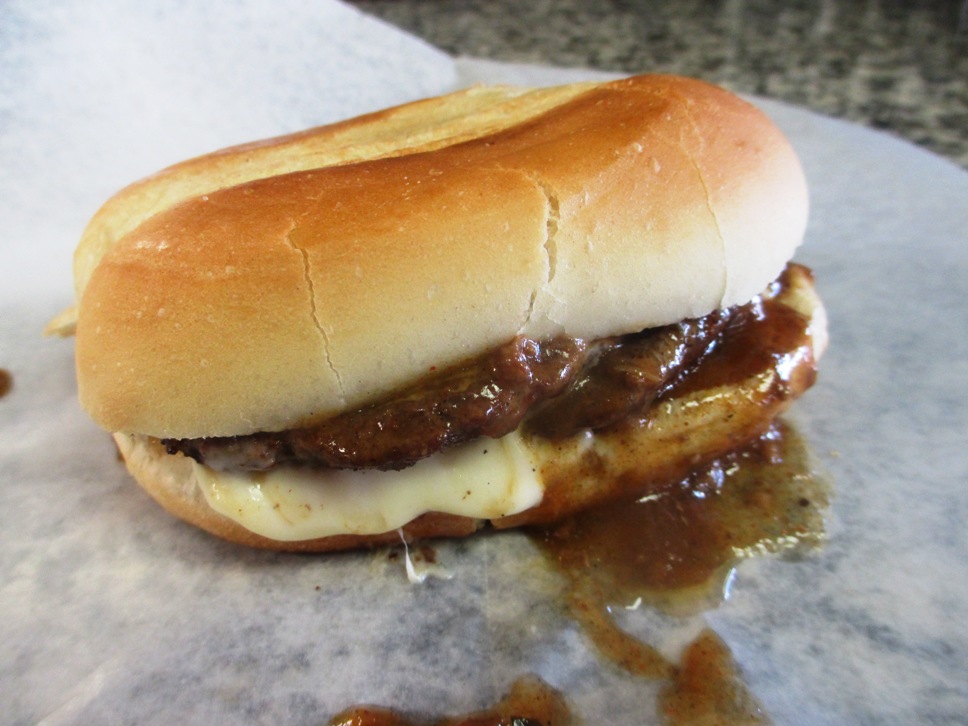
The best burgers in Millville. Just ask Mike Trout.
Jim’s Lunch – Millville’s Other Great Institution
If you’re doing the Mike Trout Millville Tour, be sure to stop at Jim’s Lunch, the Main Street diner that has been serving locals for nearly a century. It’s still today a favorite of the Trout family, and the waitresses and customers know them well.
There’s some memorabilia, but the restaurant is thriving on the special sauce that is constantly being slathered on burgers, not the connection to the MVP. As one customer puts it, “They come here for Trout, they stay for the sauce.” It’s somewhere between chili and gravy, but not too close to either. The owners refuse to sell it in jars, lest anyone figure out the secret recipe.
Jim’s is perfect for Millville…an inexpensive, venerable, character-filled diner in the heart of an economically struggling town. Trout still frequents Jim’s in the offseason, and he’s been known to down six burgers in one sitting. (The burgers aren’t mammoth, but six still seems like a lot.) Burgers are even served on wax paper…as authentic as diner food gets.
Jim’s is no slouch in food quality, especially in a state where diners are barely distinguishable from one another. Not only is the secret sauce addicting, the home fries and Nana Rochelle’s caramel apple pie both perform well above expectations. Patrons will tell you that you can’t go wrong with anything.
Rochelle Maul, the owner, tells the story of Mike Trout’s first appearance at Jim’s…as an infant. Debbie Trout proudly showed her new son to the waitresses, calling him ‘our little Angel’. “True story,” Rochelle says with a smile, “and here he is playing for the Angels.”
When asked if she’s relieved that Debbie didn’t call Mike “our little Yankee”, Rochelle laughs and nods.
Unfortunately, you can’t stop at Jim’s on the way to Wildwood in the summer…it’s a longtime tradition that the owners take summers off. But an offseason trip is still worth it.
Photo credit: IDSportsPhoto on Best Running / CC BY-SA
Photo credit: IDSportsPhoto on Best Running / CC BY-SA

